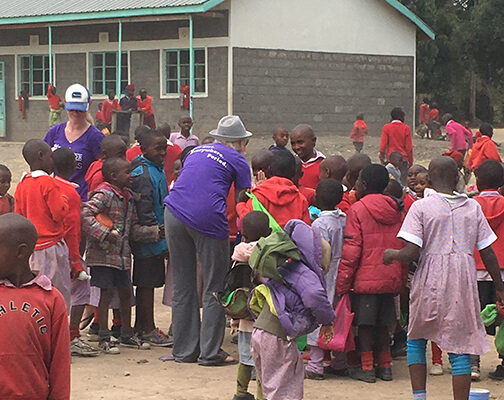
Posted in Kenya on June 7, 2023
1 June 2023
I really didn’t think that President Joe Biden would impact our trip, but our day of travel started with a traffic jam caused by his motorcade on Interstate 25 through Colorado Springs. Biden was the scheduled speaker at the 2023 graduation ceremony for the US Air Force Academy in Colorado Springs. I had arranged for an Uber pickup at 08:40 am this morning, passing by Margaret Cordova’s house in downtown and then taking us to the airport for our flights. Fifteen minutes before the scheduled arrival of our driver, I noticed that she wasn’t moving on the Uber map displayed on my cell phone app. She didn’t move for 15 more minutes. She messaged us that traffic was at a standstill and that she was stuck in gridlock–several interchanges along the highway were blockaded for the President’s motorcade and that, coupled with what appeared to be a few small fender-benders had paralyzed any intersections near our house that would allow our driver to get to our house.
I texted Margaret and told her that she probably should make other arrangements since her flight left before us at 10:30am, traveling through Dallas then London-Heathrow on her way to Nairobi. Our flight was set to leave at 11:20am.
Margaret called another Uber and, at 9:00, we canceled ours and loaded our bags into my Honda Civic that would now be parked in long-term parking–more expensive than our one-way Uber and son picking us up upon return. (He couldn’t take us to the airport today because he was traveling out of town, too)
WAZE was able to direct us around the traffic without incident easily and we arrived at the airport in time to meet Margaret at her gate and relax for about 30 minutes at ours.
This trip had been planned in some form or fashion since before CoVID hit. Originally scheduled for Peru with a follow-on Inca Trail Trek in June of 2019, we had canceled the trip in late February of that year. We rescheduled for June 2023, but then when civil unrest hit Peru in January and February of this year, Joy Demsey and DWC asked if I would reconsider that trip and reschedule it for Kenya in the same timeframe. While we were disappointed to miss out on Peru and a work project in Lima, the trip to Kenya sounded intriguing.
A few of our friends that had planned to go to Peru with us rescheduled for Kenya and others joined us through the DWC site. Ultimately, we would be 10 on the team going to Naro Moru, about three hour’s from Nairbobi.
About a month ago, we met our in-country trip leader, Nderitu Wanjau, for lunch in the Denver area about an hour drive from our house. We were impressed with his plan for the trip, understanding of DWC’s mission, and ability to answer our questions. We relayed all of his information to the group via email and it served to augment the info already provided by DWC through our trip briefing that we did by video call in early May.
Briefly, our project would be to assist in the construction of a new school in a village about an hour’s drive from Naro Moru and our lodge. Ground had been broken on the school earlier in May and we were all anxious to see in what way we could assist in the construction.
Becky, Margaret, Charles, and I were all scheduled to arrive in Nairobi on Friday evening, 2 June. Charles was already touring in Africa having completed a trek to Botswana with Intrepid Travel. Margaret would be flying from Colorado Springs through Dallas and Heathrow arriving at about the same time that Becky and I did via Chicago and Frankfurt.
Our flights left on time from Colorado Springs, but when we arrived in Chicago we learned that Margaret’s flight from Dallas had to switch planes and she was worried about missing her connection in London. We arrived late into Chicago due to thunderstorms, but had plenty of layover time there. Nonetheless, our flight to Frankfurt showed a delay and since we only had a 90-minute layover in Frankfurt to catch our Lufthansa connection to Nairobi, we were worried that we, too, might be delayed by hours or a full day.
Becky and I relaxed in the United Lounge at Chicago O’Hare. It was full, mostly with Americans apparently traveling to Europe, including one incredibly obnoxious group of six Americans that were drunk, loud, and completely out of place. The rest of the lounge was quiet and sedate as passengers relaxed between flights, but this group (apparently oblivious to all around them) continued to cackle and shout for our entire time in the lounge. We moved into another room, but their volume still dominated the lounge as they ordered drink after drink. I complained to the manager of the lounge, but there was little she could do or was willing to do–not wanting to alienate paying customers.
Meanwhile, delays were piling up for our flight. The plane, a Boeing 787, had arrived from Japan hours earlier, but was unable to come to the proper gate due to ground delays and stops that were holding other flights–in our case, a flight to Rome that had been delayed more than two hours.
In the end, our flight did not actually take off until almost two hours after its scheduled time, meaning that we would almost certainly miss our connection in Frankfurt to Nairobi since our layover there was originally only 90 minutes.
The flight was full, but smooth and uneventful with the exception of the guy on my left who talked constantly to two women across the aisle for the entire eight-hour flight (or so it seemed). He constantly bumped my elbow while gesticulating to them and hogged the armrest–a cardinal sin for someone who had the aisle seat only because we traded him for the middle seat to be able to sit together. The whole thing was a little weird as they’d just met, weren’t headed to the same destination, and the two women were 15-20 years older than him. By the time the flight ended and we were deboarding the plane, they were hugging each other and the women had their arms around him walking out. I’m glad that I managed about four hours of sleep and wore a facemask for most of the trip.
2 June 2023
We boarded buses from our remote parking site and entered terminal A to greet the Lufthansa/United agents that were prepared for our late arrival. The agent handed us a long strip of papers showing our rebooked flights on Ethiopian Air that would not depart for another 10 hours, then pass through Addis Ababa on an overnight flight. We’d then catch another Ethiopian flight to Nairobi at midday on 3 June.
We hadn’t heard from Margaret, so we presume that he made her connection in London and was on her way to Nairobi. I sent WhatsApp messages to Nderitu and Joy alerting them to our delays and then sent another note to all other participants asking them to message us if their flight plans were altered in any way.
We went to the first available Lufthansa lounge in the A concourse and settled in. It was MUCH quieter than the United Lounge in Chicago as well as cleaner and less crowded. This lounge had showers, special rooms for mobile phone conversations and even a sleeping room in addition to plenty of comfortable and varied seating options.
We got some late additional breakfast since I’d skipped dinner on the United flight (preempted by my 10mg Ambien) and the breakfast was only a biscotti and a cup of yogurt. The latte and croissants were excellent in the lounge.
The Lufthansa agent told us that there was another Lufthansa lounge closer to our Ethiopian Air departure gate (B46), but we decided to opt for the first available and then planned to switch lounges midway or later through the layover. Frankly, I would’ve liked to have had the option to just take our same flight the next day if United/Lufthansa had offered us a hotel room for free, but with the Ethiopian flight available, they weren’t willing to do that.
After spending a few hours at the first Lufthansa Lounge, we made the trek over to the B Terminal lounge–and it was quite the long trek. Frankfurt is a very confusing airport and for most of our walk we had no idea where we were. The airport was quiet, though, with multiple free lounging areas and comfortable seats everywhere. It didn’t seem very crowded either, at least compared to O’Hare and other American airports.
Our second Lufthansa Lounge near gate B43 was also very nice, but smaller. Like the first, it had free showers as well, and I took advantage of that to also do an underwear and sock change. It felt great. The food, beer, and wine were excellent as well and it was VERY quiet.
At one point, about two hours before scheduled departure, I walked to gate B46 to check on our flight and get our boarding passes, but the Ethiopian staff was not there yet and the Lufthansa agent told me to come back an hour before departure.
Becky and I did just that and found that the flight was already boarding. I’d taken some time in the lounge to find the Ethiopian Airlines website and logged into choose seats for us, so we walked to the front desks and an agent quickly helped us with the boarding passes, though we did have to show our Kenyan entry eVisas on our cell phone to get the boarding passes for our follow-on flight.
The Ethiopian flight only boarded early. We sat for quite some time and even though the doors were shut almost 15 minutes before departure, by the time all was said and done and we had taxied to the runway for takeoff, we were almost 30 minutes late.
Becky and I had complementary aisle seats in the middle section of the Airbus 350 as there were no reasonable window seats available when I made out choices. A couple with two screaming babies sat behind us. That was nice. Our seats were kicked throughout the flight and we had periods of screaming, though the noise was generally confined to the first and last hours of the seven-hour flight.
We’d had plenty to eat in the Frankfurt lounges, so I put on a face mask and tried to go to sleep after some reading. Just as I was dozing off, though, I was tapped abruptly on the shoulder by a flight attendant who asked me if I wanted the meal. I told her rather sternly that the mask should’ve been the clue that I didn’t–as I was asleep. Instead, I got a cup of water and tried to go back to sleep.
3 June 2023
The rest of the flight was uneventful and we landed in Addis Ababa just after 0600 local time. We lost an hour in the trip and were now on East African Standard Time. We taxied to the parking spot and had to board a bus to the gate. We were surprised that the national airline of Ethiopia, landing at its home airport from a major hub didn’t have an assigned gate.
Virtually every plane on the tarmac was Ethiopian. Almost all of these were newer Boeing 787s, 777s, or Airbus 350s. The remaining looked like ATR 400 twin turboprop aircraft for domestic flights.
Once inside the terminal, we followed the path indicating international transfers and had to clear security one more time before arriving at the Star Alliance Gold Lounge for Ethiopian, Lufthansa, and Turkish Airlines.
The lounge was huge and empty when we arrived, but filled quickly. The wifi was terrible, the bathrooms almost as bad, and the food selection was spotty. The drink options were limited, too, but we did have some of the Ethiopian drip black we remembered from more than 15 years earlier on our last visit to Addis–so black that I’d joked that it had an “event horizon.” The lounge filled quickly, though, and we realized that we weren’t in Frankfurt anymore. The many African guests were just as loud and discourteous as our American friends in Chicago.
We arrived at the gate early to find that there was no plane at the gate even though no delay was listed. A plane tractor soon brought our Boeing 777-300ER to the gate, though, and we boarded on-time again. Becky and I again had aisle seats in the middle row with no one between us. Even though the flight was only 90 minutes, the crew served a full lunch and again woke me from a nap to alert me to this fact even though I had an eye mask on again.
Upon landing, we walked off of the jetway and to immigration where we found a very slow-moving line. Luckily for us, there were only eight people ahead of us. Becky cleared first, but when I presented my East Africa eVisa, the officer asked if Becky was traveling with me as she walked away. I assured him that she was and he told me that he had given her the wrong type of visa stamp–just a Kenyan entry instead of the East African Tourist eVisa. She came back and he handed us over to another agent who corrected the work and affixed a full-page three-country visa into our passport books.
From there we went to baggage claim where we were pleasantly surprised to find all three of our bags in short order. I was really concerned that our bags would be a day or more late given that we’d switched airlines and routing.
Nderitu met us near the entrance with his driver, Isaac, as well as Margaret and Noah who were both still in the car. They’d been picked up hours before, but they could not drive to the hotel because of a marathon/walkathon for school-aged kids that blocked roads for miles around the hotel. Instead, they’d gone to lunch and stayed with the minivan. It was good to meet Noah, though, and see Margaret, both of whom had managed their travel well and looked fine.
On the drive to the hotel we could see the skyline of Nairobi on one side and National National Park on the other side of the road. According to Nderitu, Nairobi is in many ways similar to Denver. They have about the same metropolitan area population, both are situated at about 5300 feet of altitude, and both cover very large areas with relatively low-density housing.
I was generally impressed with how clean it looked in terms of the small amount of garbage on the streets, mown grass on the medians and shoulders, and general upkeep of infrastructure. Traffic was moderate and the driving also seemed much slower and more sedate than what we’d seen in most of Africa on earlier trips.
The Longview Suites and Hotel was just across the street from the National Park boundary–but not an entrance–and seemed modest and secure. Our room was relatively large with a sitting room/office area and a king-sized bed. The air conditioning worked well and the shower was hot–just about all we could ask.
Nderitu said that he’d arranged for a driver to take us to dinner at 6pm, so we went to our rooms and relaxed for a few hours. Charles had already arrived and spent some time walking in the area. I walked about a mile just to get some exercise. The air was clear with some fair weather cumulus clouds and temperatures were in the low- to mid-70s Fahrenheit.
After returning to the room, I monitored the flights on Bonnie, Vicky, and Valerie. Bonnie’s flight was delayed out of Chicago and it looked like she would miss her connection in Doha. On the bright side, we knew that there would be another flight leaving at 2am arriving at 7:25am–the same flight that Noah and Margaret had taken that same morning. I sent Bonnie’s husband a text alerting him to her scheduling woes and did the same for Nderitu and the others.
At six o’clock we met in the lobby to go to dinner, seeing Charles for the first time. He had just returned from Botswana where he had stayed in a local village for almost a month just getting to know the people and their culture. He’d met many of the villagers a year ago when a few had acted as guides for a trip he’d arranged through Intrepid Travel. He was so intrigued by the guides that he had remained in touch with them and offered to send them equipment such as headlamps, rechargeable batteries, and small tools. When he learned that he couldn’t mail most of that equipment because of their installed lithium-ion batteries, he just decided to deliver them in person and stay with his new friends.
Our driver arrived a little late, but by 6:15pm we were on our way to dinner at a local shopping mall. We decided to eat at the Mbuzi Munch, a fast casual local place that seemed to specialize in roast goat and chicken. With our server’s help, we ordered too much food (including spinach, chips, french fries, goat, and chicken). Charles and I ordered a beer and the others had water or soft drinks. The food was excellent, but filling and it wasn’t too long before we were getting full. Charles went to our car and asked our driver if he would like to join us, and he gladly did. When we were done, we also gave him the leftovers–easily enough for another two meals. This seemed like something better than a tip!
During dinner, Bonnie confirmed that she had been rebooked and we also regrettably learned that Mark was going to be delayed until the morning of 7 June. He didn’t provide any details beyond saying that this was a self-inflicted delay and that he would gladly pay for private transportation from the airport to our worksite that morning.
We returned to the hotel very full and made arrangements for breakfast the next morning at 7:30am or a little later.
4 Jun 2023
Becky and I both slept very well, not waking up until 6:30. I checked WhatsApp and confirmed that Vicky and Valerie had arrived on time and then went to Flight Tracker to check on Bonnie’s flight. She was arriving on time and Nderitu was already on his way to get her.
At breakfast, we met Vicky and Valerie and then each of us ordered. The equivalent of a full English breakfast was available with beans and roasted tomatoes. The coffee was excellent, too, noted by everyone.
While having breakfast, Nderitu confirmed that he had linked up with Bonnie and they were on their way back to the hotel. They arrived shortly after 9:00 and Bonnie was able to get some breakfast. Then, she went to Margaret’s room to shower and freshen up while we packed the vans. Our second driver, Patrick, showed up around then, too.
Nderitu suggested the day before that we go to the local shopping center on our way out of town to buy water, snacks, and any wine or beer we’d like to take a long. We went to the same galleria where we had eaten the night before and shopped at the Carrefour, a French “hypermarché” that we knew from our days in Toulouse.
We bought one five-liter bottle for each member of the team and each person picked some personal snacks. Bonnie and I bought four bottles each of red wine at reasonable prices, too. We loaded the vans and were soon on our way to Lusoi and our hotel in the work area at 11am.
We drove through the center of Nairobi on a main highway that Isaac told us went all of the way to Ethiopia. Nairobi is about the same size and altitude as Denver and the suburbs or outskirts seemed to stretch as far in Nairobi as they do north and south of Denver.
We continued to be impressed by the lack of crazy driving in Kenya and the relative lack of trash and plastic along the roadsides. Still, there were slum areas we passed including Liberal in Nairobi as well as some poorer towns outside of the city that had small shacks and shops alongside the road. Roadside vendors sold water bottles at highway speed bumps and we saw vegetable and fruit stands, too.
The countryside was largely farmed with small plots of corn and some large fields of pineapple. Bananas were interspersed with the corn, but not farmed on a large scale basis. We saw many mango trees, but no fruit as Nderitu sid this wasn’t the season for the fruit.
We saw planted groves of eucalyptus trees and bags of charcoal sold for cooking and heating.
About two-and-a-half hours of driving we stopped at a large roadside souvenir and snack shop. Because it was already 1:30, we decided to each get a small snack and skip lunch. Becky bought a pair of small malachite earrings, but others promised to shop on our return trip in two weeks.
Nderitu told us that soon the vegetation and terrain would change from the hillier green forested type to a more savannah-like geography. When he said that, I presumed that we would be dropping in altitude, but in fact the opposite was true. We slowly climbed to over 6000 feet and then broke out into relatively flat grasslands with a cloud-covered Mt Kenya to our right side. Mt Kenya is the second highest peak in Africa (below Kilimanjaro) at 5199 meters.
The road was mirrored by a railroad line and we saw one station at Chaka, but no activity trains. Isaac mentioned to us that a very popular train line connected Mombasa to Nairobi.
We arrived at the Lusoi Resort Hotel at about 3pm and checked in. To find the hotel, we had turned from the main highway into rough dirt roads and driven about two miles. There were guads at the gated entrance and after entering we drove down a 300meter paver stone path lined (and in some case overhung) by luxurious, flowering bougainvillea plants, lantana, and hibiscus.
We exited the vans at the reception office and filled out our registration forms. Then, the manager, Amos gave us a quick tour of the large grounds occupied by the resort.
There was a large high school student group there apparently celebrating something – maybe the end of the school year and the kids were having fun at the pool, in the dining area, and on the well kept grassy common areas. We were assured that they would be leaving soon and that the resort would be much quieter.
We were impressed by the resort with it’s two bars and restaurant. It was a little campy with man-made “mountains” and caves with stone pathways as well as open grassy areas with tables, chairs, and umbrellas. There not many other guests, though.
After the tour, we met back in the main lobby to discuss our plan for the evening and next morning. The hotel’s chef joined us and asked about menu requests and dietary restrictions. Nderitu asked that all vegetables be cooked and that we not have salads. Bonnie expressed her restrictions concerning gluten and soy and we passed along that Mark would be joining us on Wednesday and need to completely avoid gluten as well. Our chef did that dinner would be served at 7pm and that he would be preparing local foods throughout our stay, something that appealed to all of us.
He also said that breakfast would begin at 6:30am which prompted Nderitu to ask about departure time the next morning. We all agreed that an early start was preferred and that we could be ready to leave at 7:30. Nderitu told us that the drive to the work site would be 70-80 minutes and that he’d arranged for a cook to make our lunch for us at the site, this avoiding the need to cart box lunches from the hotel or to leave the worksite to eat elsewhere.
After a few more questions and clarifications, we adjourned to our rooms and unpacked. Our rooms were in a square complex with about 20 attached rooms that seemed quite new. In fact, our room was so new that the windows still had black marker writing showing the dimensions of the glass.
Our room was relatively large and comfortable. We unpacked and relaxed a little and then I showered and did the laundry at the same time as is my practice, rinsing out socks, some underwear, shirts, and my most excellent new Kuhl mountain pants that had already served me for four days of travel.
Chuck texted us at 6 and said that he was headed over for a beer and we joiined him about 15 minutes later. We ordered Tuskers and sat outside, while Vicky and Valerie, later joined by Margaret and Noah. From there we went to dinner.
For dinner we Sat in the restaurant section and appeared to be the only guests. Given the remoteness of the resort, I suppose that shouldn’t have surprised us.
Our meal was roast chicken pieces, plus mutton cooked (it seemed) to be as chewy, tough, and overdone. The chicken was tasty, but tough as well. For sides we had spinach, roasted sweet potato, some balls of mashed green peas embedded with whole corn kernels, mixed roasted vegetables, and pasty balls of tasteless ground corn that I think was called “pap.” Several of us ordered a second Tuskers for the evening. There was fresh fruit for dessert, including excellent pineapple and watermelon.
From there, all of us went back to our rooms to go to sleep.
At about midnight, several dogs starting barking frantically from what seemed to be just outside our room’s back door. This continued with breaks of no more than 15 minutes through at least 4am. Neither Becky nor I got more than three hours total of sleep. It was a miserable night.
5 June 2023

At 6am I went to the front desk to complain about the dogs but no one was at reception. Instead, I went back to the room and then walked with Becky to breakfast, where again we seemed to be the only patrons.
Breakfast was a buffet that includes sausage, eggs to order, baked beans, fresh fruit, crepes, coffee, and a juice only described to me a “cocktail juice.” (It tasted like guava). The others joined us and by shortly after 7am, everyone was eating.
On my return to the hotel room, I stopped at the front desk and was now able to complain about the dogs. The hostess seemed concerned, but assured me that they would resolve the situation without moving us to another room.
Meanwhile, I saw our drivers, Isaac and Patrick, and they told me that Nderitu had to run an errand and would be arriving late. Because of that our departure was pushed snack to 8am. I passed the word onto the others.
The weather was cloudy and cool–probably about 60F. Isaac and Patrick wore jackets and mentioned the cold winter weather.
When Nderitu arrived, I relayed to him the story about the dogs barking all night. They were closest to us and seemed to annoy a few others, but many slept through the night undisturbed. Nderitu took the issue very seriously and walked directly to the front office. He returned five minutes later to assurance us that we would not have a repeat canine serenade the next evening.




We left shortly after 8am and made one stop for a short time in Naro Moru, Nderitu’s hometown. While Nderitu negotiated with locals at the hardware store for some supplies. That gave us a chance to walk around the town a little bit and also meet some of the locals that were longtime friends of Nderitu.
From there we drove along the highway a little farther and then turned off onto a dirt road. Every mile or so, we’d turn off onto what seemed to be an even more primitive dirt road, passing through farmland, past homes, huts, fields, gots, sheep, and cattle.
Just over an hour into our drive, we arrived at the school. As we descended from the vans, some of the local leaders greeted us. The headmaster, Patrick, and Gladys, one of the senior teachers, were the most prominent. They rang some bells and called all of the students together in front of us. The leaders introduced us and then each of us spoke a few words of self-introduction and greeting. The kids then sang a greeting song of “Welcome to Our School” to the time of “Frère Jacques.” That was following by two dancing and singing performances by the older students that looked to be in 8th or 9th grade
Iriuko Primary School has about 380 kids from ages 3 to 15 spread across what looked like eight classrooms in three semi-connected buildings. The buildings were a combination of wooden frame, simple block, and block and stucco construction withetal roofing. The newest building had solar panels.




After introductions, we were led to the construction site that was adjacent to the newest block building. I was pleased to see that, after the ground-breaking weeks before, the foundation had been completed as well as the steel reinforced pillars at the four corners of the building to about 10 feet high. The floor was also poured concrete and the first two block levels of the walls were completed.
We met the foreman, Joel, first. He was a friendly, stocky man that looked to be in his mid-40s. I was pleasantly surprised that we were put straight to work. Half of us started by cleaning and brushing the large stone blocks that would form the walls. They were shown what to do and our drivers, Isaac and Patrick, pitched in to help.
Noah, Margaret, and I were introduced to William, a very tall 30-ish man who was rail thin. He told us to fill three wheelbarrow loads of sand to mix with one 50 kg bag of cement mix onto the center floor of the building. Each wheelbarrow was filled and leveled and then dumped. After three loads, we filled and dumped three more and then piled on top the two bags of cement. From there, we grabbed shovels and started dry-mixing.
The procedure was virtually the same we had used in Cambodia, Nepal, and Costa Rica with DWC projects: mix thoroughly; build a big “volcano” shaped pile with a cavity in the middle; add water; and slowly mix in from the sides; adding more water, and continuing the process until the entire pile was mixed.
William and another worker, Simon, started putting mortar atop the existing low walls and placing blocks. As they moved around the walls, combinations of Margaret, Noah, Val, Bonnie, Margaret, and I put mortar between the blocks to complete each layer.
Patrick and Isaac helped move the cleaned blocks to the building to be placed by William and Simon and the others and the process continued. The weather helped as we had a cooling breeze and temperatures around 22C (72F).
At around noon, some of us took a tea break in a tent set up for shade and lunch. We then took lunch at about 1pm. Lunch consisted of a mixed beef and vegetable dish and something called “Green Crumbs.” I asked about the Green Crumbs and was told that they were really small peas very similar to green lentils, cooked in a light coconut sauce with a slight hint of curry. It was very tasty. We also had chapati bread what was like a light wheat flour tortilla.


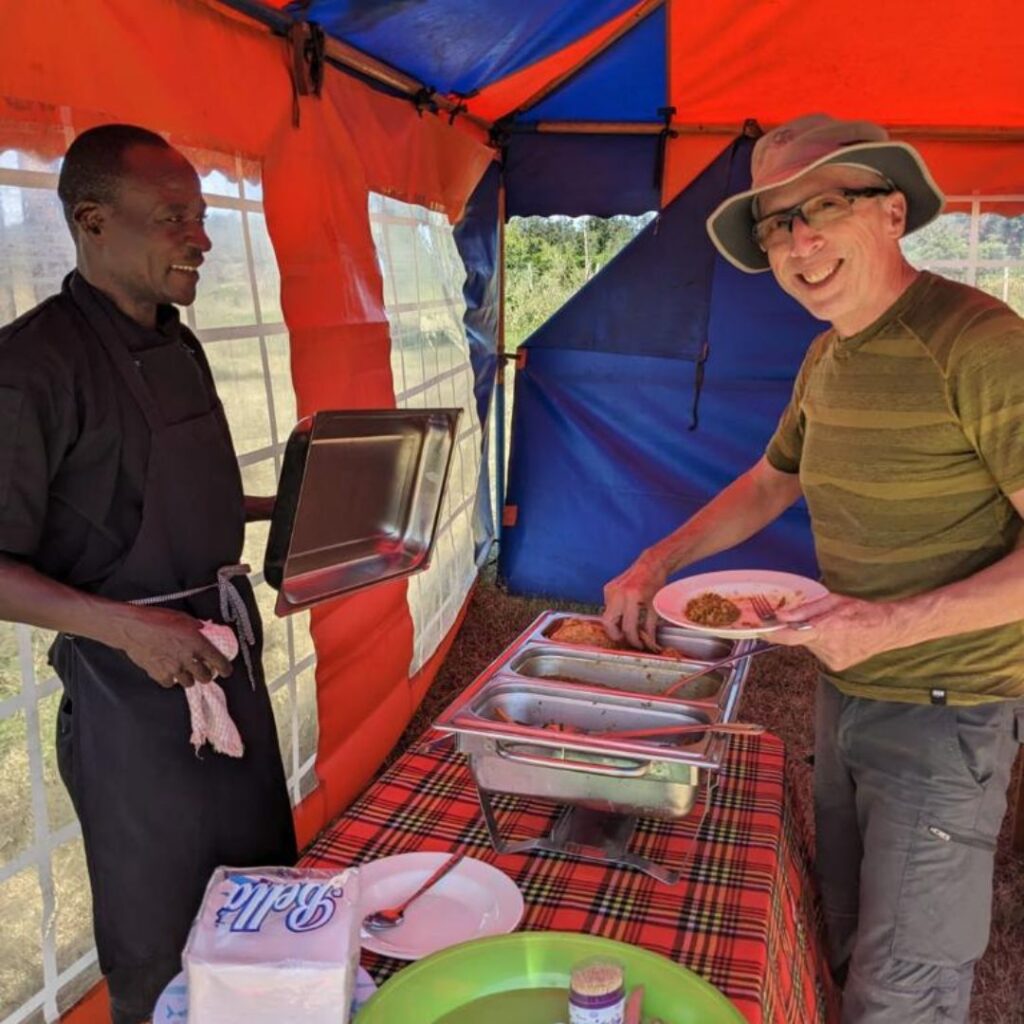

After lunch, we all went back to the same work and the walls moved quickly. Each wall was about 20 to 25 feet long. The blocks were each about 10 inches high. We completed almost three new complete rows by the end of our workday that we decided would be 4pm or whenever we’d reached a logical stopping point. A typical stopping point would be completion of a pile of concrete.
The block cleaning crew finished earlier and spent some time visiting the school and talking with kids as the school day ended. Many of the younger kids were released earlier (30 minutes) and had to wait for older siblings to walk home–some as many as 10 kilometers each way.
The kids were very friendly and loved having their photos taken and then seeing the photos. Val, in particular, had a great time with them and took many pictures. Almost all of the kids had blue school uniforms but many also wore sweaters over their uniforms despite what we thought was warm weather.
We completed the mortar/block gap filling and called it a day at 4pm. A little mortar was left for the team to smooth out some gaps and lay a few more blocks and we left them to finish that. I spoke with Joel about upcoming work and finding ways to keep everyone involved. He said that the next day we would be building step ladders by hand that we would use to build the walls as they got taller. He also said that we would start assembling the beams and cross-beams for the roof (out of wood). More blocks would still need to be cleaned, too.
The team left behind work boots and some equipment in the Headmaster’s office and we loaded into the vans content with our first-days accomplishments and very happy with the local team.
The drive back to the hotel took almost exactly an hour with no stops. We all showered and relaxed a bit–except for Vicky and Charles who needed to change rooms because they had no hot water in their original rooms. That was handled quickly as was the “dog issue,” since Nderitu insisted on reiterating our concerns to the front office.
Becky and I met Charles, followed shortly later by Noah and Bonnie, at an umbrellaed table outside of the Mt Kenya bar. I brought a crowlers of Lost Friend Brewing Company’s Homeward Bound Hazy IPA that we shared and Bonnie brought a bottle of red wine she’d bought at Carrefour. We all discussed the day’s work and our satisfaction with the school site project.
Margaret dropped by after having tried the swimming pool which she reported to be refreshing but a bit chilly. She returned to her room to change and met us at dinner at 7pm.
Dinner this evening featured Nile Perch that was spiced with lemon juice and herbs along with more roasted vegetables, potatoes, and some beef. We also had more corn “pap.” We all drank water instead of beer tonight.
The group was exhausted and ready to go back to our rooms by 8pm.
Throughout the evening I tracked Treg’s progress along with Nderitu. She arrives into Nairobi on schedule and found our driver without incident. He took her to the Longview Hotel for the night and we arranged for another driver to pick her up by 7am the next morning to bring her to the hotel and then the work site. By 10pm that was all set and I was able to go to sleep. I’d used the waiting time to process photos and (without much luck) tried to upload a few with Lusoi’s balky, weak wifi links.
6 June 2023

We slept well last night with zero barking dogs. I continued to try to upload photos as we cleaned and dressed for the work day. I gave up at 6:30 and brought my laptop to breakfast to use the dining area’s wifi. That didn’t work much better, so after breakfast I Sat in the reception area with some success.
Breakfast was similar to the day before but with small pancakes instead of crepes, some green beans, and more fresh fruit including some excellent papaya. The coffee was good again, too. All right in our team ate together.
Just after 7, we broke up to prep for the day. Nderitu told me the plan for the day and confirmed that Treg was on her way. Later in the morning, he would meet her and the driver at the hotel and then transport her to the worksite.
The skies were clear as we drove and we finally got an excellent view of the top of My Kenya. We did a quick stop in Naro Moru and continued along. There was some discussion of cash and how we’d pay the balance due for our weekend safari, but we decided that we could do that by stopping by a couple of ATMs en route and during our return from Samburu on Friday and Sunday, respectively.

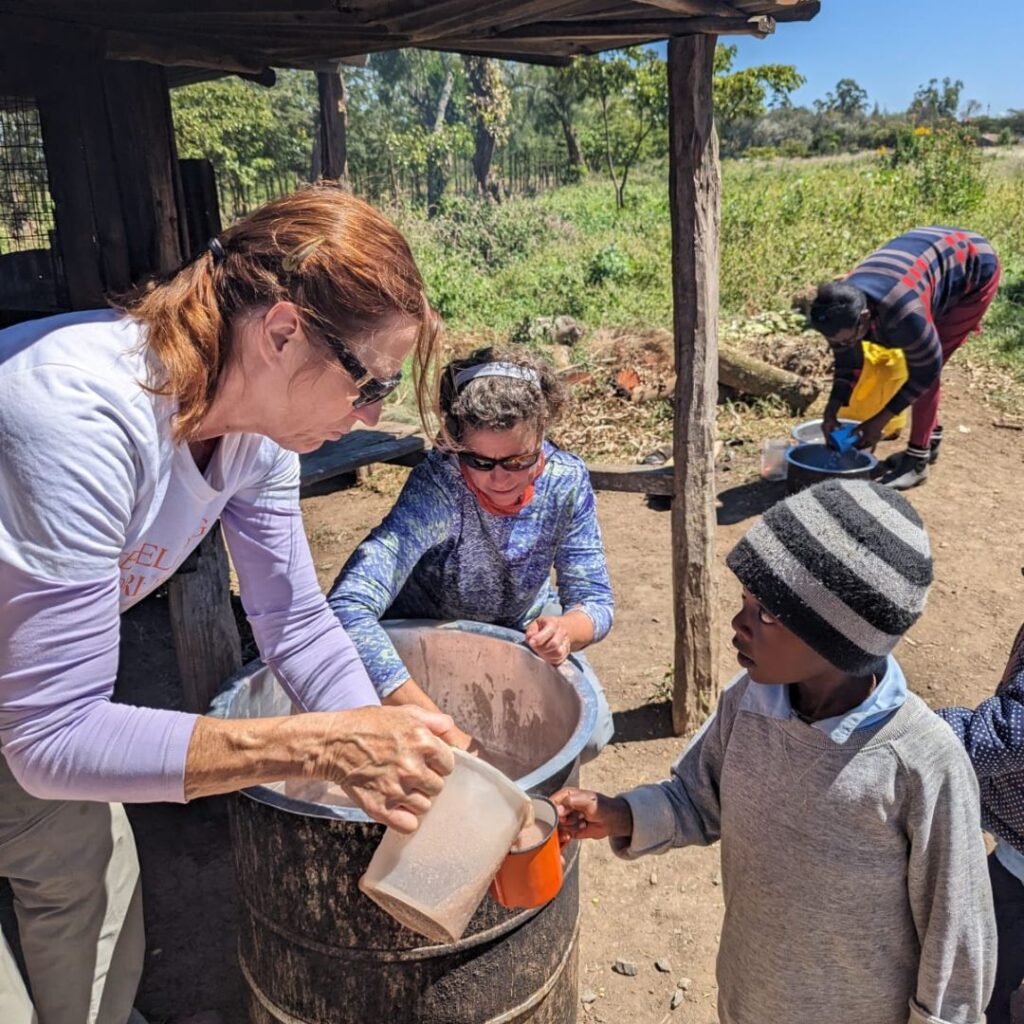
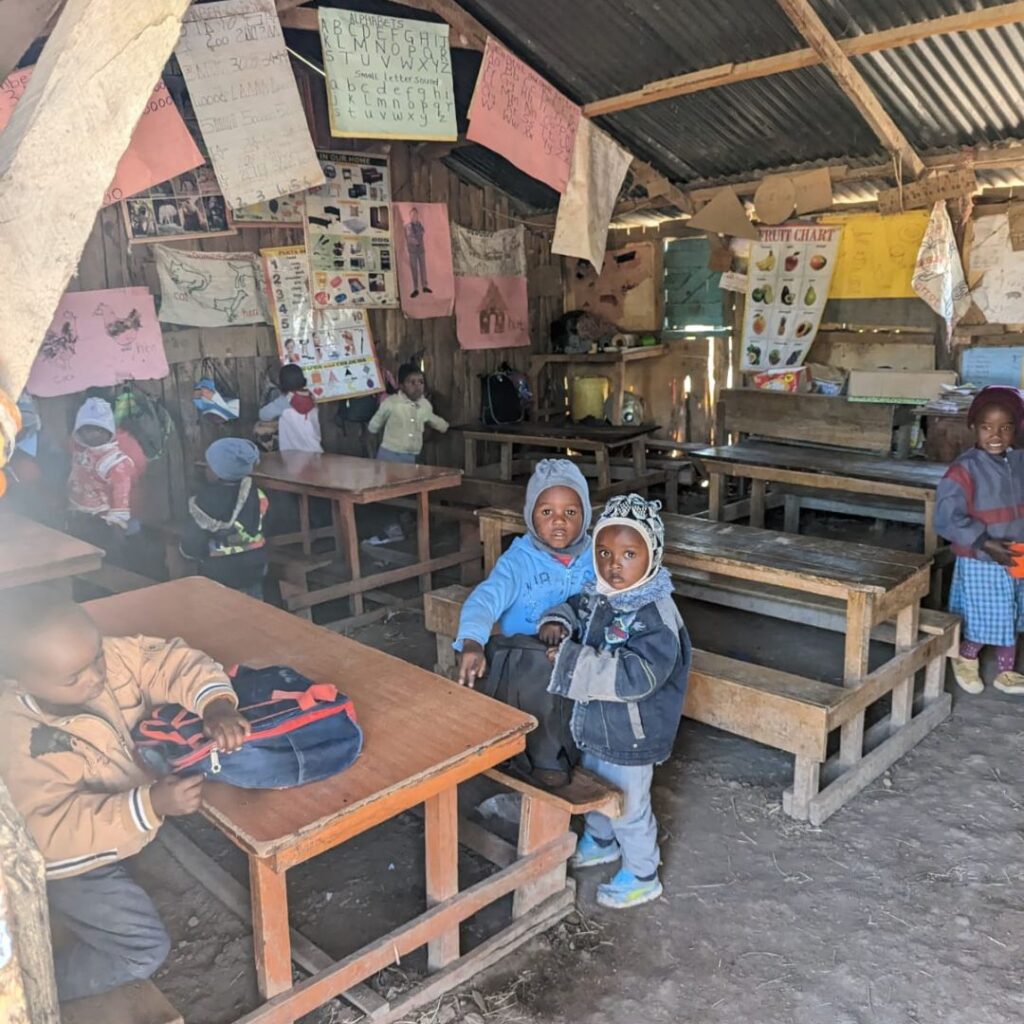
The rest of the drive in was uneventful, though our drivers did seem to get lost just a little bit and we arrived at the school from a different direction.
The day’s work was largely a repeat of Day 1. The stone cleaning crew improved their process and almost finished all of them. They were a bit upset that they hadn’t taken a “before” picture of the huge pile of stones.
The stone gap filling crew and the stone placers hit an excellent rhythm, switching from wall to wall as one completed a side, allowing the other group to move on and do another. We were constantly mixing mortar in smaller batches, recycling dropped excess mortar from around the wall bases and setting level lines for new layers.
A more rough hewn, whiter stone was used for one full layer on the front of the building and we were told that windows would be set on them. Filling the gaps with mortar between those stones was more challenging.
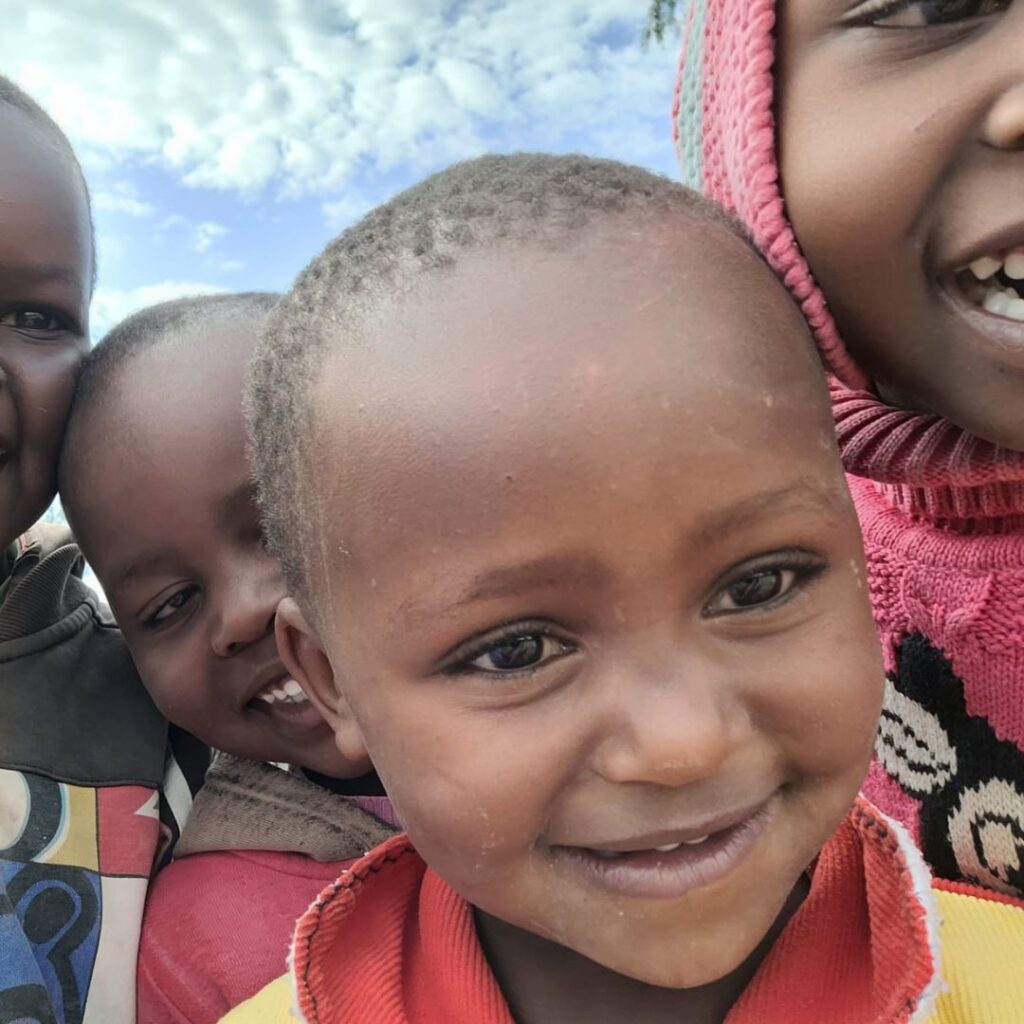


Time flew by quickly. Before we knew it, the clock was at 1am and we had to break for tea. Shortly thereafter, Treg arrived with Nderitu from Nairobi and joined in with the work. The only annoyance was a significantly stronger, drier wind that kicked up substantial dust occasionally. Or, more accurately, blew the dust we generated into our eyes and exposed skin and orifices.
And then it was lunch already. Today’s lunch was an excellent potato and vegetable stew on rice with watermelon for dessert.
As we went back to work, Nderitu told me that he to run som errands in a van and would be back to leave at 4pm. Meanwhile, the walls were going up quickly. We needed to move blocks and work platforms to use as low-level scaffolding to reach the tops of the walls by now and our balance was challenged. We were so high by the end of the day that we needed step blocks to climb onto the scaffolding.
As each new section of wall was set, Joel would call me and point to the wall saying thelat they were ready for Bonnie, Margaret, Noah, and me to fill. I think he really liked that we were responding to his orders and he would chuckle a little each time. He and the other workers had nothing but encouraging words for us as we all pitched in wherever and whenever needed. Noah was mixing concrete along with the locals, Bonnie was scraping up excess mortar for remixing and reuse, and Margaret and I continued to patch and fill, mix, move scaffolding, etc. Talking with Simon, one of the locals who had excellent English skills and was an excellent stone-layer, he was very surprised by our ages and how hard we were working.
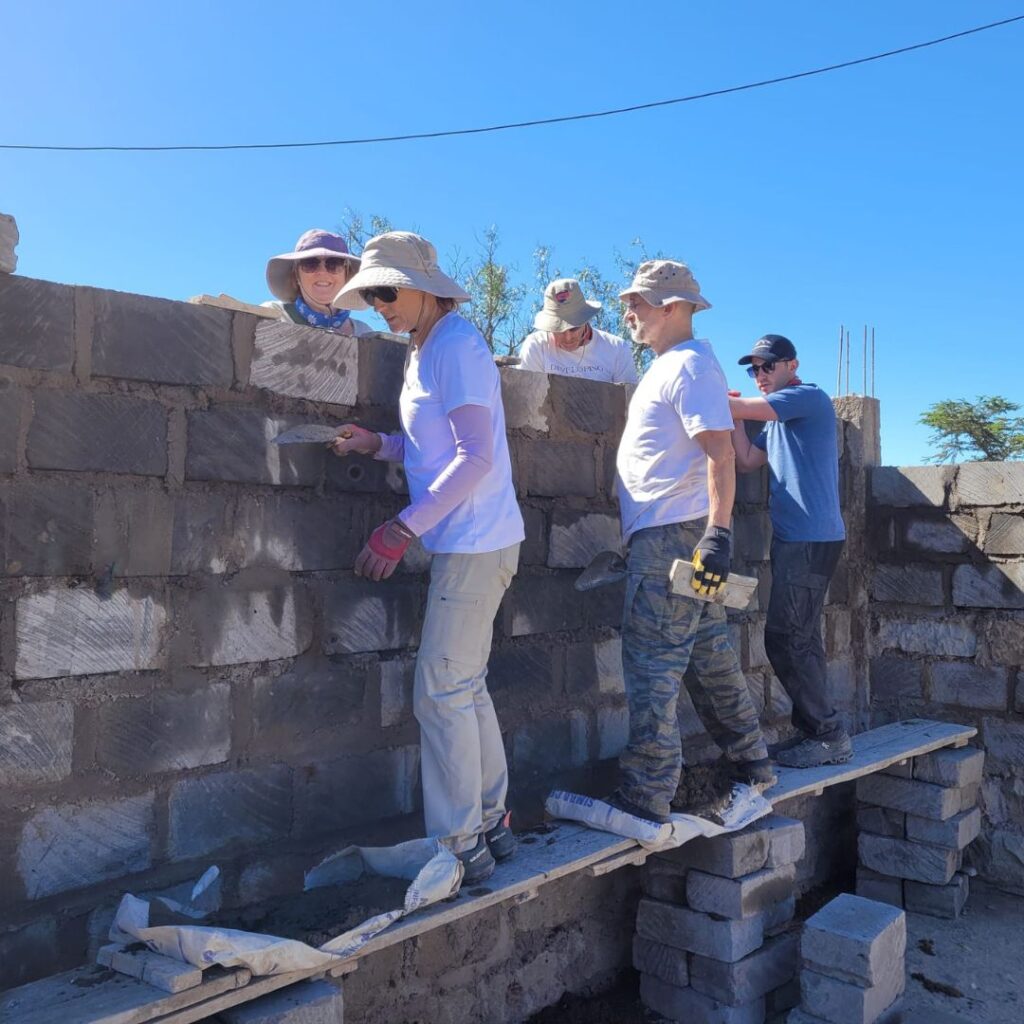


True to his word, Nderitu returned at 4pm and we started cleaning up–andnplaying with the kids. They loved trying on our gloves, taking selfies, giving high-fives, and just saying “hello” and other phrases to practice their English.
In their schools, they are first taught Swahili, but also begin with English in preschool. They learn their own tribal language at home.
We packed up and also stored equipment in the Headmaster’s office again. We said goodbye to our coworkers and they told us that they would finish the last of the concrete and as much of the walls as possible. We were rapidly.approachinfnthw point at which, on the ends of the building, we would start making a triangular support for the roof and Joel and Nderitu told us that starting Wednesday or Thursday we would begin assembling the tie beams for the roof and possibly set them before the weekend.
Nderitu pulled me aside and reiterated how happy the locals and others were with our progress and hard work. I agreed and told him that we were equally impressed without the local construction team and school staff.
We loaded the vans just after 4pm and started back. The skies were clearing around Mt Kenya again and we also drove by many school kids still walking home after dismissal for the day, but already kilometers away. They all waved at us and screamed “hellos.”
Along the roads, you can’t help but notic the number of kids everywhere. Kenya is clearly a young country filled with kids. Their educational seems to be a huge priority, too, as most seem to be wearing school uniforms, usually in red, blue, or green I know the whole DWC crew noticed this and are happy to be contributing to Kenya’s future in a small way.
We arrived back at the Lusoi right at 5pm and broke for the showers. In our van, we wondered what our excellent soup-of-the-day would be, while I looked forward to another Lost Friend IPA and/,or some red wine. I know we were all very tired, but happy.
7 June 2023
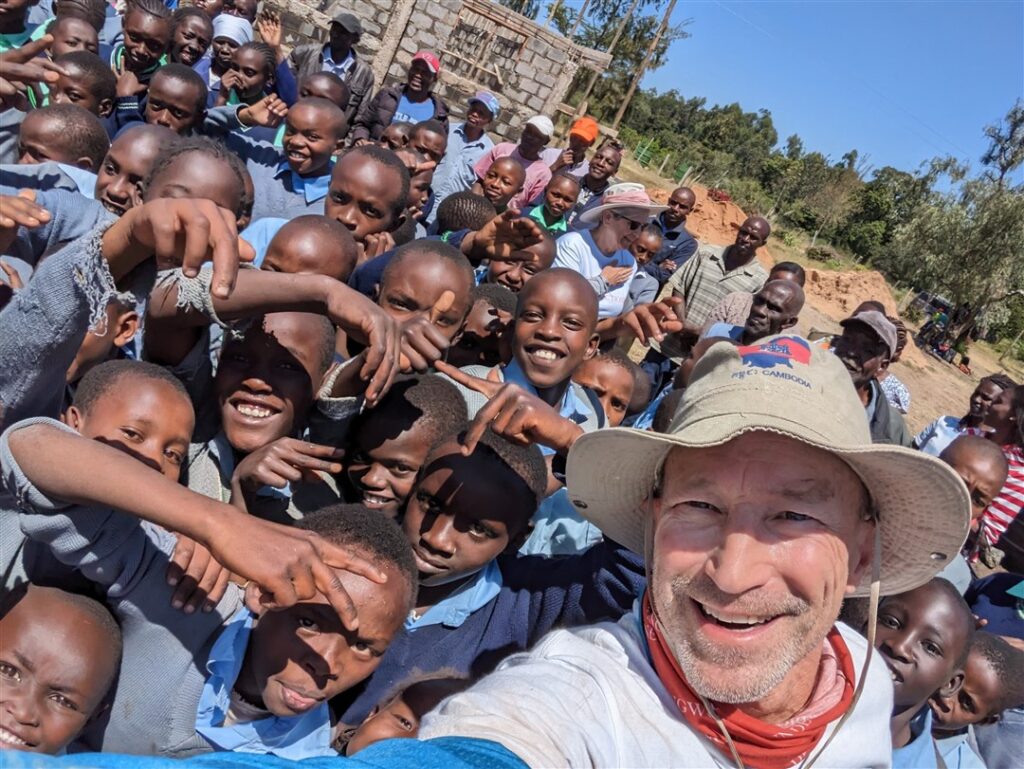
Neither Becky nor I slept very well. A few little “no-see-ums” buzzed around the room and they seemed to like my ears–very annoying. It was a second quiet evening, though, with no barking dogs. The rooms were getting a little stuffy, though, as Noah and others noted. Without the ability (or desire) to open the windows, because of the lack of screens to keep insects out, and no air-conditioning, the rooms seemed to be getting warmer with each evening.
When we awoke, I was pleased to learn that Mark had successfully met his driver after landing at 3:05am from Istanbul and was almost to Lusoi. A few minutes later he texted that his driver couldn’t find his way through the maze of dirt roads to get to the hotel and that his nav app wasn’t showing a clear route in. Eventually, though, he made it through and I met him at the reception.
There was no one at reception to give him a room, so he decided to change clothes and freshen up in the dining area washroom before getting some coffee. We took his bags to store them in our room and met the vans in the courtyard, introducing Mark to everyone.
We left on time and agreed to meet in Naro Moru to buy more drinking water and meet Nderitu who would arrive with Mark’s driver after paying him.
We bought four 10-liter bottles of water at the largest supermarket in Naro Moru–smaller than a typical America convenience store like a 7-eleven, but stocked to the ceiling with more goods than you can imagine, very narrow aisles, and about two times more employees than they needed.
We met Nderitu after the water purchase and left for Iriuko. He asked that all of us wear DWC shirts tomorrow because a photo/video crew would be at the site to document the project. He joined us in Isaac’s van for the ride ina dnd we discussed topics like the geology and length of the Great Rift Valley, human evolution and genetic diversity and research, and what toys, balls, and books we might buy for the school kids before we left next week.
Once again the morning fog cleared and the day was completely cloud-free, affording us more spectacular views of Mt Kenya. We arrived at the worksite shortly after 9am.
The winds were calmer today, but the temperatures stayed mild. When we arrived, we saw that holes in two opposite walls with wooden poles stuck through the outside. One side had tall, vertical poles planted into the ground. It was clear that the horizontal poles would eventually be connected to the verticals on both sides and then planks were placed on the horizontals. The eucalyptus poles were also timed with wire and the planks were nailed onto the horizontals as well as into each other making a very solid, strong scaffolding–considerably more stable that just stacking the platform planks onto stacks of rocks.
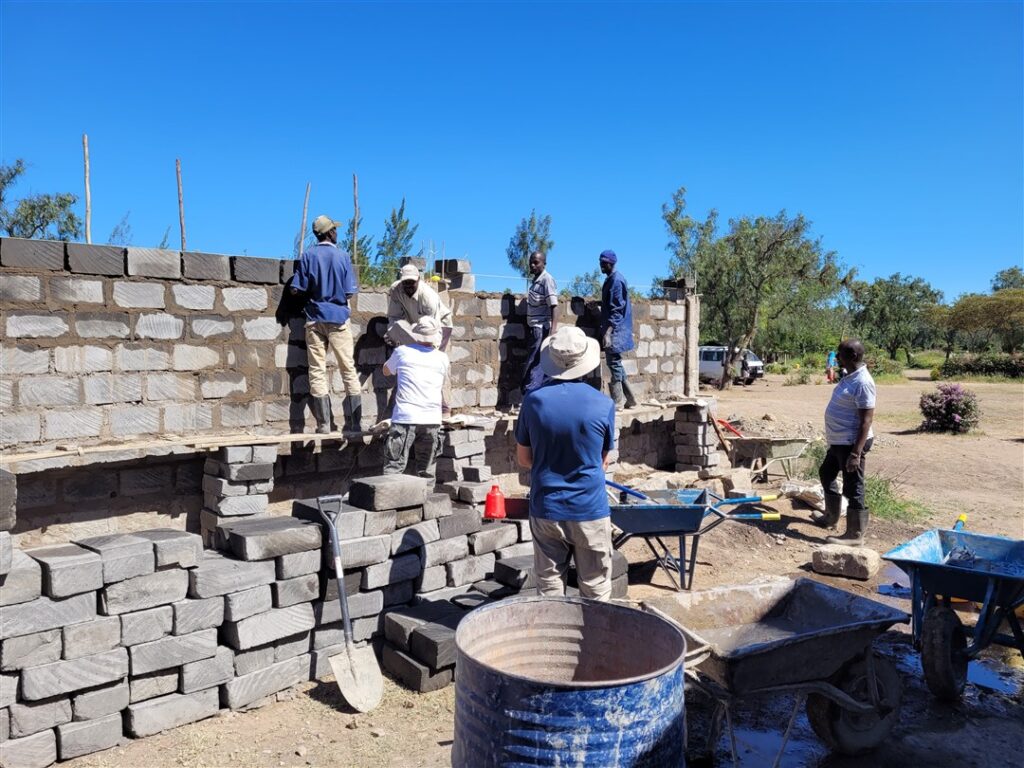
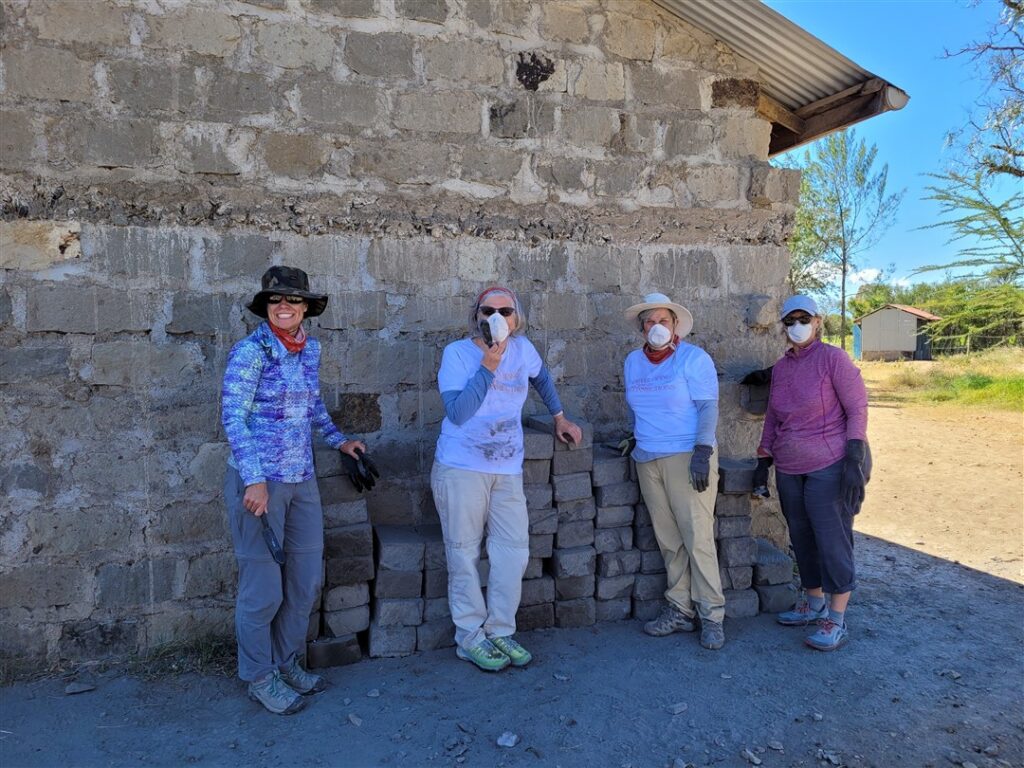
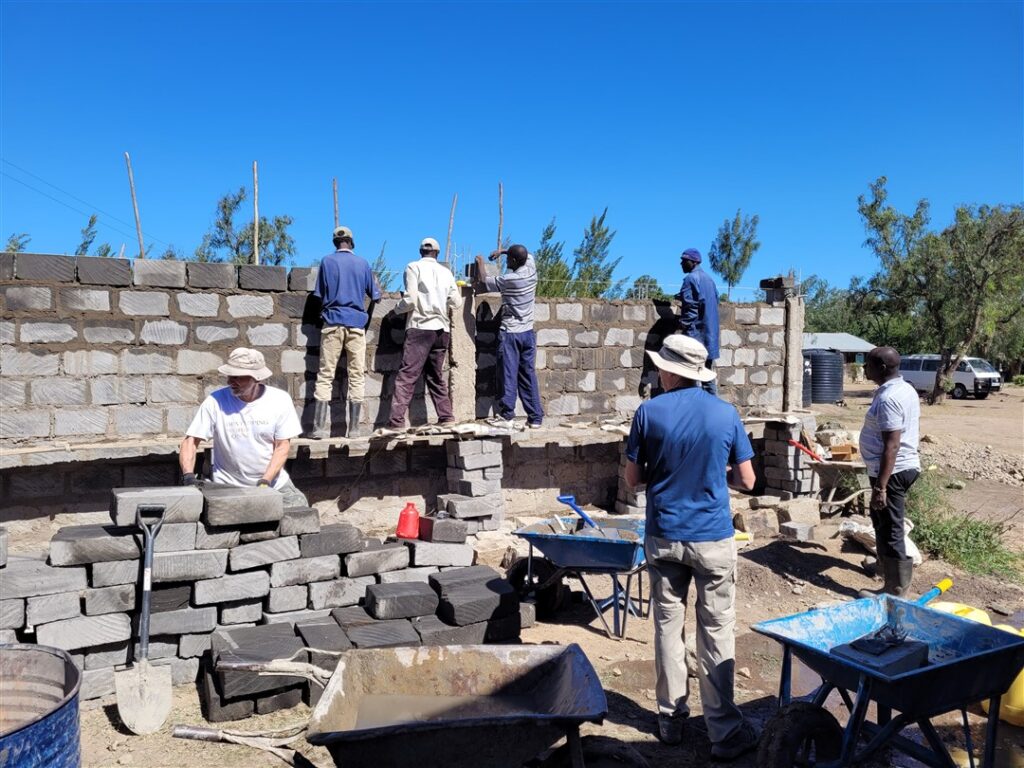
The “A Team” finished their stone washing Wednesday morning and began clean-up of the inside of the building/ We moved the stacks of stones, both inside and out, that had been used as low-level scaffolding platforms and moved almost all of them to the far side of the building where the new scaffolding was assembled. Simon and William continued to build that wall, while Margaret, Bonnie, Mark, and I scaled the scaffolding and filled gaps. Other workers were finishing laying the stones on the back side of the building that would frame the windows. Others from the A-Team were tasked with wetting the stones that had been set in the two prior days and mortar was added to gaps and holes in the horizontal mortar. Because of the relatively large variation in the depth of each stone, the inside of the building’s vertical surfaces were quite large, making a very irregular vertical surface. I’d say the variation was about a half-inch or more. The stone masons had clearly decided that they would try to make the outside of the walls as aligned as possible and suck up any differences on the inside. It still wasn’t clear to us if we would ultimately stucco the inside walls, outside walls, neither, or both in this process. Quality control on the work, however, seemed a little less than what I’d experienced elsewhere.
While working early in the day, I noticed that Simon’s shoes were torn and worn and many places and were barely staying on his feet. I asked him what size shoes he wore and was pleased to hear hm say 42 (European size that translate to about 8.5 to 9 in American sizes. That’s my exact size, too, so I asked him if he would like a pair of rubber boots to replace his shoes. He enthusiastically said yes, so I walked over to our duffle bag of work supplies and grabbed the pair of boots Becky had bought at Wal-Mart before leaving Colorado.
Nderitu had told us that if we brought rubber work boots with us that they might not be useful during the relative dry season, but that we might have thunderstorms and it was best to be prepared. He also agreed that leaving the boots behind as a donation to one of the workers or for the community in general would be a good idea, well appreciated. We’d debating carrying two pairs of boots all of the way to Africa when the forecast seemed to clearly show dry weather, but Becky bought the boots anyway on our last day at home.
Now, I was very glad that we did as Simon peeled his tattered shoes from his feet and put his bare toes into the boots. I think that I’ll also leave him a few pairs of socks that I bought for the trip, too, giving them to him on the last day. In many of our more adventurous trips and DC projects, I’ll back a package of eight to 12 cheap socks at Costco (usually at a price of about $1/pair and then, as the trip progresses, wear each pair for two or three days before either leaving them in my room at the end of the trip for the hotel staff to have, or giving them away to someone.
Tea break came quickly and we all took breaks that overlapped by some minutes. Marcy, from the school community was there with her four-month-old daughter again and the baby was passed around to Treg, Margaret, and others as we chatted. Marcy walks several kilometers per day with her baby to go to and from the school.

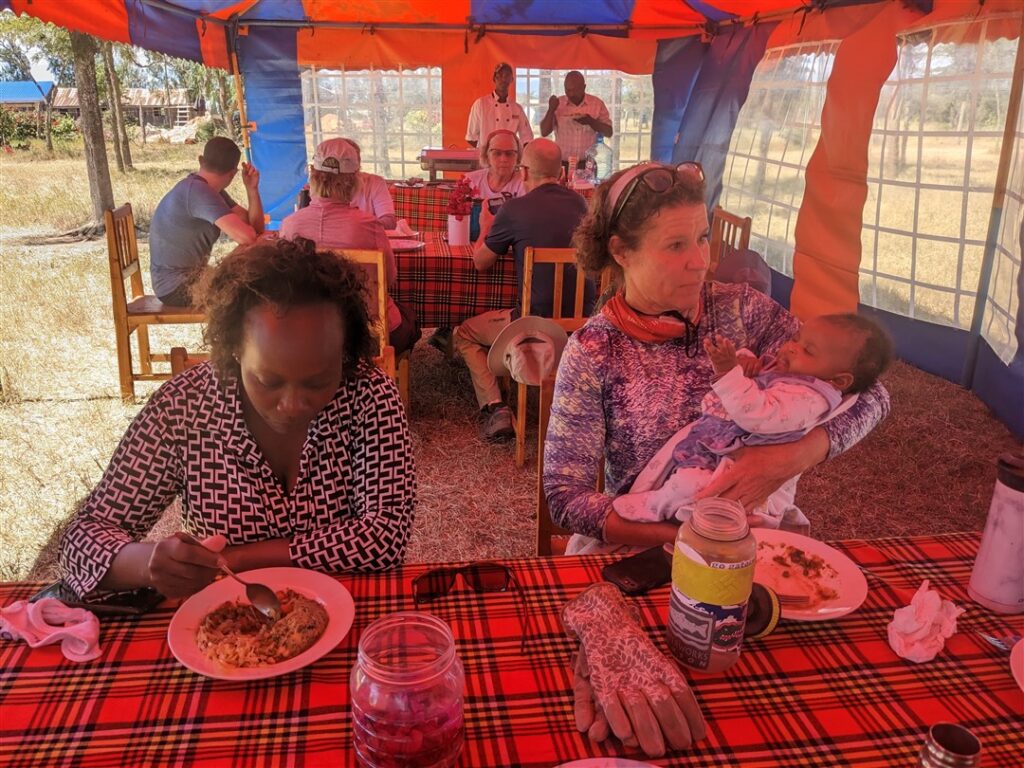

Mark continued to work on filling vertical gaps as the tallest wall with the assembled scaffolding went higher. I think he was afraid to stop working because then he would fall asleep, having
Only slept a couple of hours on the plane the night before.
After tea, Noah, Treg, Charles, and I moved more stones to the wall side that would have the first of two gables. These stones came from inside of the building and as we cleared them, Vicky and others not only wetted the walls, but swept and cleaned the very rough concrete of the internal floor. (We heard later that a leveling agent would be poured over this when the building was complete to make for a better school room surface). Treg kept adding more stones to each wheelbarrow she hauled outside of the building, getting to seven of the (approximately) 20-kg blocks and saying that her personal trainer would be proud of her work.
We broke for lunch and enjoyed more great food, including some beef and vegetable mix that I poured over shredded, cooked cabbage, and once again we had the balls of mashed peas embedded with kernels of corn. For fruit, we enjoyed watermelon and orange slices.
At the request of the DWC staff, I did my first interview with Val. I thought it went well and lasted about two minutes, but on replay I realized that she was too far away from my phone, so I deleted it and we tried again just after lunch. The second take went pretty well, so I posted that to WhatsApp for Juliet at DWC to use. Val also took some video including a very funny one of Vicky who’d found a machete near the volleyball net in the school area and was brandishing it with mock bravado.
Val also caught me mixing a wheelbarrow full of mortar and did a two-minute interview of my shovel action.
Also after lunch, we walked to the notorious bridge over the small (at this time of year) creek that is on a path to the school taken by many of the local children. As mentioned earlier, two children had drowned at that site. There was some confusion about when this actually happened as, just the day before, we’d heard that the community had held a funeral for two kids that had drowned. Patrick, the Headmaster, and Nderitu clarified that the drowning on the bridge had actually occurred three years before when raging water during the rainy season had swept away two children that had fallen off the bridge. Last year, a small, about three-meter retention and flow control dam had been built just below the bridge for safety reasons. However, the bridge was still dangerous with large gaps in the railing making it easy for small children to fall into the water. Additionally, the wooden boards that formed the walking surface of the bridge had gaps and were splintered or broken in many places.
We also learned that the other two drownings had been unrelated to the bridge, but had occurred last week at a local pond
We discussed what might be done to make the bridge more safe, preventing kids from falling through the gaps, especially buying some heavy duty wire mesh that could be welded onto the existing railing and vertical piping. I mentioned fastening it with u-bolts or twisted baling wire, but Nderitu said that that would not be secure enough and that the mesh might quickly become multiple chicken cages for some local farmers if not more permanently installed. Nderitu assured us that he would work with the Headmaster and try to find the material and a welder.
We walked back to the worksite and learned the names of some of the local flora, including the candletree flower and the tall sisal that I had always called “century plant” growing up around it in Arizona. I told Nderitu that sisal was cultivated in Mexico to make a Tequila-type liquor and he responded by saying that was used more in Kenya for it’s fibers to make rope.
Back at the site, clean-up work continued and, on the side of the building nearest the other school buildings, holes were dug for scaffolding vertical poles while horizontals (five) were put through freshly punches holes in the wall. Again, the horizontals were nailed to the verticals and reinforced with twisted wire at the joints.
While more cleaning, patching, and prep work for the higher reaches of the building continued, Treg and I walked among classrooms with the Headmaster, greeting the kids and teachers, and taking photos. Most of the floors were dirt and the dilapidated desks shared by two or three students. There chalkboards with mostly English lessons on them and I was impressed with the content. A third grade class was doing three-digit addition, while a fifth grade class was learning about agriculture, and a seventh grade class had information about pollution and environmental protection for what their teacher said was their science class.
We continued through the different grades, with one classroom per grade and about 40-60 students per classroom. The kids were enthusiastic about having their photos taken and seemed very happy to see us. Their smiles made our day.
In watching the class day progress, we noticed that the students had several recess periods and spent a lot of time playing football, volleyball, and other activities.
Treg, Becky, and Bonnie went to lunch earlier and all were surprised at the small amount of porridge provided to the younger kids and the lack of additional food or even “seconds.” While thin, all of the students seemed healthy, though, and the fertile fields and pastures in the area spoke of a reasonably abundant food supply–at least for now. Still, we did not any any children that could even be classified as stocky or stout (much less overweight) in the Western sense.
With most of the clean-up complete and some patching still ongoing, we were ready to leave early for the day. Nderitu proposed that we take an alternate route back to the Lusoi that would skirt the exterior of a local private game reserve and give us the possibility of seeing some rhinos or other wildlife. It would add only about 20 minutes to the trip. We all enthusiastically agreed to the detour.
Patrick gave Marcy and her baby daughter a ride most of the way home as her normal route was in our revised direction. When he dropped her at an intersection of dirt roads, we appreciated how far she had to walk each day–we we’re at least 5km from the school and probably more.
A few kilometers later, we turned onto a paved road and then five minutes later passed the Solio Private Game Reserve Entrance. We continued past and shortly after, Isaac pointed out to us in the distance a herd of waterbuck, followed shortly thereafter by a small herd of Impala. We stopped for some distant photos and then saw a single black rhinoceros laying in the tall grass, it’s tall front horn pointing skyward and it’s ears twitching to flick off flies.
We moved on after a few photos and happened upon the shocking sight of seven large adult rhinos only about 50 meters from the tall doubled wire fences. Isaac told me to not approach the fence or get any closer than the side of the road and I complied. Val joined me as we crossed the road for better photos. Members of the other van staying inside and watched from their open windows. The beasts were just enormous, but seemed docile enough. The entire group was thrilled with the experience!

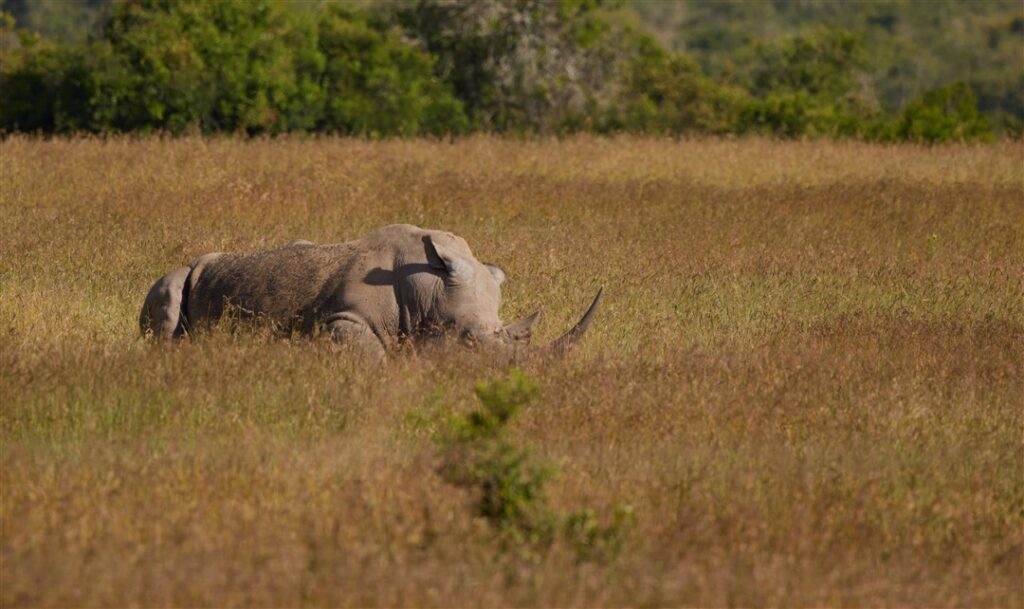
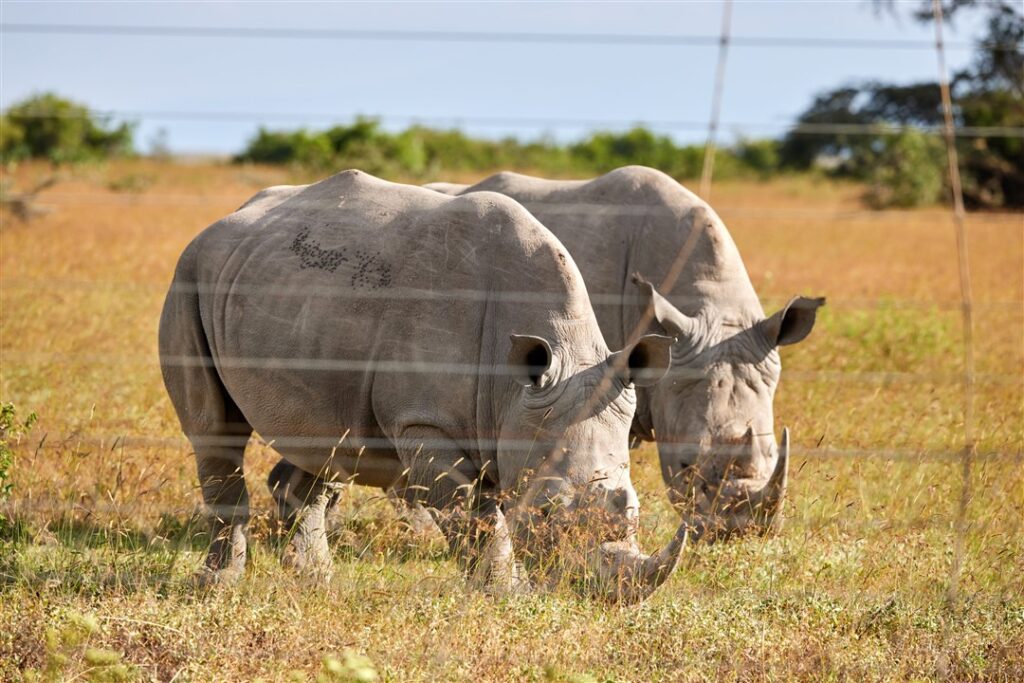
Becky googled the game reserve and found that it was one of the first in Kenya and the most successful focusing on rhinos. Rhinos from there had Ben used to successfully repopulate parks and other reserves throughout Africa.
We returned to the hotel at 5pm and Mark and Treg went to sort out room issues. Their keys had been swapped, hot water wasn’t available, etc. Charles had no hot water–or none was left when he showered.
Eventually, most of us rejoined at our outdoor table for wine, Tuskers beer, and conversation. Bonnie brought two bottles, I brought one, but we only drank one of the three.
At seven we went to dinner and enjoyed pork chops, mutton, more mashed pea balls with corn, excellent turmeric rice, the ubiquitous spinach, steamed bananas, and fruit. I reminded everyone to wear their DWC shirts for photo and video opportunities the next day and we discussed dropping laundry off in provided bags the next morning.
Becky went back to the room and I grabbed the laptop and went to reception to use wifi for uploading content until about 9pm.
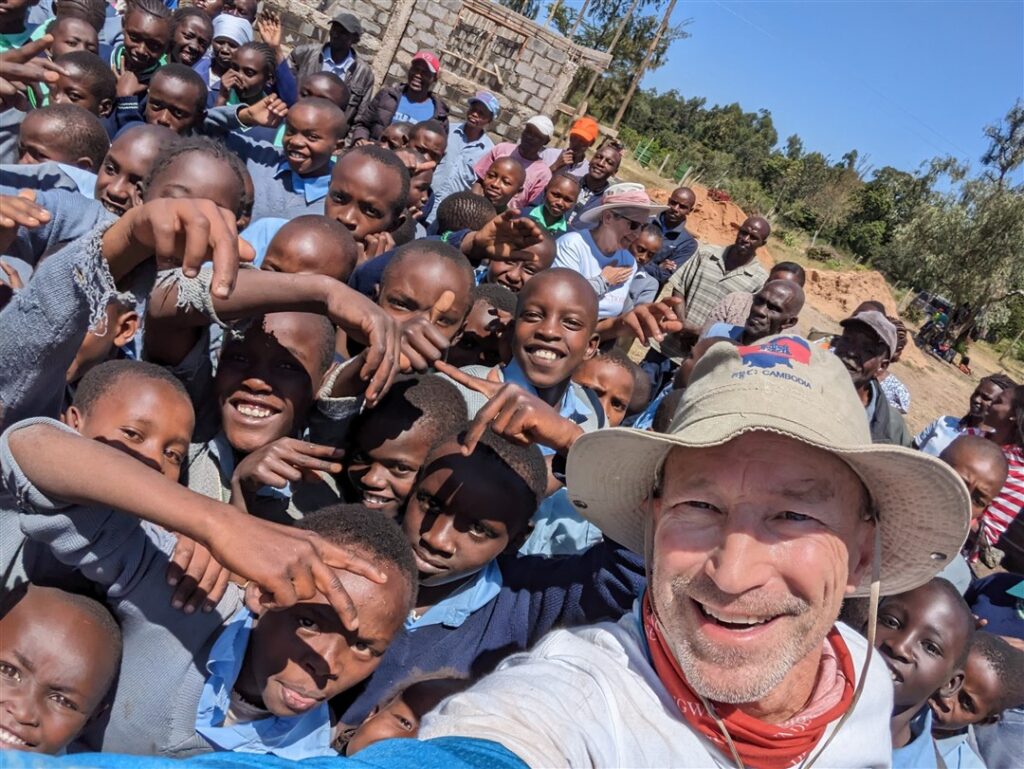
8 June 2023
The day dawned with nearly clear skies for the first time. I dressed quickly and went to the dining area to write my blog entry and the others joined me closer to 6:30 and we discussed the usual issues. I reminded myself to ask Nderitu about storing luggage on Friday morning when we went to Samburu while others talked about laundry and the bags they’d received at their doorstep. Becky and I didn’t get one. After breakfast, though, I went to reception and we tried the laundry for the first time with a pair of Becky’s pants.
Charles was happy to have had hot water when he returned to his room the night before and looked refreshed. Everyone seemed ready for another big day of work and we left the hotel very close to 7:30, arriving earlier than usual at about 8:30.
When we arrived, Patrick told us that Joel wanted us to all work together to wet down all of the blocks and mortar we had set to aid in the curing process. We hauled jugs and wheelbarrows of water and used small buckets to throw water on the walls. A few of us were a little miffed when Joel emerged from under his shaded tree with his cell phone to tell us if we’d missed a spot.
The next and primary jobs for this day were fairly clear and we had three of them. One group would be tying together long rebar structures that would be used as a reinforcing ring around the building, just above the door and window frames. Wooden frames were cut and installed in the windows and at the top of the door, with the workers just pounding nails through the red wood planks directly into the poured concrete pillars and stone blocks. Then, eucalyptus poles were cut as supports for each door and window frame holding the horizontal tops in place for the rebar ring. Margaret, Vicky, Val, and Bonnie worked on tying the rebar together after Simon had bent rectangular forms from full-sized rebar again. They fabricated about a 25 foot long piece while three more similarly sized “snakes” of rebar were pulled from storage.

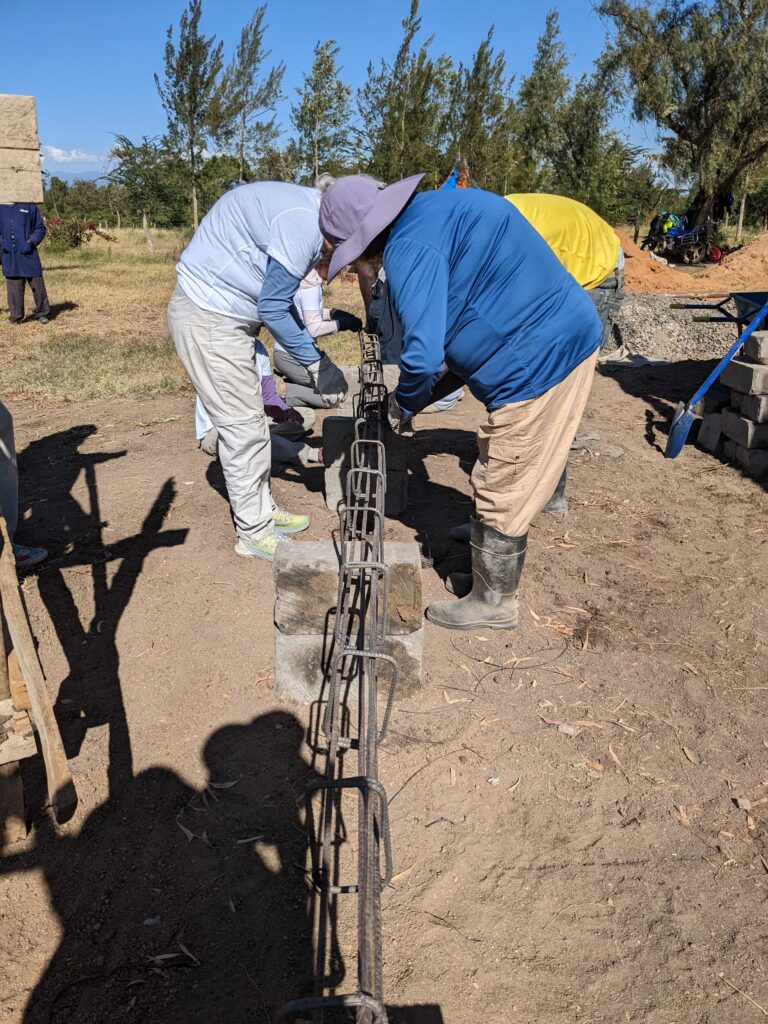
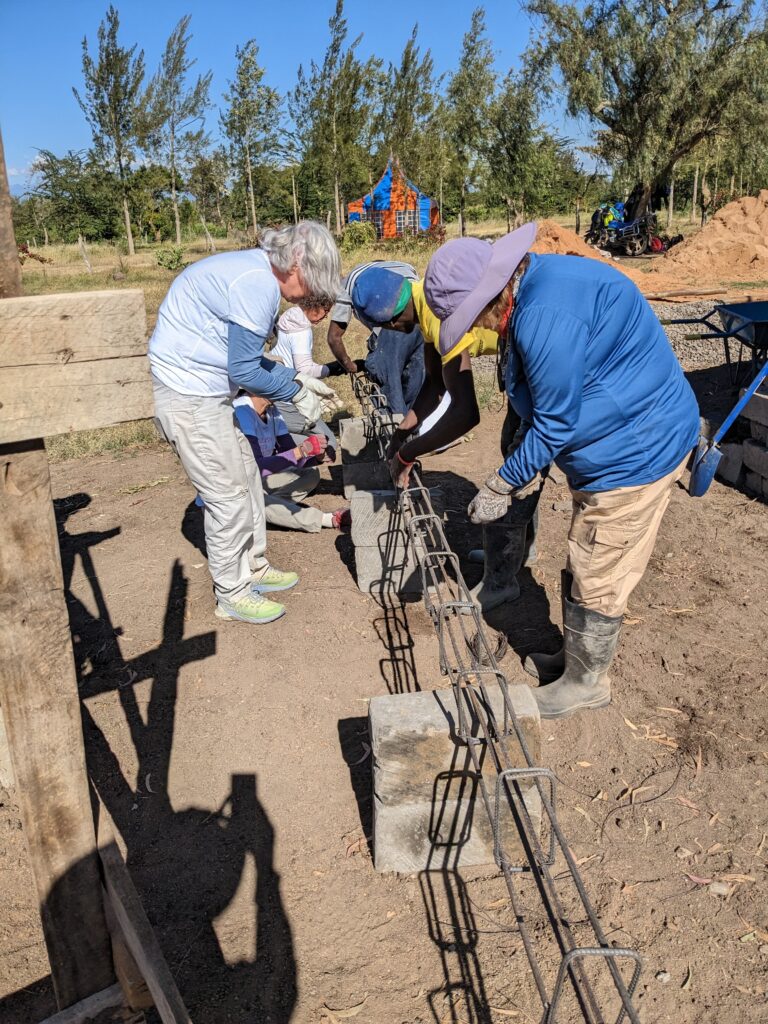
The next step involved hoisting the long rebar assemblies to the top of the existing stone structure. Several of us worked then to use wires to tie the horizontal rebar structure to the protruding vertical rebar pieces at the corners and several other vertical columns. The next step was to use our scaffolding platform pieces as concrete channel forms framing the horizontal rebar. We would be pouring fresh concrete into the large rectangular, reinforced channel that was a total of about 120 linear feet by five inches wide and about eight to ten inches deep. We plugged gaps on the underside of the forms with scraps from the cement bags.
The rest of the crew now shifted to treating the lumber that would be used to construct the roof truss structure. The wood itself had been delivered the day before and was quite a deep red as well as very aromatic. The treatment was anti-termite and was a thin, green, translucent liquid. There were only four brushes, so that was the process limiting factor affecting how long that task would last.
A photography and video crew arrived in the morning, arranged by Nderitu to document our work and the day’s activities for Developing World’ Connections. The crew included a videographer, two photographers and a supervisor that seemed to be working as hard as Joel on the construction side.
I saw that one of the photographers, named Kelvin, had a relatively simple Nikon DSLR, I think a 3100. I asked him if he was interested in using my Canon R5 and he jumped at the chance. I put it in a relatively basic mode, showed him how to access a few features and told him that he could use it for the day. The bonus for me was that I knew we’d get a few hundred photos from a different perspective.
I went back to work now and joined the crew hauling sand and rock to form our largest yet pile of concrete mix. We now used 10 wheelbarrows of sand along with four full bags of cement. The pile was mixed by all of us and then spread out in a circle about six to eight inches deep. Next, we added hauled and dumped another team wheelbarrow loads of about one to one-and-a-half inch gray granite gravel to the top of the pile. While this was happening, the above-structure workers continued to complete the channel framing, improvising with additional boards to finish the entire linear distance.
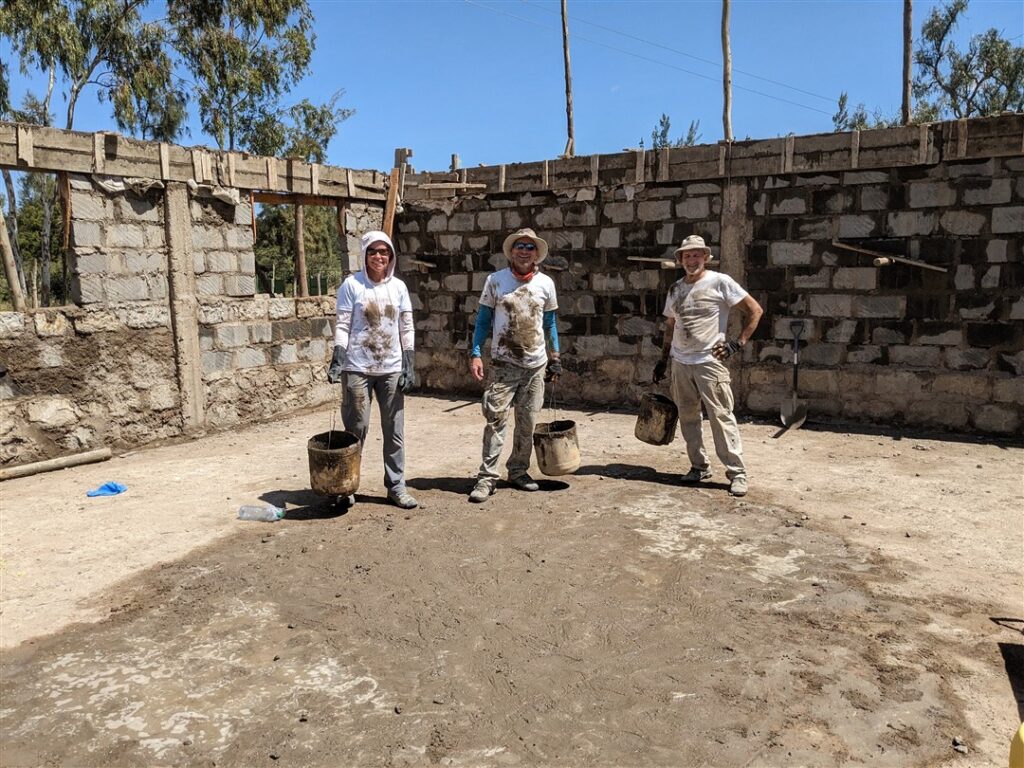

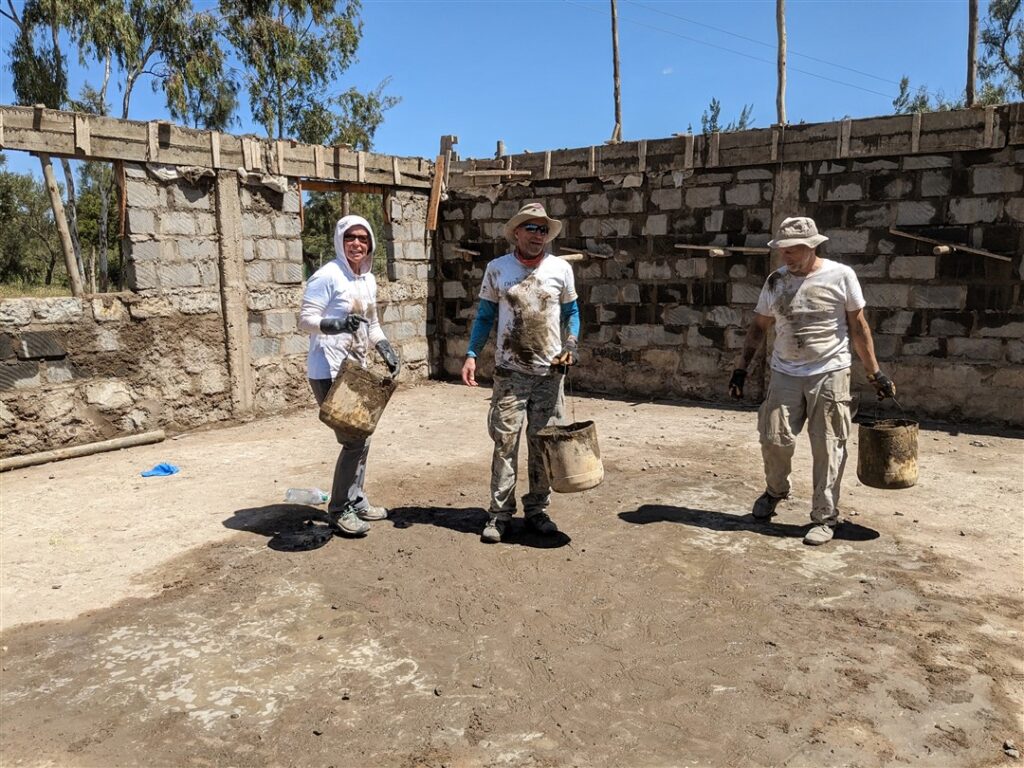
Many parents and other adults were now filtering into the work site, the women dressed in colorful skirts, dresses, long pants, and flowery blouses, while the men were in the usual drab blacks, grays, and blues. Most seemed content with just watching us at first, but at the gravel and sand piles I offered shovels to a few and they half-heartedly joined in to help with a few loads.
On the other hand, another group of visitors was working quite hard on leveling the ground to the south of our project. Once complete, the excees rough-hewn blocks were moved to that plot and laid out one high in what looked like what could ultimately become some sort of terrace or low platform.
The women were busy on the opposite side of the building deconstructing a large pile of rock and gravel (with some large boulders) that seemed to have been formed when the original foundation and floor were excavated for our project. Joel gave orders, but of course did zero work. However, when the video crew arrived, he moved our female volunteers away from one stone pile and made an ostentatious show of moving one rock for the camera.
The ladies really did a lot of work and moved some big boulders. In short order the grounds in the south and north sides of the classroom were much neater.
Then the concrete mixing began. Water was poured over the rocks that capped the mix, then more and more water. William was in charge of the mix along with one other worker.bsimon was atop the concrete forms. Improvised buckets made from the bottoms of!what looked like 20 liter vegetable oil plastic containers and double-wired looping handles were brought out.
As the mix continued, Treg, Mark, and I would take the half-full buckets of concrete (weighing 30-50 lbs per load) and lift them over our heads just high enough for Simon to reach down and grab the handle and dump the concrete into the channel. The process went relatively quickly and before long we had the first, west wall filled.
What came next was interesting… there was a small gasoline engine ina frame inside our building. Attached to it was a large hydraulic hose (about 20 Feet long and two inches in diameter connected to a solid steel cylinder. Simon explained that this was, in fact, a giant vibrator that they could insert into the poured concrete to eliminate air bubbles and any voids in the pour, as well as expunging excess water through the thin crack in the framing to help strengthen the resulting reinforced concrete ring.
Simon would insert the cylinder into the concrete about every three or four feet and we could see the result as plenty of water and thinner cement poured through the crack to fall on the floor below. We would then hand up extra buckets of concrete to top off the channels.
During this time, the video crew was conducting interviews with locals as well as each of the DWC volunteers. Treg, Becky, and others took break and interacted with many of the parents. All seemed to be enjoying the day.
Back at the pour, we committed to completing the entire first mix of concrete before breaking for lunch. That took us to almost 1:30 but was well worth the hard work. We made it about two-thirds of the way around the exterior before all was used, then took a break.
We had another good lunch in the tent and also meet up with the media crew. I discussed transferring photos with Kelvin and gave him some more info about the camera and formats used by Canon–my camera was set to record everything in raw format.
After lunch, another pile of concrete was mixed, this time about half as large as the first. The wood treaters kept at it, though Vicky started to feel the heat. Bonnie told me that she was in some distress, but now sitting in the shade inside the structure. Bonnie had soaked her DWC shirt at put it around Vicky’s neck to provide some relief.
I felt Vicky’s forehead and realized that she was probably suffering from heat exhaustion as she felt cool and clammy–much better than the dry and warm that could’ve signified the far more serious heat stroke. We wetted a DWC neckerchief and game that to her as well as more water. She recovered quickly, but still took it easy. I used the opportunity to find additional water and remind everyone to refill their water bottles.
During the short break between concrete batches, a great deal of activity was occurring in the center courtyard where speakers were talking to the children. Val embedded herself among the hundreds of kids, Treg was doing her own interview with a group a school mother’s, and Nderitu called me over to the event. One speaker (I was told he is a local Christian pastor) had the kids singing, clapping, and bouncing up and down to a rhythm. He began jumping very high to the joy and excitement of the kids.
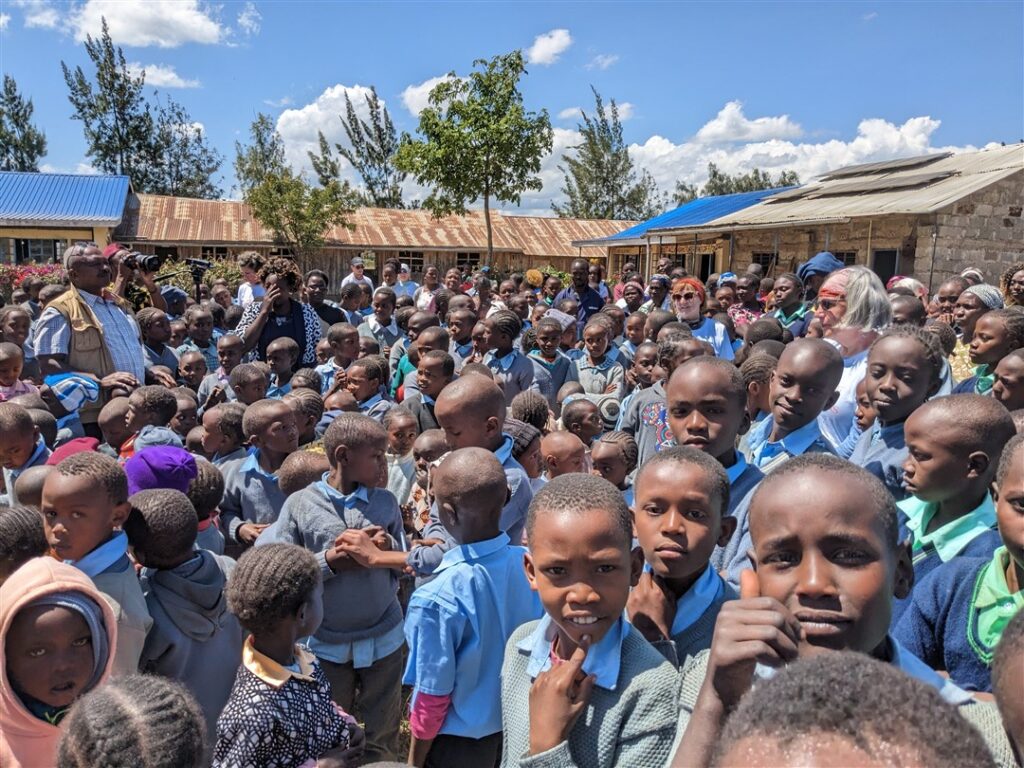
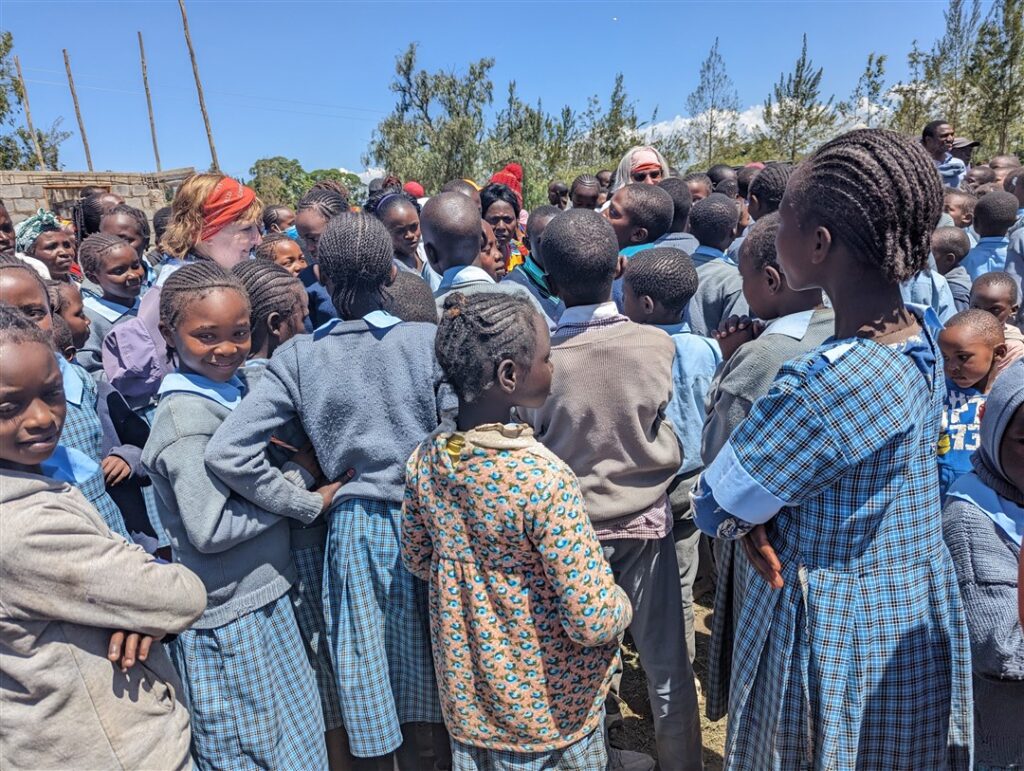
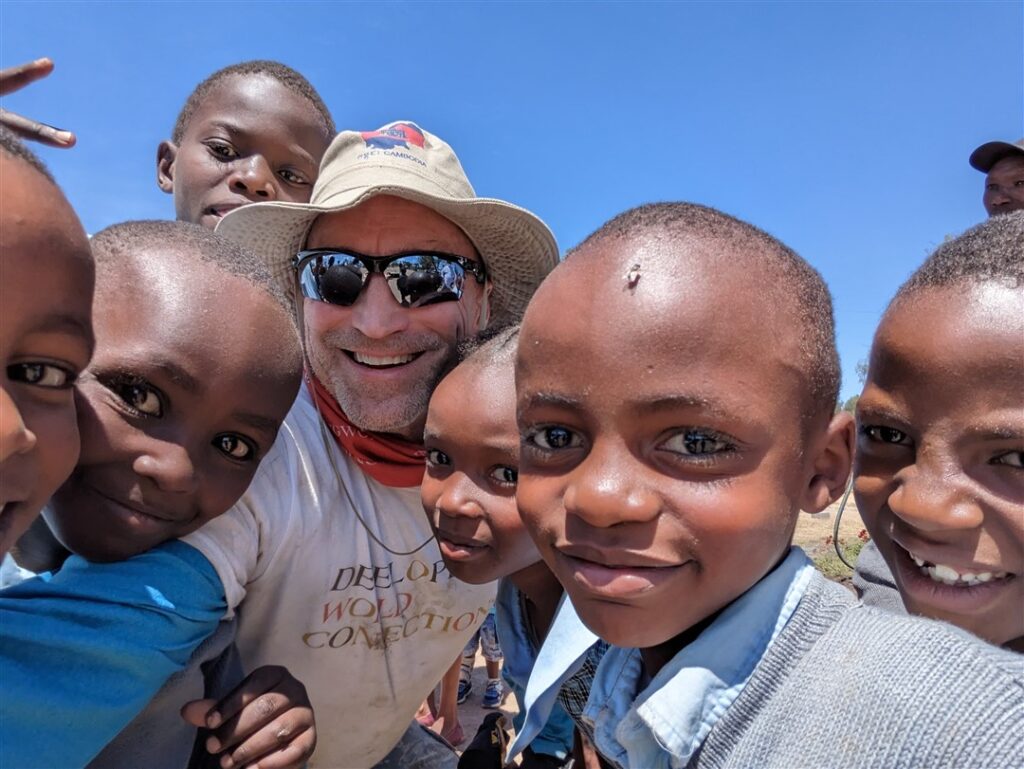
We returned to the concrete work and the others to their wood treatments. Vicky was doing better but still in the shade recovering. She took on the task of counting how many bucket loads of concrete we hauled on this second pour. The lifting process was a lot like doing a clean-and-jerk. We would lift up sharply on the handle to get the bottom of the bucket to cheat height and be able to put our hands underneath. Then, balancing the sloppy, very thin concrete, we would do a press to fully extended arms and then tiptoes to lift it high enough for Simon to reach down and grab the handle from about ten feet above us. I didn’t dare say anything at this point, but not only had we not accidentally dumped a bucket of concrete doing this, but Simon hadn’t dropped one, nor had he (much more seriously) fallen from atop his eight-inch-wide balance beam.
It took us 55 bucket loads to complete this next batch of concrete and we REALLY thought it had been sized right. However, we had to mix just a little more–with only a half-bag of cement to do the job. Vicky and Noah counted 76 total bucket loads and we then extrapolated that Mark, Treg, and I had lifted about 220 total loads. It was some of the hardest, most satisfying work of the trip.
At this point, our work for day was complete. With the ring poured, it would need to cure for two days before stone blocks could be set on it (or so we were told) and the crew told us that the timing was perfect as, when we returned from safari over the weekend, we’d be ready to go. They also said that they would be doing some work on Friday–hopefully finishing up the lumber treatment and expanding the scaffolding on the east and west sides to enable the triangular gables we saw on the in-use, but very similarly constructed building adjacent to us.
I worked with Kelvin a little to transfer files to his laptop. He assured me that he had software to convert all of the raw files to jpeg format. When we realized that I didn’t have the cable needed to transfer all of my files from my camera’s compact flash card to his computer, I told him I would set us a Google drive folder and upload them there when I returned to the hotel–and then give him access so that he could download all of the files.
We loaded up into the vans after storing our work equipment in the Headmaster’s office and drove back to the Lusoi.
Arriving back a little earlier than usual, we began organizing things for the next day–after showering, of course. Our room again did not have a bath floor mat, so I went to reception and asked for that and a replacement for the robe we’re used the day before for our bath mat. The hotel’s service staff delivered both quite promptly. We later learned that the absence of bath mats was a common issue in the other rooms after Day 1.
After cleaning up, we met outside at the bar to take advantage of their wifi and have a beer or some wine. Mark was already there enjoying a gin and tonic, and Charles was having a Tusker. I ordered a Tusker, too, and Becky looked up the components and asked the water to make her a “Bees Knees” made of lemon juice, honey, and gin. I also brought a long two bottles of red wine and plastic cups. Nderitu and Marcy from the school were also at the bar and joined us. They were expecting to meet the media crew who were at another covered gazebo.
I walked over to the crew and told them that, because of the pathetic wifi at the hotel and bar, I was unable to upload the photos, but then we found a thumb drive and were able to successfully move them. Before that final step, though, I had to use my software to convert all of my raw photos to jepg. It turns out that Kelvin and his crew didn’t have that ability, shot all of their photos in jpeg mode, and knew very little about post-processing. They asked me if they could copy my software (Capture 1l to use it and I politely declined.
Treg and Margaret joined us, as did Bonnie a little later. We enjoyed one bottle of wine and half of a second before moving to the dining room for dinner.
We had a beef-rice pilaf Wednesday night with chicken skewers, some excellent grilled vegetables, corn pap, and spinach. Again the team just had water to drink. We discussed the next day’s plan to leave between 8 and 8:30 the next morning so that we could have lunch at our lodge in Samburu and also have time for stops to get cash along the way. We would be checking out of our rooms, but Nderitu said that our tabs would carry over to next week’s stay. The reception staff told me that any laundry we left would also be delivered to our rooms for our Sunday evening return. We would also have a dedicated storage room for the items and bags we did not want to cart with us to Samburu. Before returning to the room, I went to reception in another largely unsuccessful attempt to upload photos. I was able to pist-process most of the days shots taken by Kelvin, though.
9 June 2023
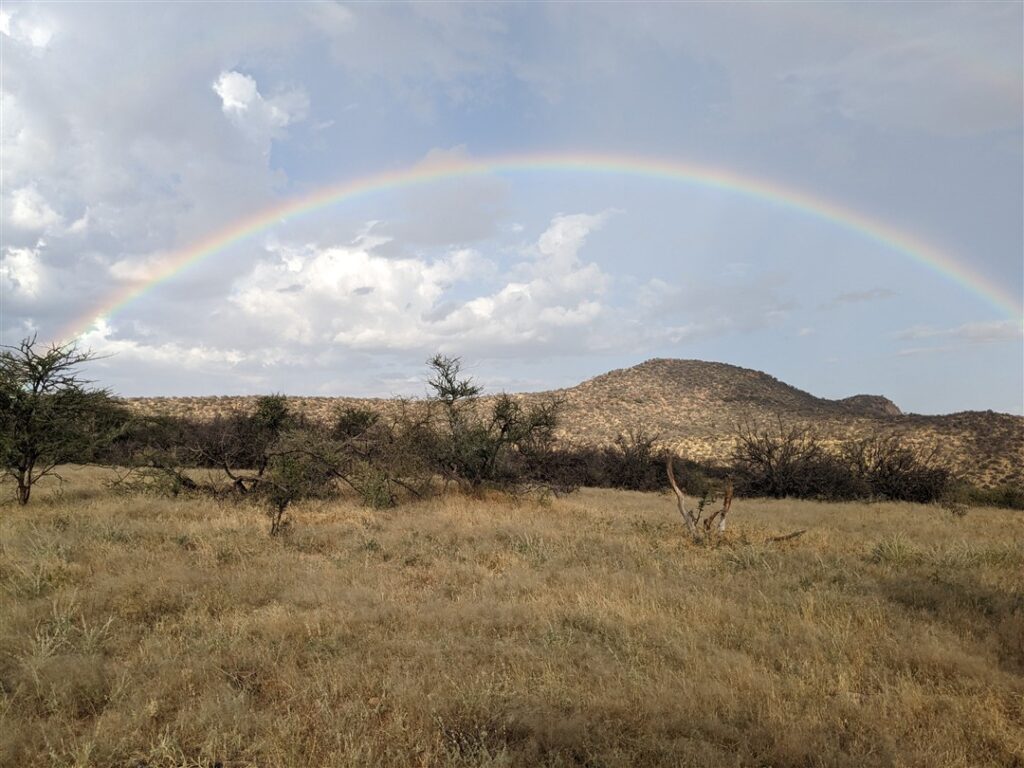
After going to bed well before 9pm, Becky and I didn’t sleep particularly well. Becky and several others noted the noise of a car trying unsuccessfully to start in our room’s center courtyard at about 2am. Some were worried that, since one of our vans had been left there overnight–which was not common–that it might not be running at all, and we’re worried about any impact that would have on our trip that morning.
Most of the team was at breakfast shortly after 6:30. We reiterated the plans for day. Some confusion still existed concerning remaining payments for the weekend. Nderitu told us that we would be stopping for cash at one or more ATMs along the way and that we could settle up that way. He also sent. WhatsApp message saying that he and the drivers would be arriving at about 8:15.
The slight delay gave us all plenty of time to pack, haul our excess baggage to storage and prep our laundry. We all put our safari luggage in the courtyard and I consolidated five liter water bottles from each room into three full bottles as well as topping up everyone’s individual bottles. Nderitu, Patrick, and Isaac arrived at 8:30 and we chatted about the plan, packed the vans and left.
About an hour into the drive, we stopped in the relatively large town of Nanyuki ostensibly to get cash for the weekend at ATMs. There was also a grocery store at the mall where we stopped and a few went in to get soft drinks. Others shopped a little while we worked through some of the issues getting cash. Inconveniently, the ATM we used only honored Visa debit cards. There was also a limit on our withdrawals meaning that we couldn’t pay all we owed to Nderitu for the weekend. He agreed to accept most of our payment in cash and then we’d relay the rest to him via Venmo.
He told those with MasterCard debit cards that there was another ATM they could use nearby. Meanwhile, Bonnie found some shoes in a shop in the mall that she wanted to buy. The shop wouldn’t accept USD, so Nderitu went in to help with the transaction.
We left the mall, went to the next ATM and we’re off again. At one point, we stopped along the road for photos of Mt Kenya. The road continued to climb and the farmland became more lush and verdant. We saw huge fields of mustard, wheat, barley, potatoes, and hundreds of greenhouses growing table vegetables and flowers. I checked GPS and realized that we were over 8500 feet and on the wet side of the Mt Kenya’s slopes.
We created at just above 8500 feet and then began to head down the leeward, drier side. We descended over 4000 feet to a very arid terrain that included a herd of camels along the road, many more goats, and brahman cattle. The people seemed to change as well, with mosques appearing and more women wearing head coverings and flowing robes. Many men wore Muslim kufi caps.
The trip seemed to get longer as we went, with our time to arrival on Google maps decreasing very slowly even as the kilometers clicked past.
We crossed the Samburu River and the town nearest the gate to the Samburu National Reserve close to noon and then drove several kilometers to the large entry gate structure painted in a giraffe-like pattern of brown and white. Nderitu registered us and got our 48 hour permits in about 15 minutes and we began the nearly 20 km dirt road drive to the Samburu Sopa Lodge.
Nderitu told us that our first game drive and begun and he was not kidding. We expected the drive to the lodge to be exactly that and nothing more, but only a couple kilometers in Isaac pointed out a Generuk, also called a Giraffe Gazelle, grazing on an acacia tree’s leaves. Isaac told us that this gazelle is so well adapted to the dry Samburu environment that it never drinks liquid water and is able to survive on water from only the vegetation it eats. Very soon after that, we saw a large male ostrich in the road ahead followed by what looked to be a dozen young ostriches. We followed the large black and white bird for a short time until we saw his all gray female mate and then looked farther up the road to see the necks of several giraffe. The ostriches crossed the road and grazed between us and the giraffes.
The were four giraffes in the herd, with what looked like a large male, two females, and a younger calf obviously attached to one of the females, its mother. Isaac explained that these were reticulated giraffes, well known for being unique to this region and park. They were a little smaller than the common giraffe with more clearly defined brown patches among thinner white bands. They seemed to pose for us, oblivious to the ostriches nearby.
Only a few hundred meters farther, we saw a large gathering of Thompson’s and Grant’s gazelles and then, in the distance, three oryx, one of the signature species of Samburu.
We continued along the dirt road, occasionally seeing rock markers indicating our distance to the Sopa Lodge as well as other lodges in the park. I’d guess that we were averaging no better than 20 km per hour on the very rough road, and I expected that the ride in would easily take an hour–which it did.
Along the route, we saw another small heard of giraffes, including one large, very darkly colored male. We also saw Impala, more of the Grant’s and Thompson’s gazelles and what I thought was the rather surprising sight of a pair of dik diks–the smallest of the antelope in Africa.
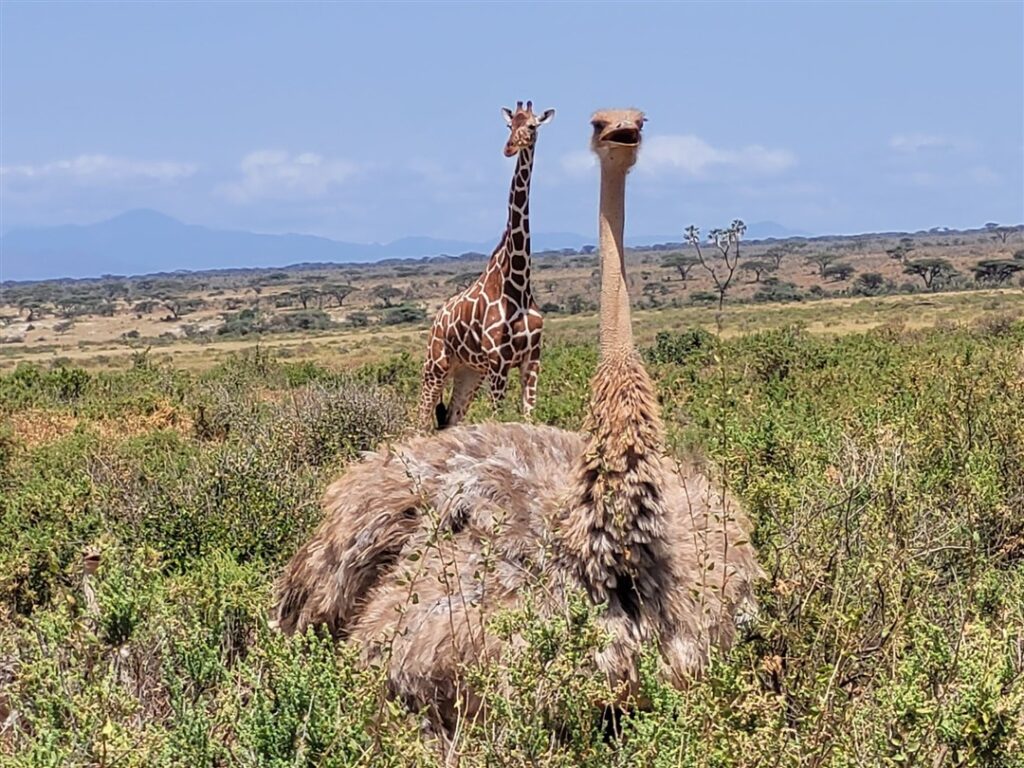

Once we entered the park, Isaac and Patrick had popped the roofs on our vans, putting them into full safari mode. We could stand up and clearly see between the frame of the van and the roof now about 18 inches above us and providing welcome shade. With temperatures now in the mid-80s Fahrenheit (about 30C) and the dry air, the breeze from driving and the shade were welcome.
We continued to see different gazelles along the way as well as a larger herd of oryx that were much neater than the first set. I was using my loner Canon RF 100-500mm f/4.5-7.1L lens loaned to me by Mike Cutler and Canon Professional Services for the trip. It was mounted on my Canon R5. The lens performed quite well, though it’s autofocus was a little balky when fully zoomed, taking some time and manual zooming out and in to acquire the subject. Eventually, I learned how to work it more quickly, but it seemed to limit my reaction time, especially if the target was moving.
The terrain was gently rolling and grassy with many acacia trees and low shrubs leaving no large areas of completely clear savannah. The grass from the recent rainy season was a light golden brown except in a few areas near dry wash areas that had seen more recent flows. The acacia trees were a tangle of leaves and thorns with many showing signs of damage from elephants, breaking limbs, scraping their tusks on the tree trucks, or simply pushing over some of the trees–including some that were surprisingly large.
We finally arrived at the lodge we’ll after 2pm and went directly to a late lunch. The Sopa was one of about ten safari and touring lodges owned by the group and operating in most of the major national parks and reserves in Kenya and Tanzania.
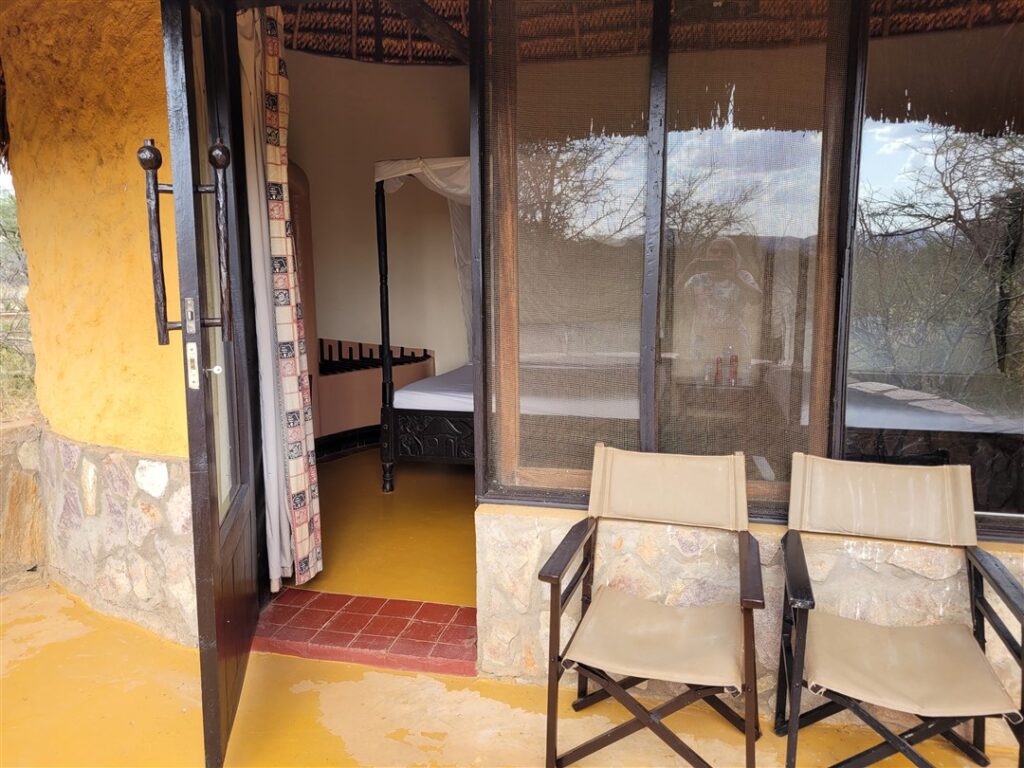
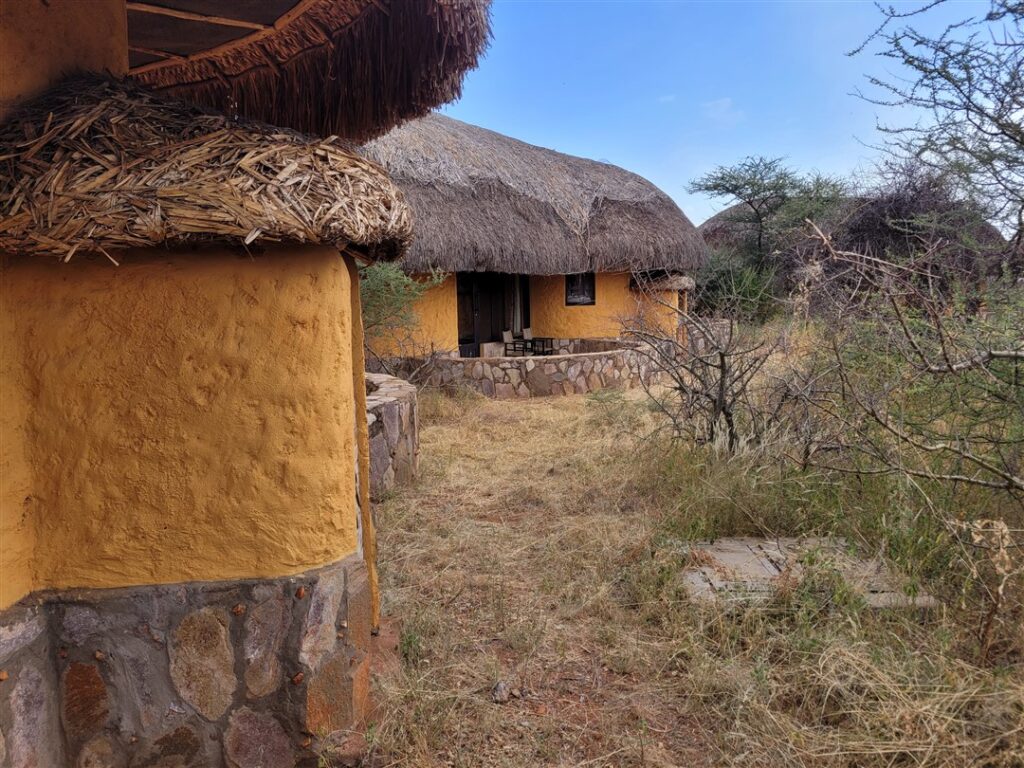
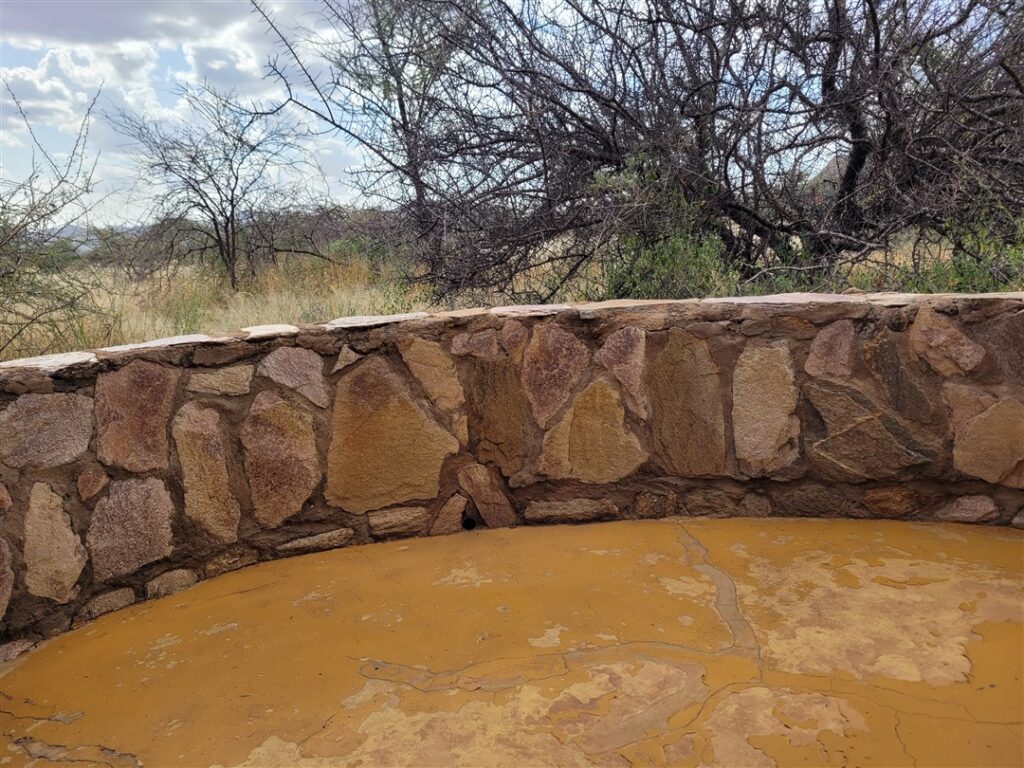
We stacked our bags at the entry when we went to lunch and enjoyed quite a varied selection at the buffet. Our meal included two meats and fish, soups, salads, condiments and sauces, vegetables and starches. There was also dessert with the meal. We all ordered bottled water only later to learn that soft drinks were not included in the meal, though coffee and tea were. The waters were charged to the rooms.
After lunch, we met Nderitu and he proposed going out on our evening game drive at 4:30. We agreed to a 4:15 show time and everyone gathered their bags, with the help of porters, and went to our rooms.
The main hotel reception and lobby were covered by a huge thatched roof structure supported by both wood and concrete pillars. Seating in the dining area looked to be about 75 and the entire area was open with dozens of tables and chairs connecting the dining and bar areas. There was a large, sparkling swimming pool and low concrete/stucco and wood railing walls surrounding the thatched structure.
Our rooms were west of reception and consisted of 15 duplex rooms, each with stuccoed concrete walls, a thatched roof, a small walled patio in the exterior side, and large beds with mosquito netting. The floors were tiled and the beds were large four post frame with full mosquito netting. Our reception helper told us that we should only leave the windows open when we were in the room (even though they had what seemed like sturdy screens) because of the local baboons that would occasionally ransack a vacant room.

After relaxing, we left for our evening game drive close to 4:30pm. We saw one single male giraffe not too far from the entrance and then headed downhill and toward the Samburu River. Quite quickly, we saw many gazelle of different varieties (Impala, Grant’s and Thomson’s) including what seemed to be a pair of dik dik about every 200-300 meters. We also saw a pair of large warthogs running across the road then the uphill terrain to our left. I managed to snap off a couple of shots.
As we approached the river, the vegetation became more lush and green with tall trees, including golden palms, lining the river bank. We saw turnoffs for other lodges that were along the river and lots of signs of elephants along the way (manure, broken limbs, etc).
We saw a herd of waterbuck on the way and Isaac told us how we could identify them by the black circle in their fur on their backside. That description coincided with him telling us about the nickname for Impala, “McDonald’s” because of a similar black “M” on their butts.
Near the water, we passed through a very tight spot on the now sandy trail and turned to a very large tree that all but exploded with baboons. They came running down the tree and moved off in a large troop along the road on the ground. Some were already on the ground and we saw a variety of ages and sizes including some very small babies clutched to their mother’s chests or older ones on their backs. One large male seemed to almost stalk the van giving us the evil eye as moved on.
The clearing also held several Impala and, surprisingly, a female kudu. She was quite large and with a bluish gray coat with about a half-dozen vertical light stripes.
We drove farther along the river and then away from it towards a large ridge. We saw plentiful of gazelles again as well as guinea fowl, a wide variety of birds, including hornbills, a type of goshawk, and weaver bird nests in virtually every tree. The “splendid starlings” with their iridescent blue-green wings were widespread. We stopping bothering to photograph or even bother identifying the dik diks they were so common.
As sunset approach we began our return trip to the lodge. We saw several vehicles along a fork in the trail and up near a ridge. Isaac told us that a leopard had been spotted near there earlier in the day. We looked closely ourselves and I used my 800mm lens to scout the distant trees for a big cat, without success. After a few radio calls, it was decided that if there was a leopard in the area, it had hidden itself too well to be spotted by anyone.
We continued back to the lodge as the sun set and we were rewarded by some excellent views as the sun hit the horizon just above the Samburu River.
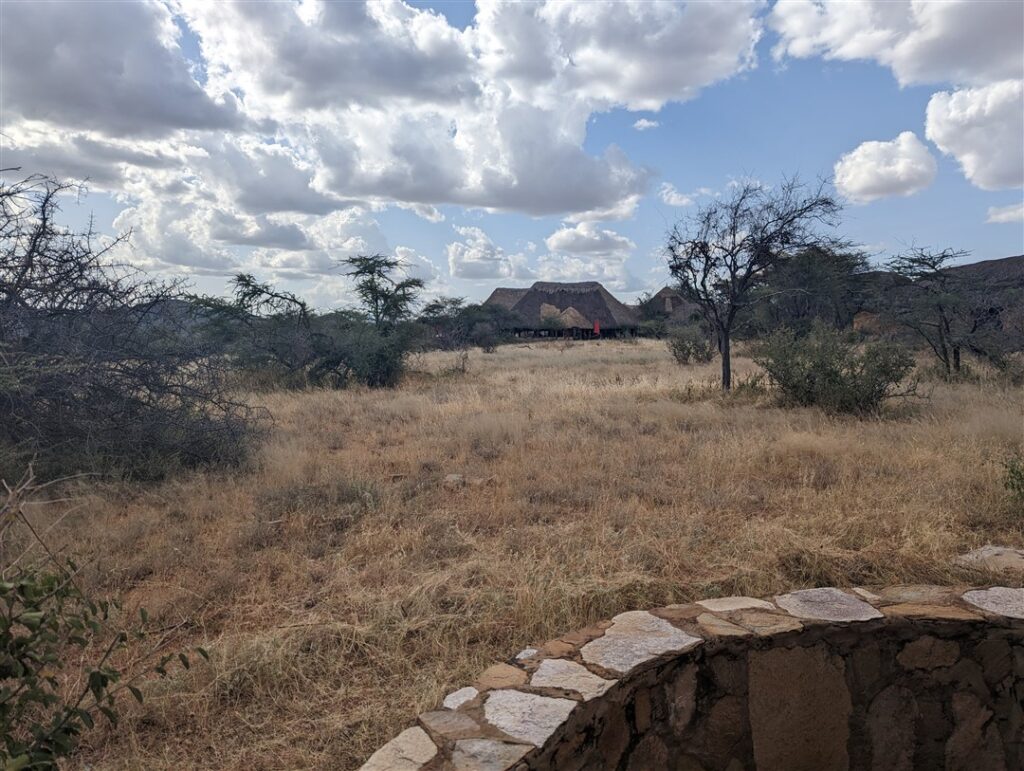
As we drove up the hill to the lodge, we saw another large troop of baboons moving through the grasses slowly grazing.
We arrived at the Sopa Lodge at about 6:45pm and agreed to meet for dinner when it opened at 7:30. I grabbed my laptop and set up on the bar where the tenser could plug in my laptop charger and ordered a White Cap lager. The bartender, whose name was Christopher, was an engaging guy who asked me about my photos and our overall trip and experience in Kenya. When I described our DWC work, he told me that he had big interest in doing something similar by forming an NGO. I suggested that he talk to Nderitu about how to do that.
Most of the others gathered around a low table in the bar area and enjoyed either.a beer for some wine. All were very happy about how the day had gone, especially having seen giraffe, oryx, ostrich, and so many gazelles. We had not yet seen an elephant or a big cat, but Isaac assured me that he would do all he could to help us see a cheetah or leopard the next day.
I finished post-processing about 200 photos and was pleased with several shots of an Impala mother with her baby. I also like the kudu and baboon photos. We were all just a little disappointed to not see either a big cat or an elephant, though. That regret was magnified when one woman from another group spoke loudly about how cool it was to see a baby elephant taking dust bath earlier in the day.
Dinner was even better than lunch with too many choices to describe. Kenya must be the land of good creamed soups because they were just as good here as at the Lusoi. We had a cream of broccoli this night and a creamy potato leak the next evening. The meat and fish selections were good and again we had some Indian-styled dishes.
At dinner Nderitu spike to us about the next day’s plan. He proposed leaving VERY early at 6:00am and then coming back for breakfast. Most of us wanted to have at least coffee and a snack before heading out, so he arranged exactly that with the staff and then told us it would be ready starting at 5:30. We all agreed to be ready to go at 6:00 and returned to our rooms for the night.
We plugged in as many devices as we could, aware that power would go off at 11:30pm and stay.off for six hours until 5:30am the next day.
10 June 2023
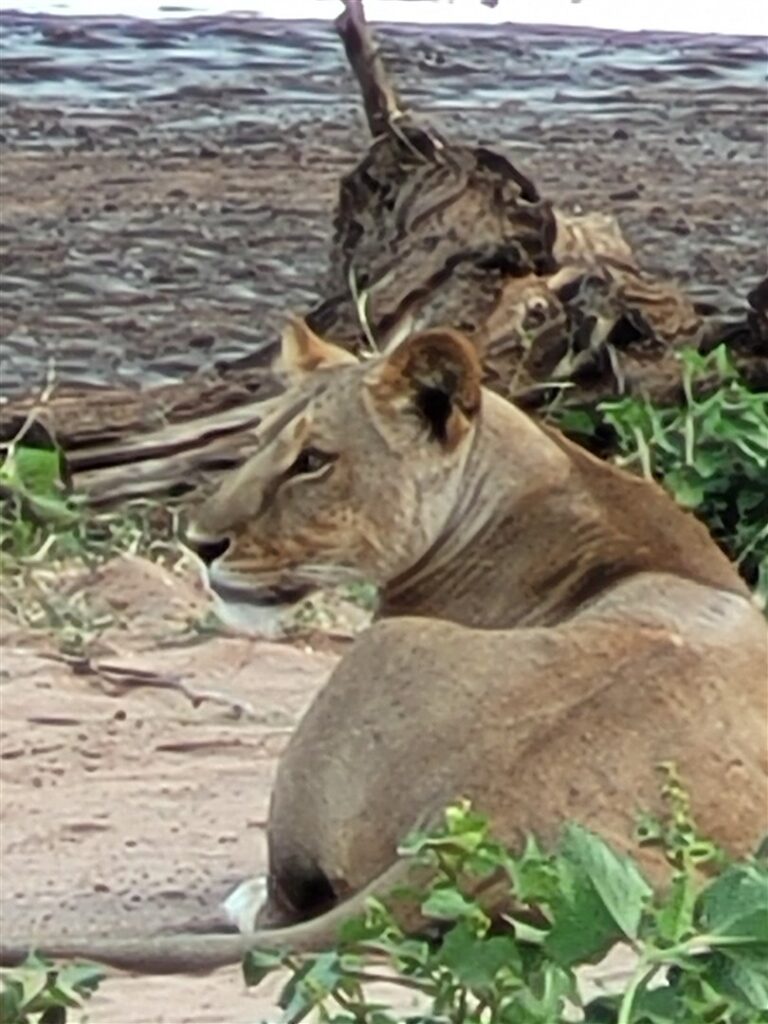
Becky didn’t sleep very because of the hard mattress. My evening’s sleep was better but not great. Happily any room visitors we had were small insects and apparently no mosquitoes. It was quiet all night except for some moderately strong wind early in the morning.
The sky was lightening quickly when we went outside and temperatures were cool and comfortable. The reception staff looked like they were ready with the coffee and cookies, so we slammed the drinks and cookies and headed to our vans, leaving just a few minutes after 6am.
Right out of the gate, literally, there was a single, young, male giraffe. It was casually munching on acacia leaves and seemed unperturbed by our presence. We retraced most of our path from the previous evening but then went even farther into the brush and uphill from the river.
Suddenly we saw elephants. Lots of elephants. Some were walking directly towards our van. When they passed small clearings, we saw younger elephants ranging from what Isaac described as a one-year-old to some juveniles that looked the same age (about 3-4 according to Isaac)still accompanying their mother’s who looked like they could be sisters. Isaac said that it was normal for a family group like this to stay together, led by one female that would be either the mother, grandmother, or aunt for all of the others.
We carefully followed the elephants as they made their morning route down from the hills to the river. We turned off to their left after about fifteen minutes and went directly to a stretch in the river where we saw four maribou storks and a tawny eagle as well as several Vervet monkeys on the ground and in the golden palms trees. We also saw many others feeding on vine leaves in addition to plenty seeing plenty of hornbills and a large vulture’s nest at the top of one tree.
The trail suddenly broke open onto the river and we saw our original herd of elephants coming straight toward us. They passed one-on-one in front of and behind us and ten walked as a group across the river, stopping occasionally to drink from the shallow stream of water that was no more than 100 meters across.
Once crossed, they fed on leaves and small.limbs but also occasionally all froze in unison. Isaac explained that they can hear and feel the vibrations caused by other nearly elephants and even identify them by their seismic impact on the ground. Each of these episodes seemed to last between about 15.and 30 seconds and then they would continue feeding, using their trunk to throw sand and dust on their back, or interacting with each other. One of the babies nursed from its mother.

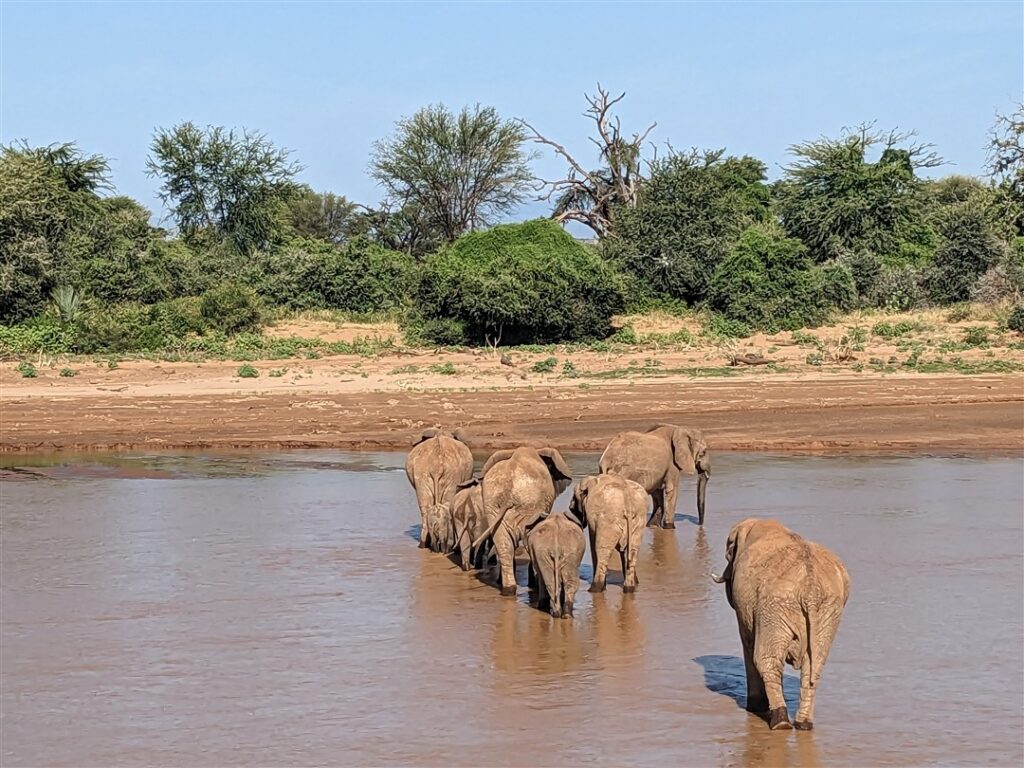

Soon after one of these frozen moments, we were surprised to see a single young male elephant appear in front of us on our side of the river. He turned right and crossed and was then greeted by a similarly-sized.young male. Isaac told us that they would sooner be older enough to leave the pack on their, but that they still were members.
The two young males seemed to interact by curling their trunks together and getting very close. They seemed to be almost caressing each other until a bit a shoving began. The intensity of the shoving increased until it seemed that one (the smaller of the two by a little) was trying to push the late-comer away from the family group. He succeeded in almost pushing his challenger back to the river, but the larger male stiffened his resistance and pushed his smaller cousin up the embankment and into the trees with the rest of the group until they’d all disappeared from our view.
Satisfied with our excellent elephant experience we toured along the river some more and saw still more monkeys and birds. We worked our way back uphill and took a different route and ridgeline back to the hotel, seeing mostly birds along the way.
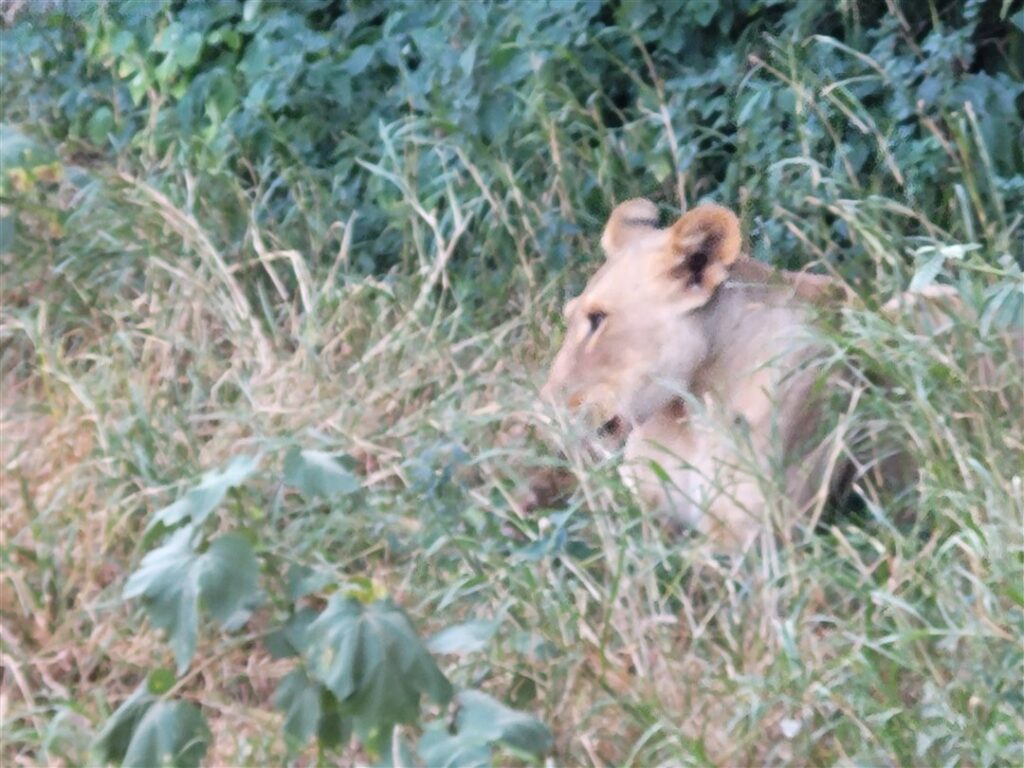
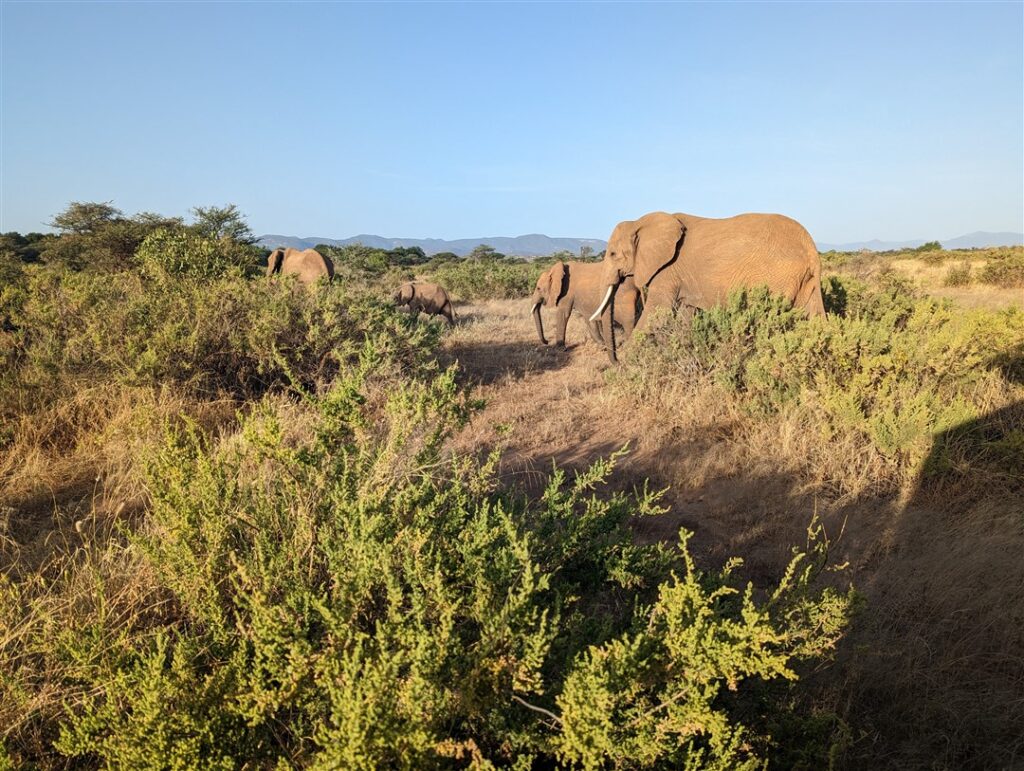
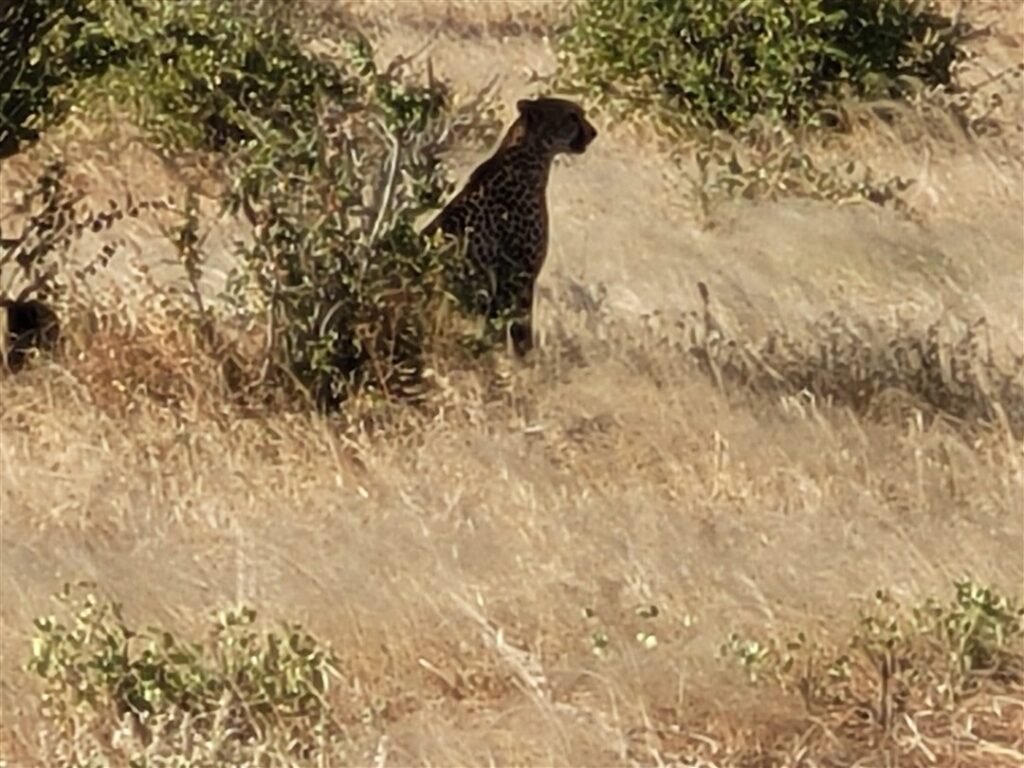
We returned to the hotel at nearly 11, again very happy with what we had seen. There were still some food items left out from breakfast and some got a late morning snack. Nderitu said that he wanted to go out much earlier for the afternoon game drive so that we could go farther along the river and deeper into the park. He proposed leaving at 3pm giving everyone a chance to relax and enjoy lunch.
Again, I post-processed photos, but then went for a short swim in the pool. The sun was very warm in the deck and I dried quickly. There were two varieties of reptiles also sharing the pool area–a red-headed lizard and a type of striped skink. Vicky sat by the pool and dangled her feet in, but no one else came out.
Mark was using the time and sparse wifi to do some work. Vicky and Val hit the gift shop and bought matching t-shirts that showed the English and Swahili names for over a dozen common, large, African animals and they also enjoyed a Tusker. Becky relaxed and read, while Margaret joined us for quite a while.
In the midday sun, one of the baboon troops took up residence in and around a large acacia tree and the lodge’s cement-lined game pond. They came down to drink alone or in small groups of two or three, sometimes with a baby riding along with its mother.
Lunch was again very good with a creamy green vegetable soup along with Tilapia filets and some more Indian dishes, pasta made to order, and a beetroot and paw paw salad.
Following lunch, we prepped for the afternoon game drive in our rooms and all returned at 3pm. Bonnie told us that she was feeling particularly tired and had decided to pass on this trip to get some rest.
Again, very near the gate we saw a single, young male giraffe. I didn’t know if it was the same one as in the morning and took a mental note to compare the patch patterns on my photos from the two sightings. Becky spotted several more across a valley as we drove along, but they were too distant to photograph effectively, even with the 800mm lens.
We followed much the same route as in the morning, but, as promised by Nderitu, we went still farther in. This time, we seemed to see elephants everywhere. We would turn a corner and see several. Most seemed to be in the thick, viny vegetation near the river and we could see them tearing out huge bundles of the vines with their trucks and then stuffing it into their mouths.
Farther upland, we saw several gerenuk antelope and some large herds of Impala. Isaac was intent on finding a big cat and he listened closely to his radio to get information from other guides in the area that might’ve located one.
At about 4:30pm, we hit the jackpot. Isaac got word of a cheetah and we went to where one safari vehicle was parked about 40 meters from a small acacia tree. Sitting in the shade of the tree was a single cheetah. As we watched the cat for about ten minutes, though, we realized that she was not alone and that she had one, then two, and then threecuns with her. They moved around her mostly in the shade.
A few minutes later the other safari van moved in, content with having seen a big cat and resolved to the thought that she was going to stay out in the shade.
They were wrong. Not two minutes after they left, she stood up, yawned, and did the longest cat-stretch ever while one of her cubs pawed at her. Then the other two appeared and she started walking slowly out of the shadows and from our left to right. The three cubs followed her in single file, but then she stopped, looked over her shoulder and a fourth popped out from under the tree to join her and its siblings.
We moved the vans backward about 100 meters to a main trail road that we thought she intended to cross. A minute later, she did exactly that. She and the four cubs stopped at the edge of the road. She carefully looked both ways, and then she crossed alone. Once on the other side, she must’ve given some signal, the cubs came over one-on-one. The fourth again lagged, but she waited for all to join her before turning again and walking into the brushy terrain. We lost her in the low, but dense shrubbery a few seconds later. By now, I’d taken over 125 photos of the family and we were all elated by the magic of the experience. For a photographer, it was just a dream come true.
We continued along the road as we approached the “golden hour” for photography, the 60 minutes before sunset. To our right, in the distance, we saw what looked like our morning troop of elephants from the river heading into the Highlands for the night. The light seemed to be changing every minute. We had far off mountains as a backdrop as the elephants seem to wade through the brush that was belly high on the adults. We could only see the very tops of the youngsters and the two babies were invisible until they crossed the road ahead of us from right to left.
After capturing another 20 or more photos and saying “good evening” to our friends, we went back along the main road, past “leopard ridge” without seeing anything, and back down to the river. We saw a giraffe munching tender top leaves of the trees and a couple of elephants.
We drove to the bank of the river and saw three safari cars with everyone standing and looking towards the water. Someone said lion and I looked to the far bank, expecting to see a lion lapping up some water. I was shocked, though, to look 20 meters in front of me to see a single, young lioness laying in the grass, gazing across the river. She seemed to be enjoying the cool, calm, sunset air and spreading shade from the bankside trees.
A couple of the safari vans left, while one more pushed in far too close. Isaac told us that the other car was breaking the rules by going off-trail to move too close to the lioness. Our patience and obeisance to the rules paid off a moment later when the lioness got up and walked past the offending van to lay down in front of our van parked on the trail. A moment later, a second lioness, nearly identical in all respects to the first, emerged from the tangle of vines in our right to face the first lioness. The newcomer has even brought an appetizer–what looked to be a small mammal (maybe a dik dik) in her jaws. She layed down and began eating. The first lioness watched, but didn’t approach any closer than about two meters.
Isaac started the van and we moved out now, ourselves feeling too close to the action. We drove less than a half-kilometer through the very dense jungle and saw elephants almost everywhere we turned. In one small open patch three seemed to be fighting. They were flapping their ears, tusk-to-tusk and more than one was bellowing. Another elephant turned a full-360° stomping the ground and kicking up just, obviously agitated by the commotion, but disengaged from the fight. It seemed that we were too close again and Isaac moved us away.
By now, sunset was near and we began the drive back. We saw the typical collection of animals (still no Grevy’s zebra!) And enjoyed the colorful sunset over the river. We took photos of one last pair of dik diks and then saw a very large male Impala walking along to the right side of the road. Following this beautiful creature in a very dense pack, but about three meters behind, we’re about 20 identical females. It looked like this guy had clearly won all of the duels with local rivals and now had 20 adoring groupies following him. Lucky gazelle.
It was nearly dark when we returned to the lodge. As usual, in the dark, a security guard escorted those going to their rooms. Some headed straight to the bar.
I went to the room and grabbed my laptop and power cord, intending to return to Christopher at the bar for post-processing. I did stop off in lobby on returning, though, to show off a few cheetah photos on the camera.
Christopher started me with a Tusker as Becky orders a bottle of Australian Rosé, Mark ordered a bottle of white, and most of the team gathered around the bar table to chat.

Bonnie came by and the team, feeling a bit sad that she’d missed the big cats, seemed a little sheepish about describing the afternoon. She came to me and said that the group had told her that they hadn’t seen any zebra and that she could see photos on my laptop. She came over, did just that, and actually took the news pretty well. I showed her most of the shots and explained my post-processing philosophy to her and we reviewed many of the photos from the afternoon.
Christopher and I chatted more about the day and he got me a White Cap as I continued working. As soon as the cheetah photos were done, I exported them to jpeg format and started on the others. I tried to upload some to Instagram and Facebook, but the wifi bandwidth only allowed a very few to make it through the electronic eyelet.
I broke for dinner and joined the team, leaving my laptop behind to export and process most of the remaining photos.
Dinner was excellent again. I’ve already described the soup, but the salads and other courses were as good as the previous three buffets. Margaret tried the cardamom pudding and seemed to like it. I had pineapple and cheese for dessert and also helped finish the rosé. The team was tired but happy again.
While I was working on photos, Becky and the other team members worked out the Sunday.plan with Nderitu. We would settle our accounts with the hotel that night and be ready for breakfast first thing at 6:30am. We’d plan to leave no later than 7:30 with all of our bags loaded for an exiting morning game drive, then visit a Samburu village of pastoralists just outside the gate. After that, we would head back to the Lusoi Lodge after a lunch stop in Nanyuki.
I stayed in the lobby trying to use the wifi and having another beer to finish processing the 500-plus photos from the day and didn’t return to the room until 10:30pm. In that time, I was only able to load about 15 cheetah and five lion photos. I sent a few individual shots to the team and DWC via WhatsApp, too.
11 June 2023
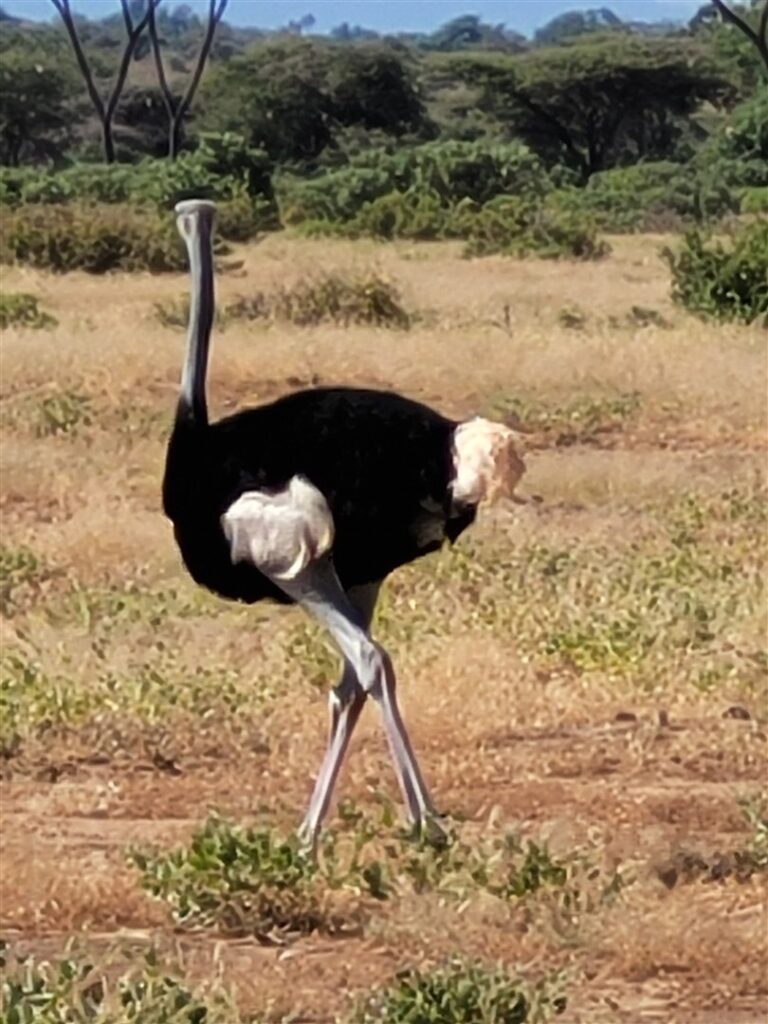
We woke up, as usual, before the alarm and packed our gear, then went to breakfast. We took some photos of the lodge in the pre-dawn light. At reception, I made my usual attempt to use the wifi and load more photos with some success while Becky got coffee. Others had already brought their bags from their room and we had an area reserved for us. All of us were there for the 6:30 breakfast start and we enjoyed the cool air and good food. We had a pitcher of pourable plain yogurt in addition to omelets to order and oatmeal that was labeled “porridge.”
The team was ready for check-out and loading onto the vans on time. Bonnie told me that she couldn’t find her credit card and that she’d brought only one. Her phone wasn’t set up to use Apple Pay or another contactless system. We talked through when she had last used it and she used the wifi to connect to her card company and saw that the last charge she had made on it was for wine when we left Nairobi. She did say that she had a debit card and I told her that she could use that to get some cash, if needed. She thought that she may have left it back at the Lusoi or maybe it was somewhere in a pocket or other bag.
All packed and ready, we left at just after 7:30 heading for a combination of game drive and exit. A park ranger was with us, too. He’d asked for a ride to the park exit and ranger camp that was located there. We saw some of the usual animals along the way to the river and also stopped at the Samburu Lodge for what we thought was going to be a fuel top-up for one or more of the vehicles. The Samburu Lodge didn’t seem to have any gas or diesel, though, nor did it have any patrons. We just saw one or two groundskeepers and a couple of Vervet monkeys.
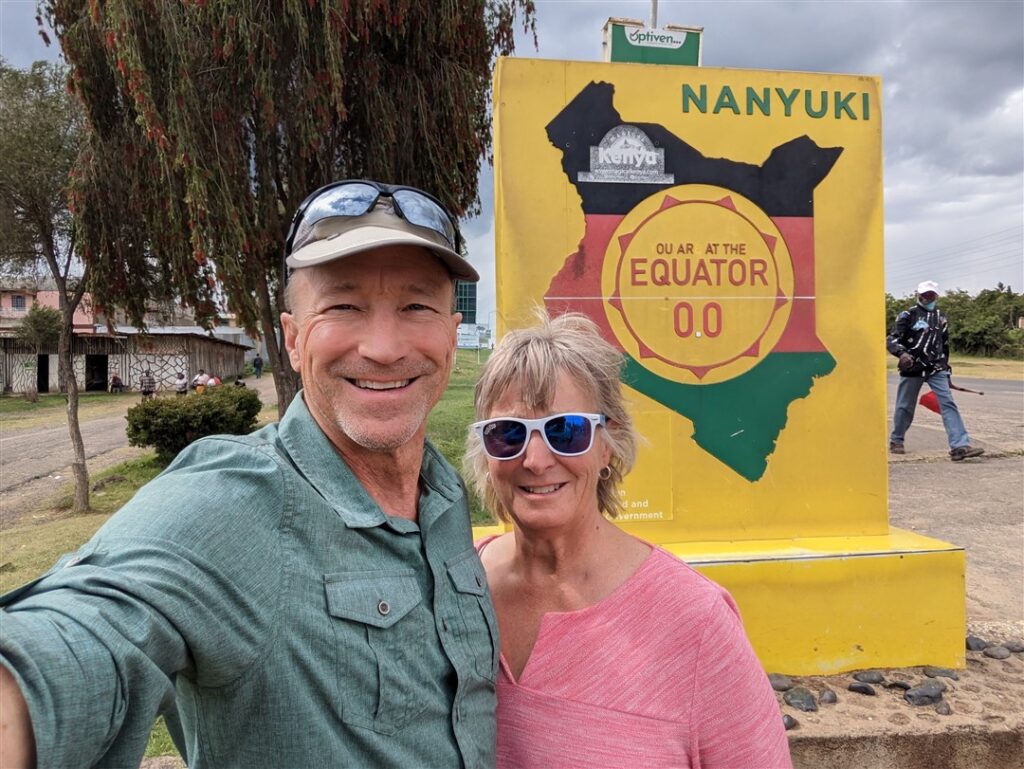

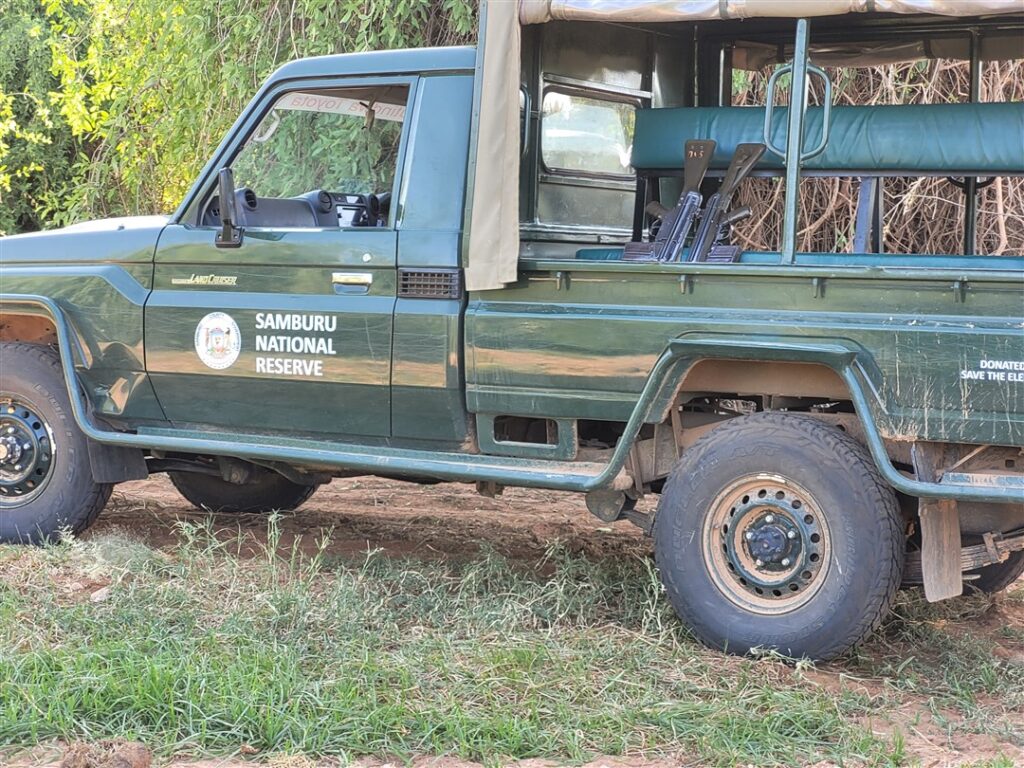
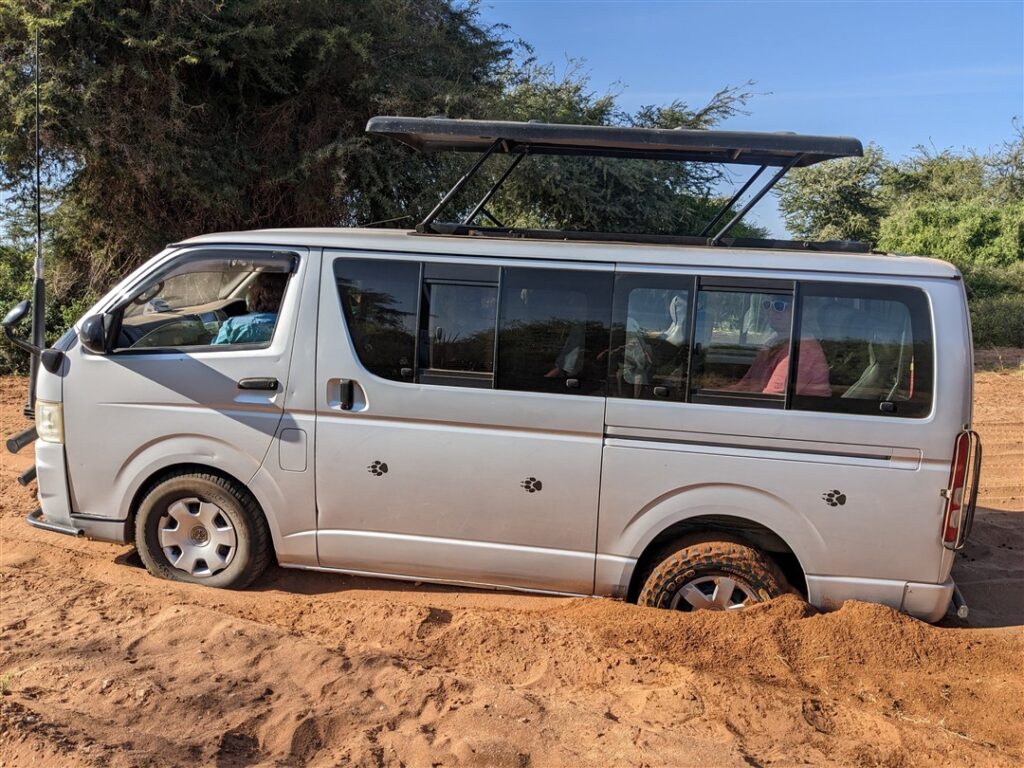
On exiting the lodge and moving through thickets and on sandy soil near the river, we came upon another safari van that Isaac had to wait for at a small intersection. The pause was critical as we were now in very deep sand. When he hit the gas softly to get us moving again, the back wheels just spun and the left rear wheel dug in. The other safari van continued on, oblivious to the fact that it had caused us to stall. Isaac tried his best, but we were stuck. Patrick and Nderitu came over from the other van and we tried to dig out the wheel a little, to put branches and leaves (and even floor mats) in front of the wheels, but the vehicle’s center was now resting deep in the sand and we could get no traction. We tried pushing with five of us, but had no luck. The other van, also two-wheel-drive, was about 30 meters in front of us. It didn’t dare back into the same sand and our tow rope was not long enough to reach.
Patrick, Isaac, and the ranger (armed with a long rifle) called the park rangers on their radios and I was shocked that they responded so quickly in such a large park. Within five minutes a four-wheel-drive safari vehicle with the Samburu National Reserve emblem on its side arrived. Another sign noted that the vehicle had been contributed by the Save the Elephants Foundation.
The driver and six armed rangers got out of the car and came over to help. The situation was obvious and our team attached a tow hook and line to both vehicles. About eight of us pushed from behind our van as the ranger vehicle began to pull. The other passengers (Margaret, Becky, Vicky, and Valerie) had left the van to make it lighter for the pull. The van was pulled out in no time at all and Isaac drove it to more stable ground.
We asked about the rangers while we were there and Isaac and Patrick told us that they patrolled the reserve 24/7. They also added that poaching had dropped precipitously in recent years since the government had instituted a “shoot on sight” policy for poachers. After dark, anyone in the park, not in a lodge, was presumed to be a poacher. I didn’t ask how many had been executed.
The game drive continued and we moved to a very open area in which we saw a male ostrich and three warthogs grazing. From there, we moved back to the area in which we’d seen the female cheetah the day before and saw a parked safari car in the general vicinity. They were clearly looking at something and when we got nearer we could see the female cheetah again sitting in the shade of a small acacia. We could not see her cubs. The same ranger van approached the area, too, making sure that all rules were obeyed. As we moved closer and stopped, the cheetah laid down in a hollow area beneath the tree so that she was only barely visible–only what looked like her ears stuck out. The other safari van left, but we stayed for a few minutes more. I had the 800mm lens and was not sure what I was photographing in the shadows, but hoped to know more in post-processing. She did lift her head a few times, but we could see little more. Clearly, Bonnie was very happy with our luck of seeing the mother cheetah a second time.
From here we headed more directly to the park exit again along more open ground hoping to get a glimpse of a Grevy’s zebra. We saw what looked like the same ostrich family we’d seen on our first afternoon as well as many solitary male gazelles and a few generuk.
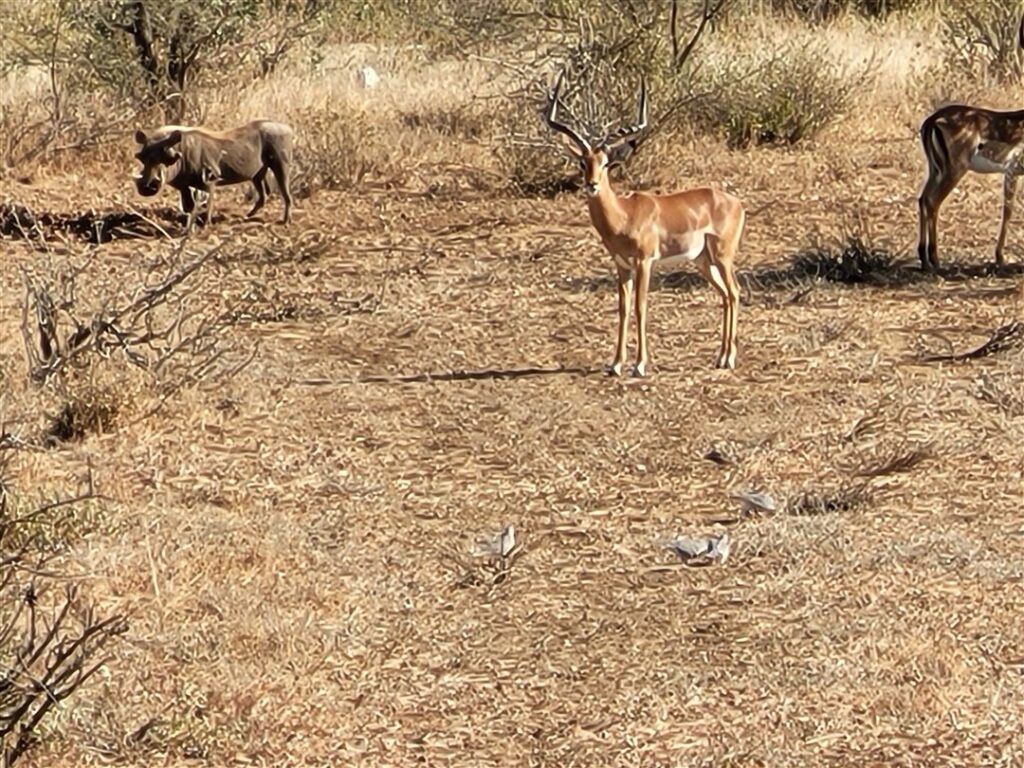
This area was very dry. We didn’t see any oryx or giraffes after the ostrich family, but just a few kilometers from the exit, the front van stopped and all looked out to the right. We heard the word zebra and I grabbed my camera to snap just three photos of the elusive (to us) Grevy’s zebra–a solitary male– walking away from us. What a relief! It was a healthy, large animal, noticeably bigger than the common plains zebras that were so plentiful in Tanzanian parks during our last East African visit.
Of course, when we realized how close we were to the exit (we arrived less than ten minutes later) we joked Isaac and Patrick that they’d called ahead to the rangers to have a zebra released on cue.
At the exit, Nderitu signed is out and we drove just a few hundred meters to a camp of the Samburu native pastoral people–close relatives of the Masai who spoke the Maa language. Nderitu had arranged this visit with the help of Isaac and it was the first time a group he’d led to the area had done so. We arrived at about 10:30 and were told the cost of the visit would be $20 US each.
The male leaders of the village greeted us along with a few dozen other adults all colorfully clothed. The leader collected our fees and said it would be $20 US or 2000 Ksh each. The latter is the equivalent of about $14 US, so I paid with schillings for Becky and me.
While we were paying, members of the community went among us and put necklaces, beaded collars (around some of the women), and some beaded head decorations. They explained next that we would see two dances accompanied by songs. The first would be the “Lion Song,” as was sung before any hunt to kill a lion that had attacked their livestock. The rhythmic chanting was accompanied by a male member of the group jumping vertically and every singing and swaying.

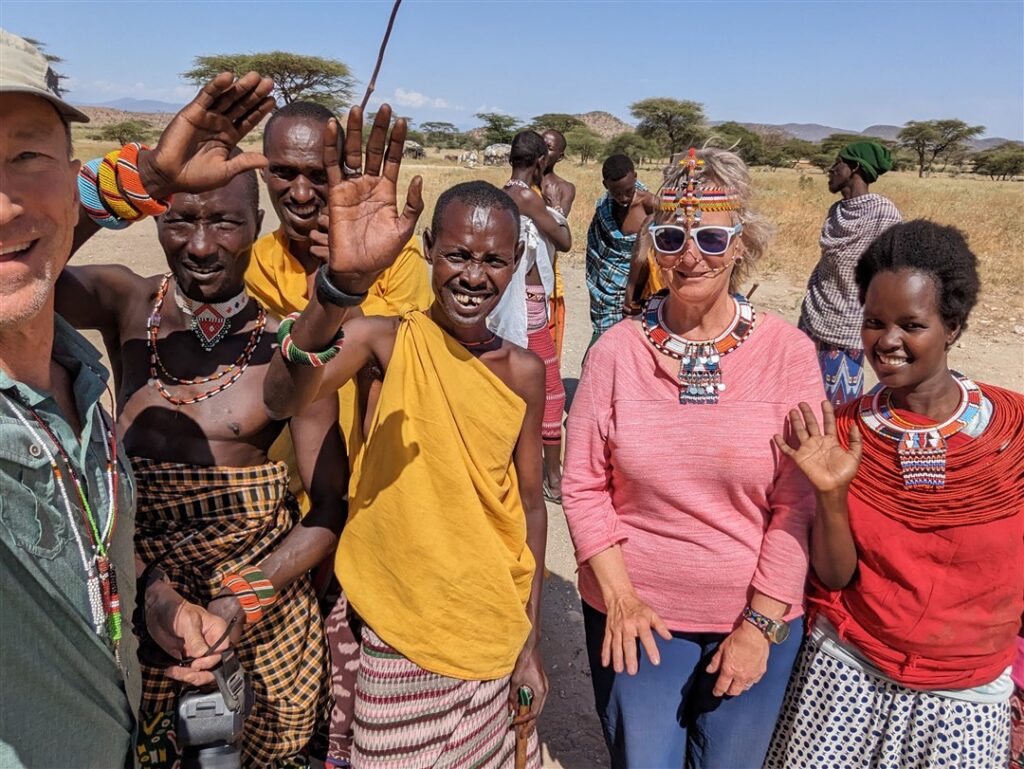

The next song was for both men and women and involved them taking hands and moving in pairs in a circle while singing another very repetitive set of lyrics. One female member of the group led Becky into the group and escorted her around the circle.
By now there were many local spectators and lots of small children. Margaret tried to interact with the children and they came closer to her, then would run back to their parents.
After the singing and dancing, we broke into two groups with each led by what we presumed was a senior male leader of the community who also spoke good English. Our leader said that his name was “Tispi” (I think). He seemed to be in his 30s.
Our leader explained that this was the largest of ten Samburu communities in the area with roughly ten families and a total of 250 people. They herded cattle, goats, and sheep and had some cages with chicken. He said that they didn’t eat the chickens but sold them to buy vegetables for the children. He said that only the children each vegetables and that adults only ate red meat, cow or goat’s blood, and milk from their goats and cattle.
There were several dogs around, but Tispi said that they were “on siesta” but would otherwise be used for herding the animals.
He said that the camp really didn’t move, but that young men would take the herd up into the mountains as far as Mt Kenya during the dry season. Otherwise, the animals grazed in the area and would go down to the Samburu River for water twice per day. Almost on cue, a large herd of mostly goats went past us in the direction of the river.
Tispi said that the women were responsible for constructing the homes that were more or less rounded rectangles made of sticks about five feet long lashed together with twine or strips of goatskin that curved up to form a domed roof no more than five feet high. The average guy looked to be about three-by-four or five meters for a total of maybe 12 to 20 square meters or 120 to 200 square feet. The frame pieces were about five centimeters apart and no more than three or four centimeters in diameter. The roof was a more tightly woven fiber mat integrated with the frame pieces and augmented in the roof with seemingly random sheets of cardboard, plastic, sheet metal, remnant woven plastic cement and grain sacks, and some skins.
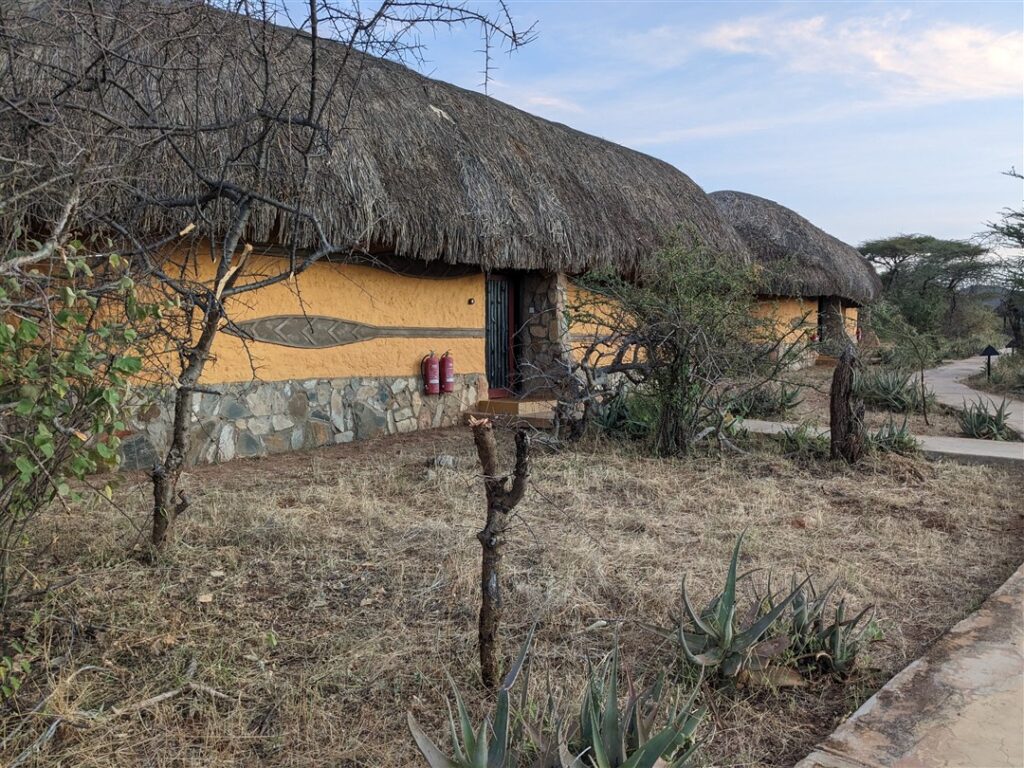
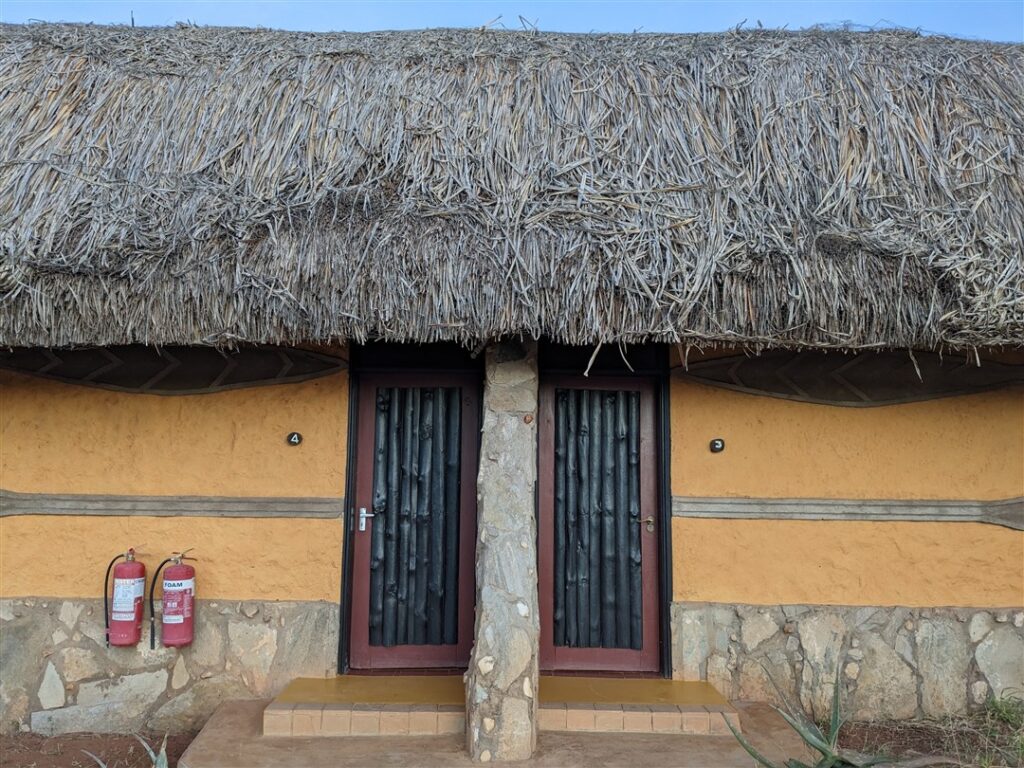

Tispi led four of us into his hisbhutbthat he said slept six. It was very smoky inside with a fire burning between a frame on bricks and concrete block. There was no chimney or escape route for the smoke, so staying in the hot hut for more than a few minutes seemed to be nearly fatal. We left quickly. The only obvious sleeping area was a low platform of smooth animal skis that he said was his bed. I presumed everyone else just slept on the dirt floor.
Next, one of the community members showed us how they built a fire using sticks rubbed together along with dried cattle dung and bits of paper. The woman demonstrating was able to create flame in no more than two minutes.
From here we went to the school–really a preschool. Tispi said that in times past, no one went to school because that seemed like lost value when they could be herding animals. These days, though, and starting with his generation in part, kids older than six went to public school to become literate and learn English. It seemed that in most cases that education would end after elementary school.
We were introduced to the teacher and the kids who then went through a performative routine of saying the alphabet and counting not unlike what we’d seen five years ago in Monrovia, Liberia.
Margaret then stepped up and asked if she could teach the kids a game. The kids stood, too, and joined her in a counting game using their hands and feet, demonstrating some balance and coordination.
Next, Tispi asked us for contributions to the school, straight away insisting that we donate and playing the guilt card. There was zero indication, though, that any money would actually go to the preschool as they didn’t seem to have anything but she under a tree and had had, presumably, others come on similar visits. When questioned, he clearly said that all money would go to the village, not directly to the kids.
At this, Becky had had enough and asked to return to the vans. The women in the village had set up a gauntlet of bead and souvenir sales on the ground in a path to the vans and we were barraged by offers. We asked to pay for beads placed around our necks at the beginning, but most of us just handed them back. I think only one or two items were bought as we all quickly made our way to the vans.
Nderitu could tell the Becky and others were agitated or turned-off by the experience and he asked to speak to Becky and me. He apologized and explained that this was the first time that he had been here and didn’t realize the high pressure tactics that would be used to soak us for more money. He told us that he would provide that feedback to the community leaders and that we would leave right away. He, too, was clearly disappointed by the experience.
We leave at about noon expecting to have a “comfort stop” when we bought gasoline at the same station we’d patronized on our route to Samburu–about 30 minutes down the road.
When we arrived, however, we found that there was no diesel fuel for Patrick’s van. We filled Isaac’s with gasoline, used the rest rooms, and continued on to another station.
We did find diesel in the next town and then moved on to Nanyuki, up the slopes of Mt Kenya to over 6000 feet of altitude and the Cedar Gallery–the same shopping center where we’d used the ATMs outbound.
We arrived there at 1:25pm and gave everyone 35 minutes for lunch. I bought some juice while Becky and others went inside the supermarket to buy snacks, school supplies for Iriuko, and some footballs. Treg bought two footballs and we bought one. Becky bought Play-Doh at the teachers’ request and Margaret bought some crayons.
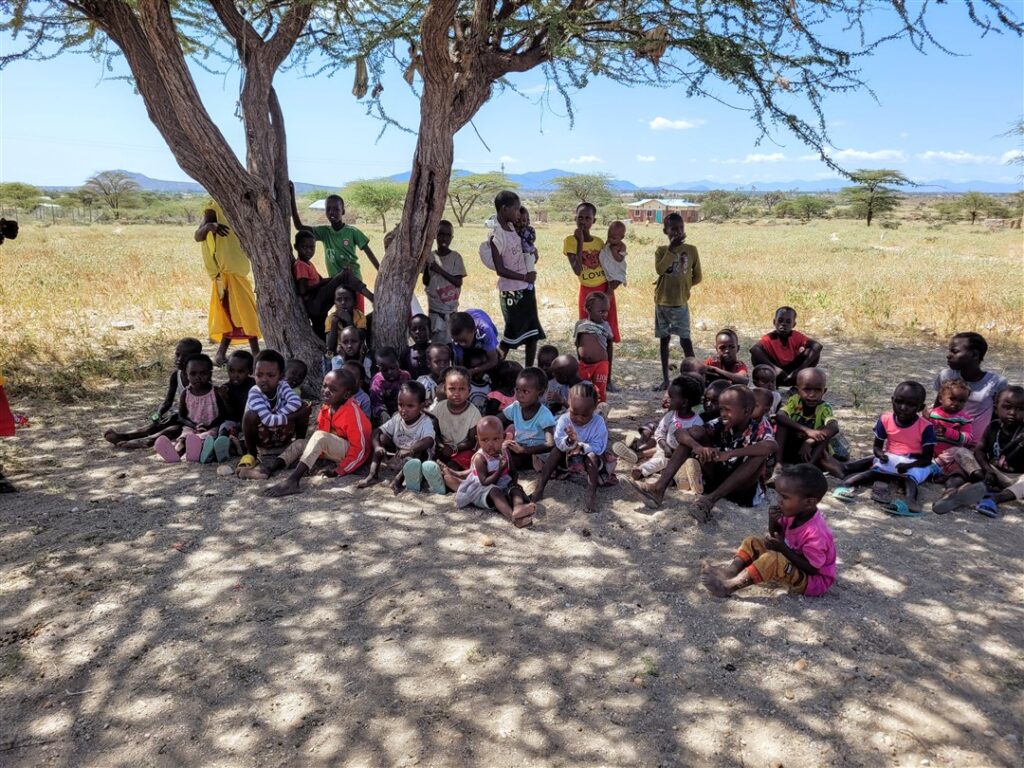

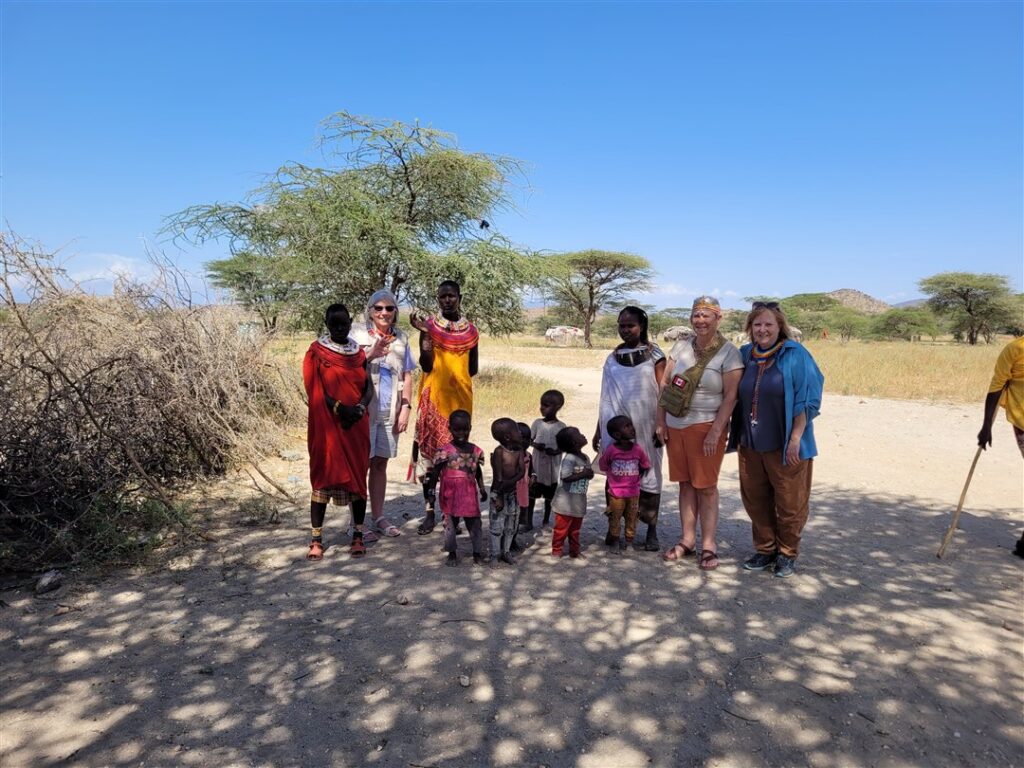
The drivers, Nderitu, and some of the group got lunch at KFC and we left at 2:15. We stopped at another ATM that honored MasterCard debit cards and then at the sign in Nanyuki indicating the Equator’s location where we took photos and selfies.
The rest of the drive was uneventful and quick. We were back to the hotel by 3:30. We collected our stores bags from reception and got our keys. All of us went to the same rooms we had before and most of us found our laundry fairly quickly and moved back into our rooms to unpack. We took showers and most of us met for drinks by the bar.
At the bar we discussed the day and heard Charles tell us about his climb to the summit of one of the sub-peaks of Mt Kenya over three days. He had a great experience with his guide and porter, staying in huts for two nights along the way and starting Sunday morning at 3:30 am to catch sunrise from the top. His photos were excellent.
The Lusoi was hosting another party, evidently a birthday party because the Happy Birthday song was played about 20 times. The party broke up at about 6pm and then we all went to dinner at 7. John, our primary chef introduced the plates to us again with great pride. He is just such a nice guy that takes great pride in his work and loves to please us.
Mark bought two bottles of red wine for the table to share that most of us drank and enjoyed. Some stuck to water. Most were tired from the long drives over the weekend and we’re quick to go back to their rooms for the evening.
12 June 2023

We agreed to leave at 7:30 in the morning and we came very close to that departure time. I was pleased to learn that Bonnie found her credit card, too.
We drove to Naro Moru to buy drinking water and arrived at the same shop before they opened at 8am. They did open promptly though with what looked like a dozen uniformed employees. I bought six 10-liter bottles of drinking water. Many in the group bought more gifts for the school rooms. We talked about when to present them, thinking that at least some should be given on Wednesday before Treg leaves us and then more on Friday before our departure.
We arrived at the work site just before 9am and we’re all impressed by the layers of stone set to form the gables on the two building sides. One side had four layers and the other had two.
Joel told us that we needed to wet the walls again for curing, build more scaffolding, treat more wood, and help with the sone setting and mortar filling.
Noah and Charles went to paint, as did Val and Vicky. Margaret worked at filling jugs with water, while Becky, Treg, Bonnie, ND Mark splashed the walls. The scaffolding on the left side (as you face the building) went up quickly. Joel asked me to climb up to help, but I balked saying that the scaffolding was not stable enough. Nderitu jumped in with a hammer and nails and started fixing cross-beams and diagonals to the suspect structure. After adding about a half dozen braces, we just it safe and I climbed up to help Simon and Peter set blocks.
One worker was sTationed halfway up the ladder handing me buckets of mortar and stone blocks. As each layer was completed I filled the gap with mortar. Mark and many of the others were helping with thea new front and back scaffolding including digging post hole for the verticals.
We finished the left-side gable and then took a tea break. Our break was short, though, as more mortar was already mixed and we needed to set the final three layers on the right gable.
Meanwhile, Becky was chatting with Patrick the Headmaster about how best to distribute the gifts to the classrooms. The plan they settled on was to split the purchases items among the first and second grade classrooms and then solicit donations from the team that would be split evenly among the classrooms assuring equity and teacher preferences be best met. We would give all three of the soccer balls to the entire school.
We finished the right gable quickly and then took lunch. Today we had chicken curry with rice and spinach along with watermelon and passion fruit for dessert. Again, it was very good and hit the spot.
I spoke with Nderitu about the plan for the rest of the week and he told me that we had several things left that we could do, even if we finished the classroom or others were free from working there. He intended to our hase paint for the bathrooms. He also said that another outhouse put had been dug and that construction would start on that with the relatively simple work of digging and setting a foundation for the structure. We also discussed the possibility of visiting some other DWC-sponsored work sites including training centers. We thought that some afternoons one van could take half of us to one of those or other sites leaving early and going straight back to the hotel after.
Soon after that and before the work restarted, Isaac told me that Nderitu had a family emergency, but would be back before our departure at 4pm
After lunch the team focused on wood treatment, filling and smoothing some of the mortar gaps, completing the scaffolding and again wetting concrete for curing, as well as cleaning up the inside of the classroom.
We made quick work of setting a final single layer of stone above the reinforced ring on the front and back walls, too, and Noah helped my fill gaps with mortar. Mark worked opposite us while the othera continued with cleanup and patching.




We were told that once this top layer was done our day would be complete. The other workers starting cleaning up except for the team that was beginning to assemble the roof trusses. We were told that the front and back scaffolding was primarily for setting the roof trusses in place. I was looking forward to seeing that process.
Nderitu returned by 3:30 and told me that he had to drive to Nairobi to tonight because his 87-year-old mother had taken a turn for the worse and was now hospitalized in Nairobi. He would be joining family member there and then driving back tomorrow afternoon, hopefully to see us by 5pm. I was concerned that his mother might be near death as I tried to read into his words and expressions.
The tem stored our equipment in the Headmaster’s office and we said goodbye to the kids just excused from their school day. We took the usual dozens of selfies and a few videos. Some girls were using inflated bicycle inner tubes as hula hoops and I took a video of that. I also didn video interview with Noah.
We left before 3:45 and made it back to the hotel by 4:45. Just outside of the school, we picked up a young that looked like he was about six and gave him a lift closer to home. Isaac. Knew where he lived and I’m sure we saved him at least a kilometer of walking.
I was very tired from the near constant work and stress of being up so high on the improvised scaffolding, working with the blocks and mortar.
The air was cool on the drive back, but the skies were also cloudier than usual. We hadn’t experienced any rain except for a few drops at Samburu, but I thought some afternoon or evening precipitation would be nice, if for nothing else to keep the dust down.
13 June 2023

In the morning, we talked through the gift ideas again at breakfast. The celebration idea seemed to resonate, though we did discuss some other ways to help on Becky’s urging, I reiterated a little speech about how we had already given a great deal of our time and money to the project and school and that we should be proud and happy at that as enough. Sure, we can always give more, but that we also can’t in two weeks and with some donations fix all of the issues challenging the Iriuko School. We could still make a lasting commitment to the school through DWC’s other programs as described above, and leave knowing we’ve succeeded in helping.
We broke up from breakfast with that plan and prepped to leave. At 7:25 at the vans< I discussed our celebration ideas with Patrick and Isaac. They both liked it, but thought that finding enough fruit in the area would not only b difficult, but also not that much of a treat for Kenyan kids. As Patrick said, “telling a Kenyan kid to eat a banana is like telling and American kid to enjoy their vegetables as a special treat.”
Isaac suggested that we consider contracting with the local bakery in Naro Moru to buy about 400 muffins or cupcakes–one for each kid and staff member. He thought that they’d truly see that as a treat. He also offered to contact the bakery and see if they could prep that many muffins by Friday as well as the cost. We all like that idea and believed that the kids would see each muffin as something more personal for a departure and thank you celebration.
The last thing we discussed before departure was the possibility of buying one or more additional pairs of rubber work boots for some of the workers whose shoes were falling off their feet. Isaac told us that the supermarket where we’d bought water had them and agreed to help us determine the right sizes for those that needed boots.
With that, we were off. The weather was cooler and foggy and multiple weather websites indicated up to a 70% chance of afternoon thunderstorms, something I think we would all welcome given the past 10 very dry days that already seemed to be having a noticeable impact on the plants and crops in the area.
It was cloudy most of the morning with a light breeze and higher humidity. We didn’t see any rain, though. The group started by wetting the walls again and then clearing construction debris. Others worked on assembling the roof trusses
We had a radial mitre saw but we didn’t have sufficient wiring to run it from the local circuit so the work proceeded without the saw. The third truss was completed quickly and Mark sent Simon to the hardware store on his motorbike to buy three new hand saws that cost about $20 US each. They arrived just after lunch.
Away from the school room, other workers had dug a foundational pit for another latrine. It was an almost perfect three meters by three meters square, two.meters deep. We saw them start digging the previous Thursday. They had piled all of the dirt immediately around the edges of the pit, so close that some of it broke loose and tumbled in. Joel asked us to move ALL of that direct about 20 meters away so that the rest of the work could be done.
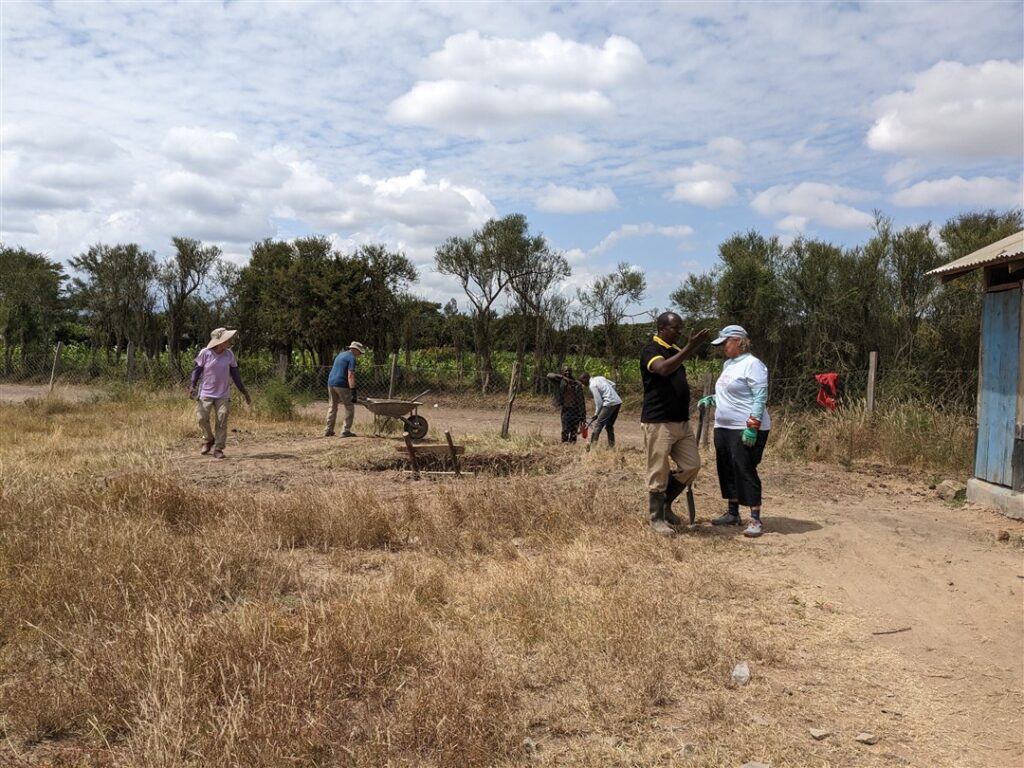


Charles, Noah, and I started on that with the help of Bonnie, Patrick the driver, and another local named Patrick. Charles and I did a quick calculation that the pit was 18 square meters. Eighteen square meters of water weighs 18 metric tonnes (21.6 tons). That’s a lot of dirt to move.
We worked on it until tea break and finished about two-thirds of it. Treg came over after teams joined us so that we could complete all of the work by lunchtime at 12:30 which we did. It was back breaking work.
Work was moving well with the trusses, but more long boards needed to be spliced together to form the roof and base main line pieces. Also, we were asked to assemble more rebar framing for the latrine foundation, something that Vicky, Val, and Margaret did quite well.
We broke for lunch and enjoyed excellent chips, a ground beef and vegetable stew and some cooked cabbage that was great as a base for the stew.
At the school, bothe Val and Margaret taught lessons today. Margaret taught in both a level four and level five classes (American equivalent of third and fourth grades) while Vicky taught in level two class (the American equivalent of first grade). Margaret, who is a professional English-as-a-Second-Language (ESL) teacher taught high level English concepts while Vicky taught sight words. Val recorded Vicky’s session. Both really enjoyed the experience and it was clear the kids and teachers appreciated it, too.
After the saws arrived, work picked up on the trusses. Almost everyone was involved in some form or fashion, sawing, hammering, treating wood cuts for termites, splicing boards, holding boards, steadying and bending boards to match the first truss that was used as a form for all that followed. As each was completed, it was stacked close to the building and any untreated pieces or gaps painted green.
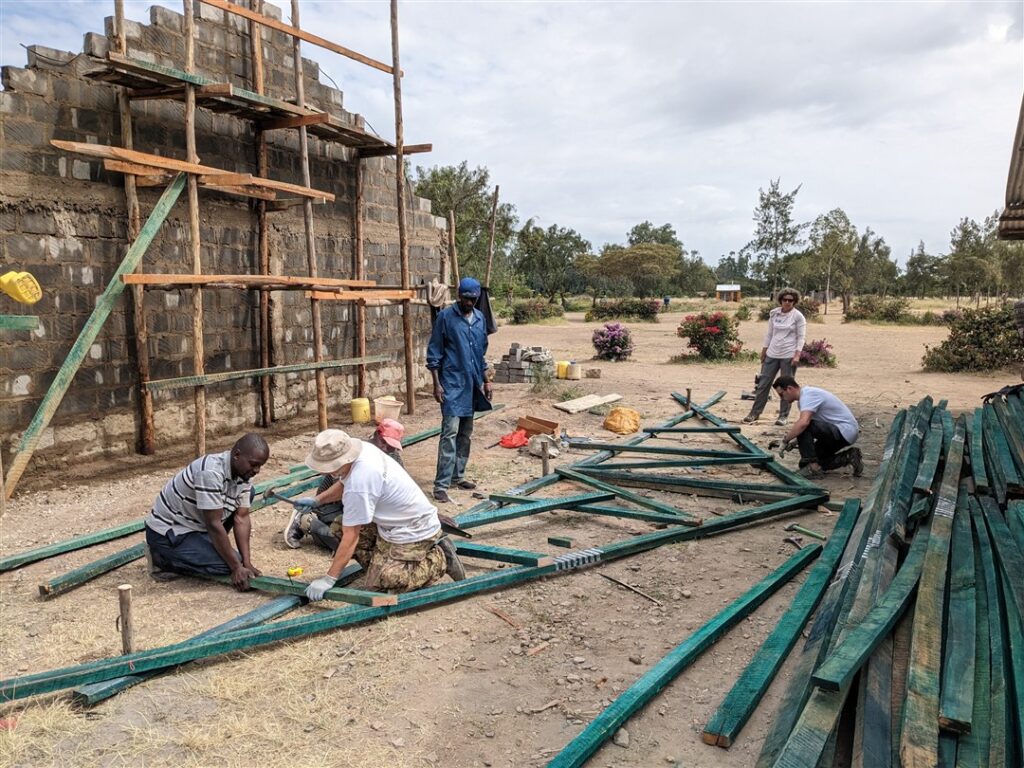
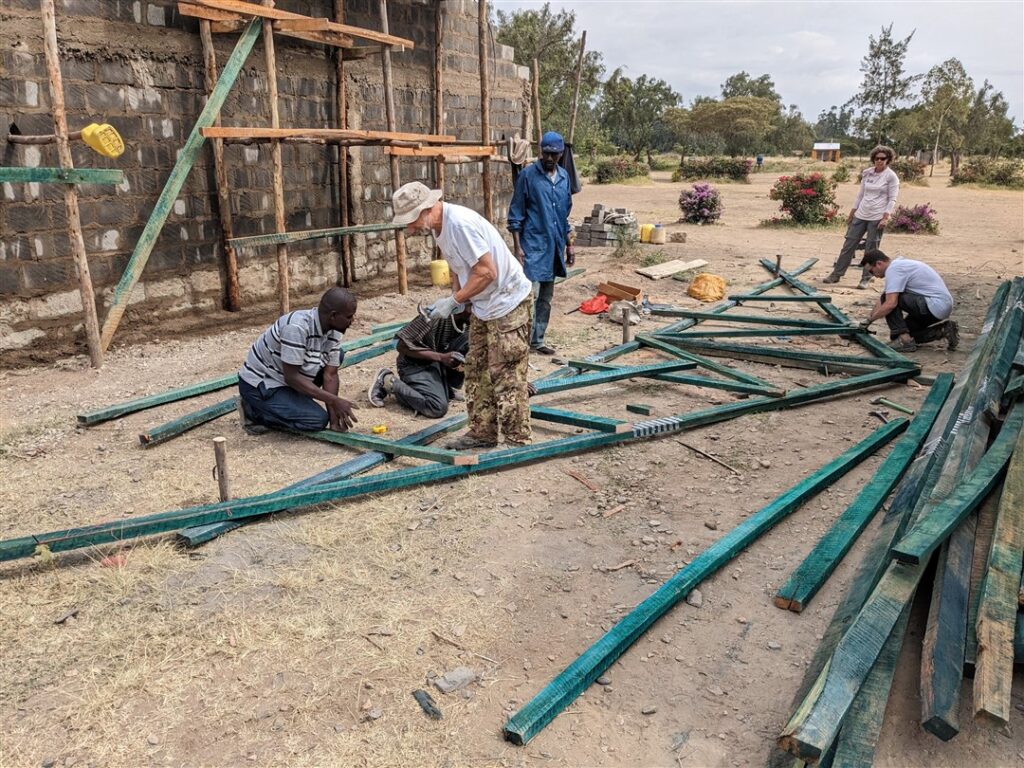
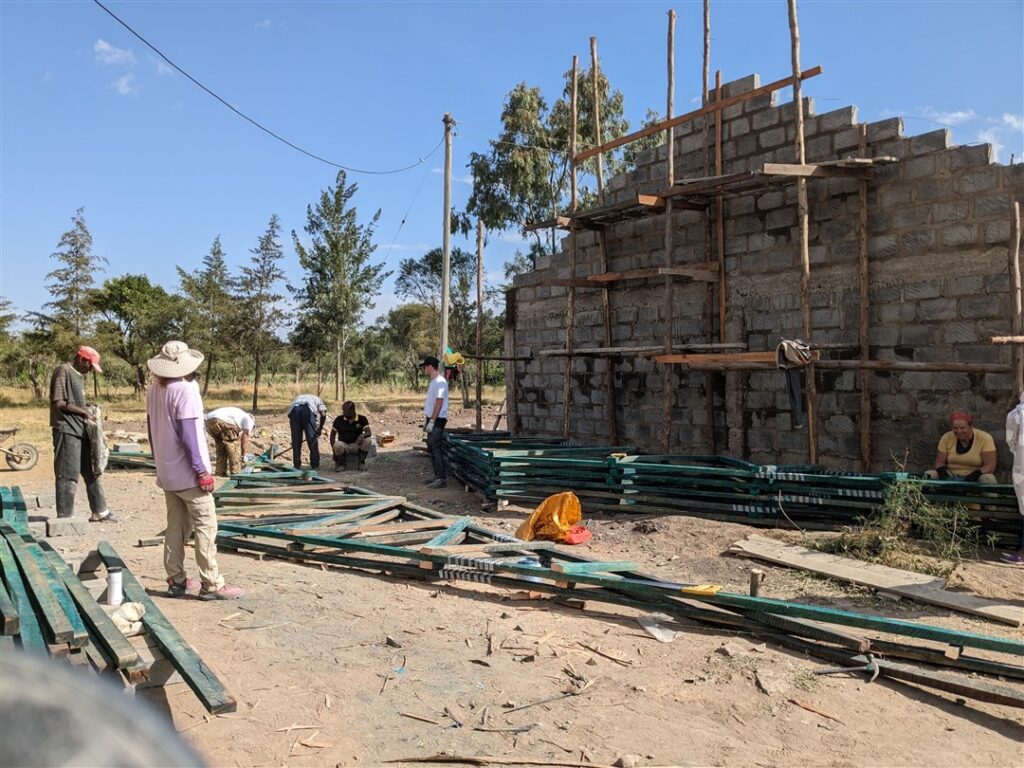
Treg was hauling concrete from a pile mixed on the far side of the school room from the latrine, next to the piles of sand and gravel. She had to travel about 75 meters to dump the heavy loads and did dozens of trips after helping to move dirt most of the morning.
Mark was essentially in charge of the truss construction, having worked side-by-side with the locals on the first three. He was the hammerer-in-charge and very good at aligning the boards and setting them in place or helping us Mark them for cutting. Almost everyone handled a saw and we needed that because it was very hard work.
The fifth through seventh trusses went together very quickly with the new saws. We finished the work just after 3:30 and began to clean up. I did an interview with Margaret for DWC and the others rescued Treg from wheelbarrow duty
On the latrine, it seemed that they had set four pieces of rebar deep into the ground at the bottom of the pit forming a square about 1.5×1.5 meters. They had then set a large block outside of the rebar square and formed a hollow external square around an open area. Patrick told me that that inner square would form a shaft that would be dug down 20 to 30 feet into the ground. To me, this seemed more like a water well than a latrine. He also told me that the outer square would form the foundation for the above-ground latrine structure. I was anxious to go see the work the next day.
We left before 4pm and gave rides to our cook and another worker back to Naro Moru. Everyone was quiet on the return, dozing off in our van if they weren’t writing a blog. When we arrived at the hotel, we all talked again about plans for the next few days. Isaac said that that evening he would check with the bakery in Naro Moru about baking bread or muffins (or both) for our Friday celebration. We decided to give all of the purchased gifts to the school on Wednesday afternoon, too. At that time, I had not received a message from Nderitu about his return.
After that, it was about 5pm so we did the normal routine of shower, sink laundry, clean up some things in the room, put the hotel-provided water bottles into the fridge, relax for a few minutes and then go to the bar for a Tusker.
Despite the forecast for rain today, we saw none. However, that didn’t mean that the weather hadn’t changed. Outside by the bar, it was cloudy and breezy with temperatures dropping into the upper 50s Fahrenheit. I went back to my room and put on a long-sleeved shirt with an undershirt before returning for my beer. Mark was there with us and Charles and Treg joined later. By 6:45pm we had all had enough of the cold and walked to the dining area to warm up.
Emmanuel, our chef, had the right food for the cold weather with another one of his soups–this time a great cream of potato and leek with a good deal of ginger and black pepper. It was fairly spicy. Bonnie asked for a second bowl.
Again, Mark treated us to two bottles of red wine from South Africa and the bar. Treg explained what was going on with the latrine and it seemed to be generally as I’d described it above. The overall conversation tonight revolved around travel and its enriching qualities. We talked about the number of people (especially in America) that were unwilling to step outside of their comfort zones and see what real life was like outside of their own bubble, be that a community, a cruise ship, resort or luxury tour. The experiences we had on this trip were just so far beyond what, it seems about 99% of our fellow citizens ever see. We all agreed that the empathy this sort of work and interaction builds in everyone is vital to helping build a more peaceful, free, and thriving planet.
14 June 2023
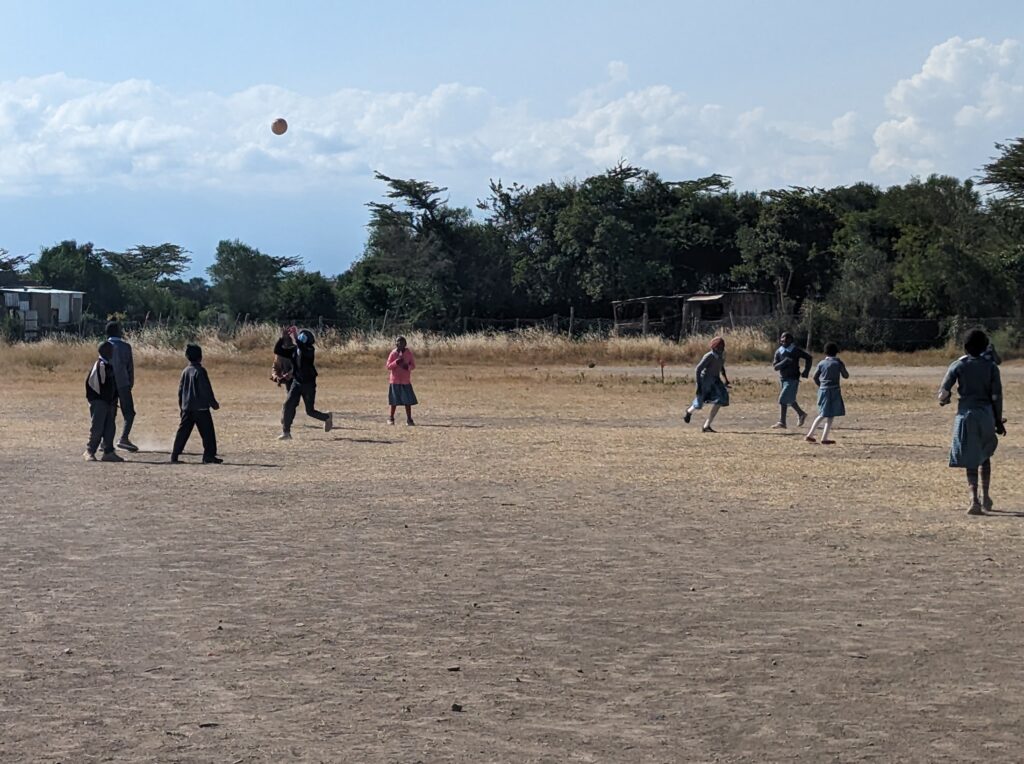
Breakfast talk this morning was fascinating as usual. Vicky started the discussion talking about our definitions of poverty and wondering if we (in the West) weren’t somehow patronizing and condescending to impose our more materialistic view of happiness and fulfillment into other cultures that we might view as impoverished.
Charles discussed his observations from the Okavango Delta in Botswana and how content the people seemed to be as fishermen and farmers. The discussion continued in great depth as each of us added our opinions on the subject.
When Isaac and Patrick arrived, the gave us quotes for a celebration for the kids and school on Friday to include small muffin cakes and sodas for everyone. All of that would cost us about $150 US. We all agreed to support that.
Patrick also found the rubber boot sizes for all of the workers. Good rubber boots would cost 1300Ksh each for a total of 10,400 KsH or about $75 US. Becky said that we would cover that cost on behalf of our friends, Dan and Jane Colvards who’d already pledged $100 to cover these costs.
All in all, this would cost each member about $15 US in the end or about 2500 KsH. The team was enthusiastic about the whole plan and we gave Isaac and Patrick to execute the plan.
Our van would stop in Naro Moru this morning en route to the work site to buy one or two landscape rakes and more drinking water. We would also stop to buy the boots at the end of the day since then that shop would be open.
Treg will be leaving at the day, so one van would plan to leave with some of the crew at 3pm to go back the hotel and then leave for Nairobi with Isaac driving. The second van would bring back any others that were working beyond 3pm as needed.
The sky cleared as we drove to Naro Moru, though the skies remained hazy with moisture. We arrived at the hardware store a few minutes after 8am and I bought three small landscape rakes and a broom for a total of almost exactly $10 US (1390 KsH).
The other van bought water at the supermarket (four 10 liter bottles) that should last us for the rest of the work days and back to Nairobi.
Work started almost immediately. Joel, through Patrick, told us that today we had three things to do: Wet the walls again to help them cure, move the rafters inside and mount them atop the walls, and work on the latrine.
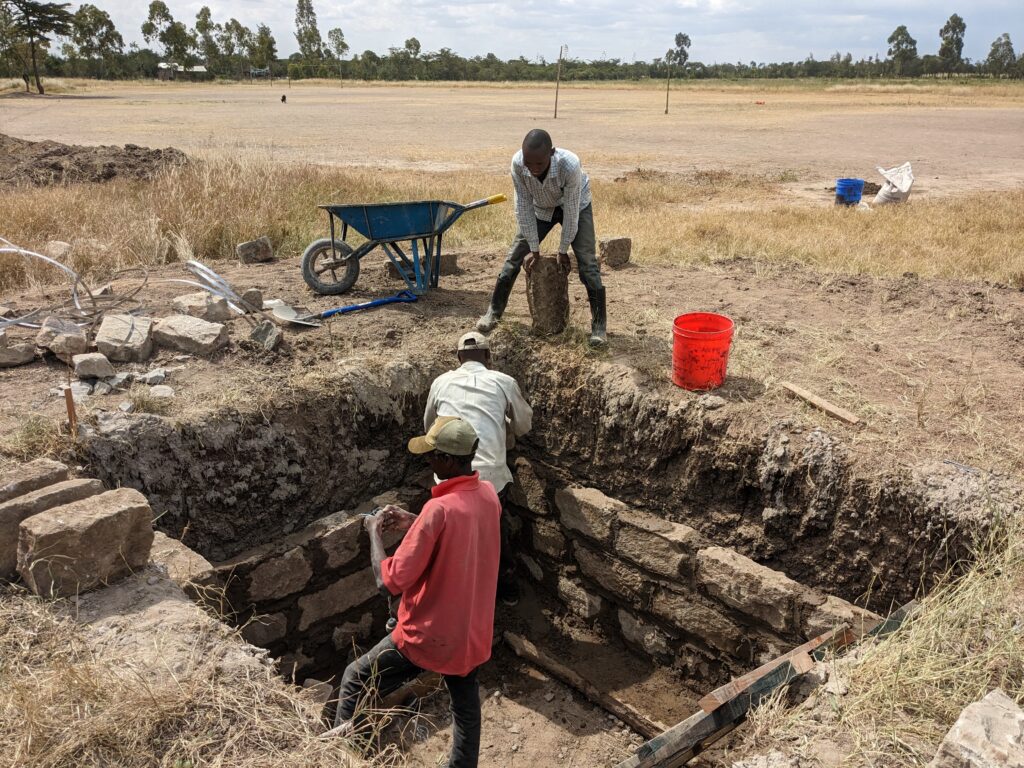
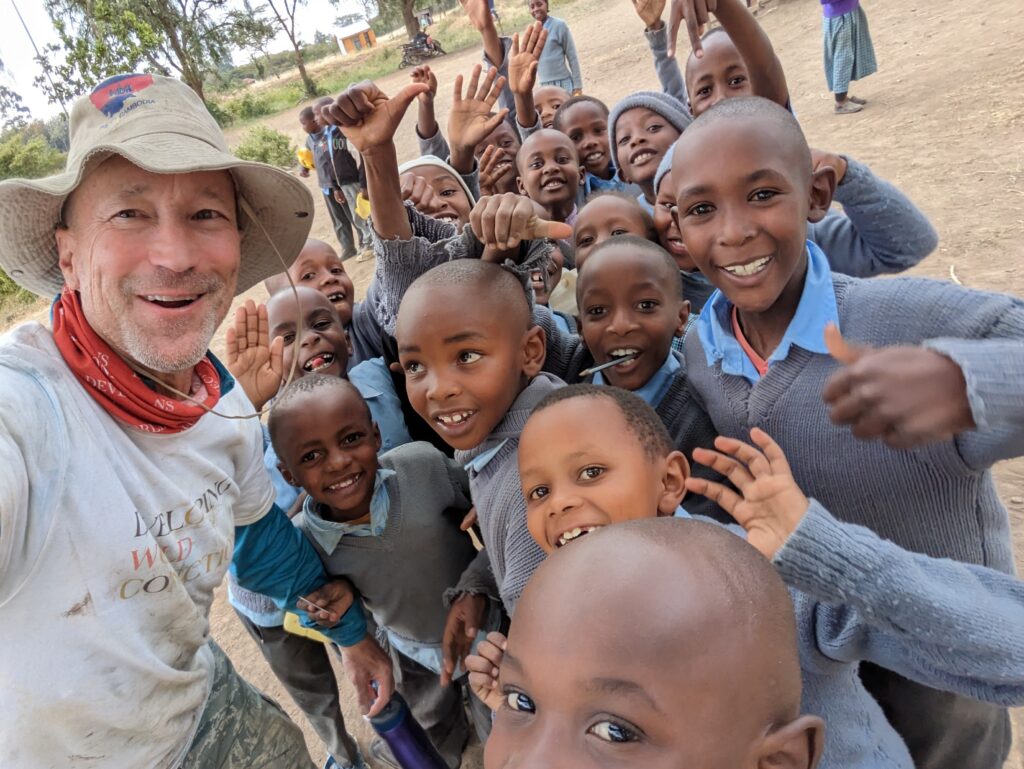

We started by lifting the first rafter and carrying it into the open school yard in front of the school. Then, we started nailing extra boards to reinforce all of the spliced joints with metal wrapping that we’d constructed in the past–making Mark and I wonder why we didn’t just splice the boards together this way in the first place. Moving each rafter required the help of at least six people. Plus, we needed to flip the rafter over to nail on the reinforcing boards.
We carried the rafters in upside-down through the doorway until the far end extended above the low back wall and the near side of the rafter would clear the door. Then, we lifted it until it was balanced on both walls and aligned the rafter to be parallel with the gabled end. The rafter was then moved all of the way to the right side of the room, very close to the gable. Next, ropes were laced around the top of the rafter and thrown up to two workers who were on the highest scaffolding at the top of the gable.
After all was in place, we rotated the gable upward by pulling on the ropes and pushing and lifting from below. With the first rafter, it was then securely nailed to the exterior scaffolding using a board as a stringer or “purlin” that was temporary. Accomplishing this took at least 10 people and, apparently, a lot of shouting and arguing in Swahili. We were just lifting force, though we tried to coordinate the timing on that lifting.
We moved, reinforced, and hoisted up three more rafters before tea break, placing them all within about three feet of the original and again, temporarily securing them in place using purlin boards.
Meanwhile, others were helping move rocks to the latrine and several of the women either taught another class or were involved with distributing the gifts of class equipment and decorations to the teachers. There was also a lot of sawing as we cut more reinforcing boards. We held off on the curing.
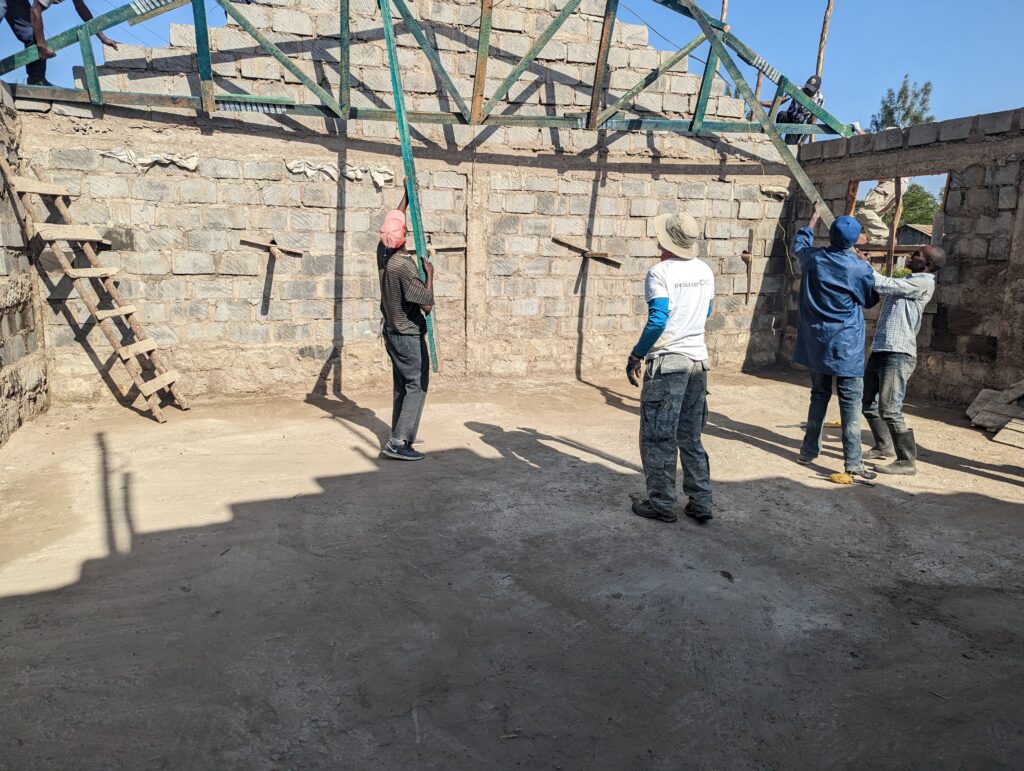
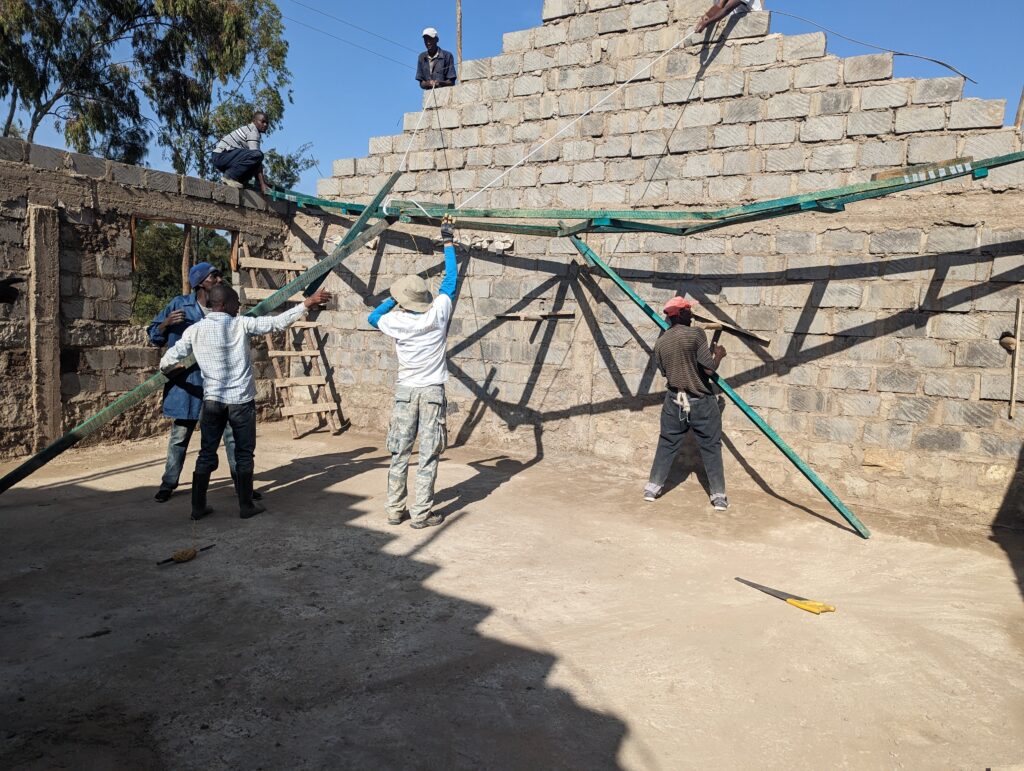
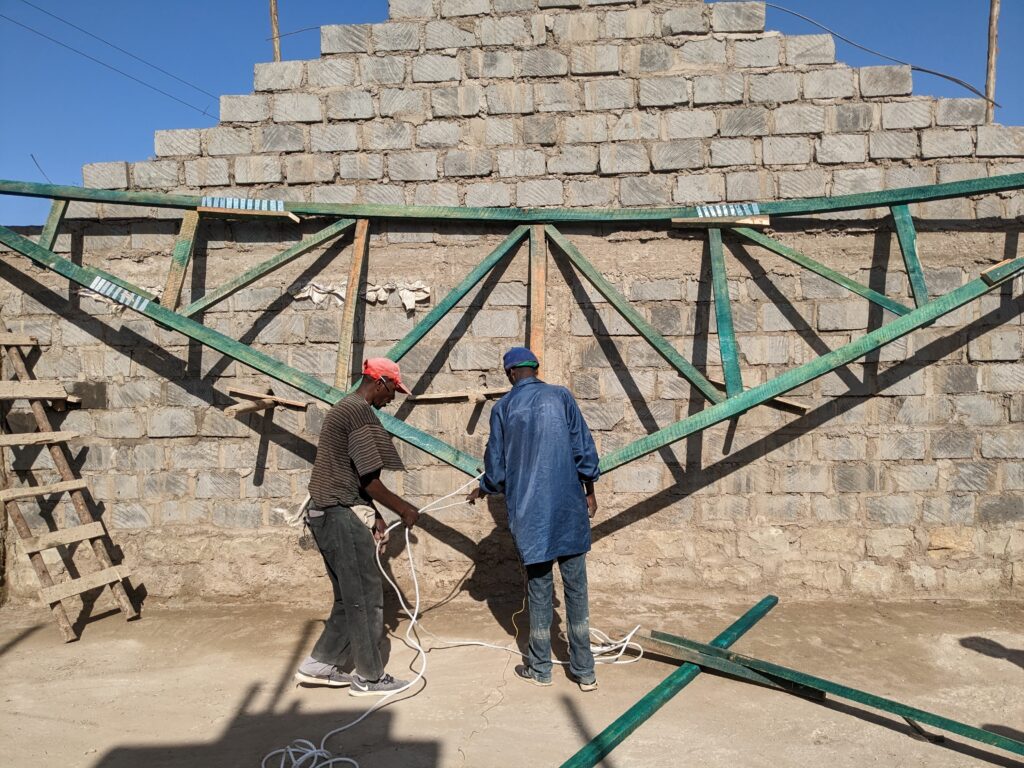
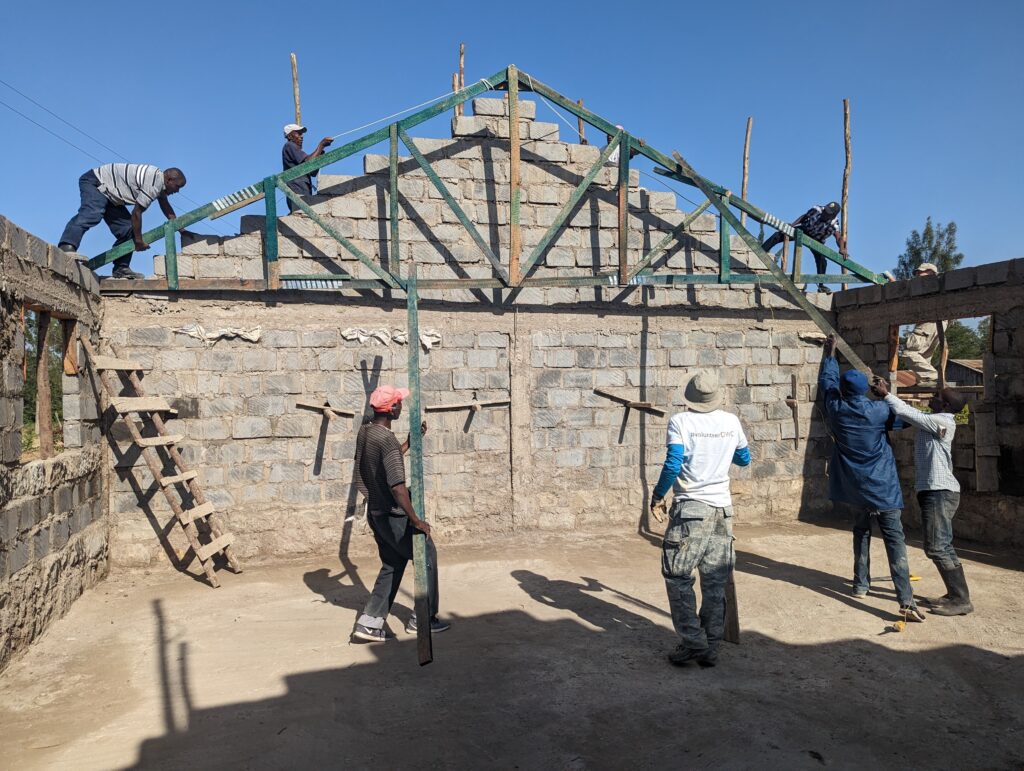
After tea break, we brought in a frame that went to the left side against the left gable. It was secured permanently to the blocks in the gable. We brought two more in on that side but now put them in permanent position evenly spaced. The exact placement of each was difficult given the weight, but also because of the directions. To center the rafter, instead of telling us to shift it north or south by a few inches, the local workers were calling for it to move either towards the town of Nanyuki (north) or to Naro Moru (south). A plumb bob was used to make sure each rafter was vertical before more permanent purlins were nailed into the top. We then moved the original four rafters into permanent position before lunch.
After lunch, a few of us worked on cutting and splicing long 2×2 boards into the permanent purlins that Peter, Simon, and William were nailing onto the tops of the rafters. Throughout the entire process we took many photos and videos.
The team worked together to wet the walls for curing (we hoped for the last time). It went quickly with everyone doing it and the high pressure and flow of a newly refilled 3500 liter water tank. We also did some of the usual site clean-up.
Just before 3pm, the silver van left for the hotel with Noah, Treg, Val, Vicky, and Bonnie. Isaac dropped the first four at the hotel and drove Treg to Nairobi where she would meet Tom (her husband) for the rest of their vacation trip. She updated me along the way and said that they ran into big thunderstorms and heavy traffic due to an accident. The trip lasted two hours longer than expected and Treg didn’t arrive until 8:30pm. Isaac was able to see his wife and then get some sleep, but his kids were asleep. He would get up at 4am and drive back the next morning to meet us.
The rest of us remained, waiting for Nderitu to return with the van that he was using in Naro Moru to buy and arrange deliver of the corrugated steel roofing sheets that we expected on Thursday. I helped mortar gaps between the stones at the latrine base while Mark chipped overhanging, excess concrete from the poured layer using a hammer and large chisel.
Wednesday evening drinks and dinner were of the same good quality. Becky and I bought wine for the table this night. We had the usual conversation about the day and the project, outlined Thursday’s plan to start the day by meeting Nderitu in Naro Moru to use and ATM and buy rubber boots for the workers. We also talked about how best to gather the money for the celebration and boot purchase (both needed to be in local cash, KsH, because neither vendor honored credit or debit cards.
15 June 2023
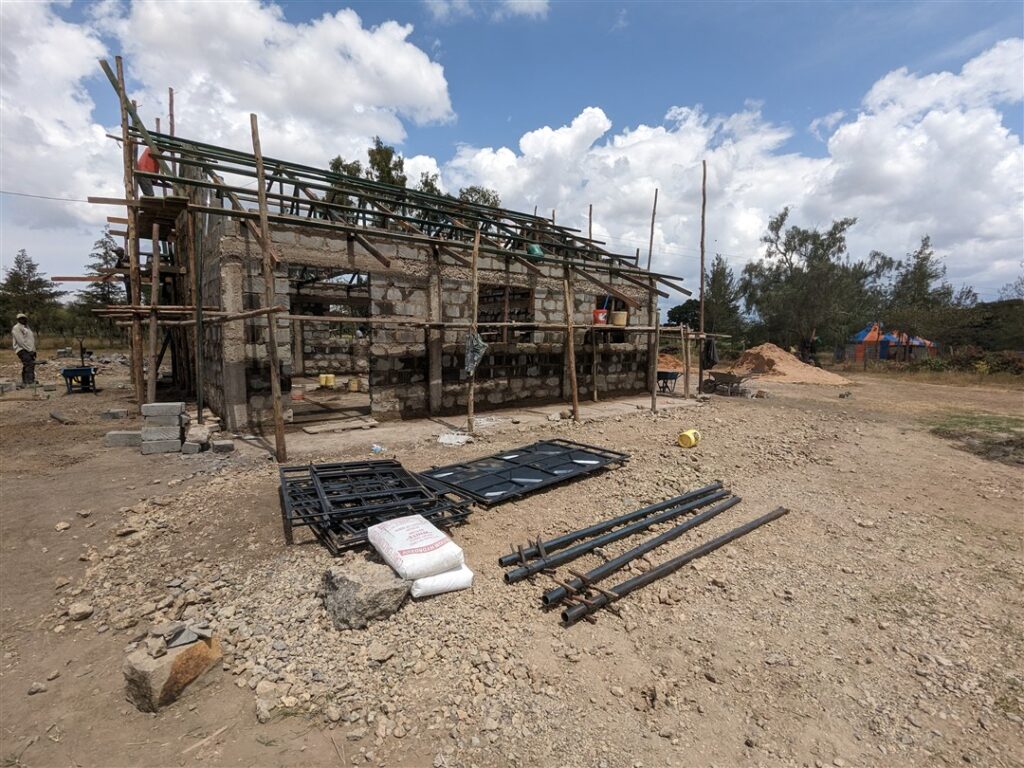
Isaac and Patrick arrived just after 7:30am and we were in the road by 7:37 in the silver van with Isaac. It was another cloudy, cool day to start and the forecast again called for a 70% chance of afternoon thunderstorms. We hoped the forecast might come true today to hold down the dust, help the local crops, and relieve us from having to wet cure the walls again.
We stopped in Naro Moru to use an ATM and found one that worked. Several of us got cash to use for tips and to pay for boots and Friday’s celebration. We then parked by our favorite supermarket and went next door where Patrick asked the saleslady to bring out the order of boots (eight pair) which I bought at the request of our friends in Colorado Springs. They cost just over $9 US per pair.
Next, we went to bakery and ordered packages of “sweet cakes” (muffins or little cupcakes) paying today for pickup tomorrow morning. Bonnie went inside the supermarket and bought another pair of shoes, some honey to take home, and a rattle toy for their newest grandbaby.
After ordering the baked goods, we walked down the street to the local Coca Cola distributor and bought 15 24-bottle cases of mixed Fanta drinks, again for pickup tomorrow morning. Our purchases now complete, we headed for the work site, arriving at 8:50.
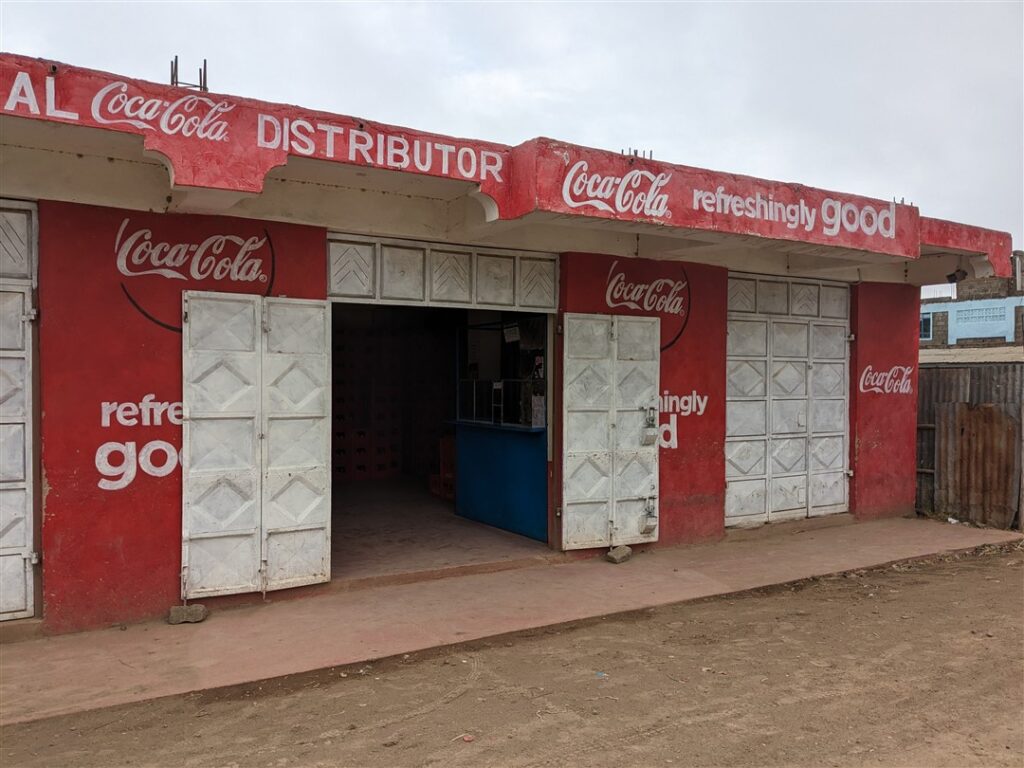
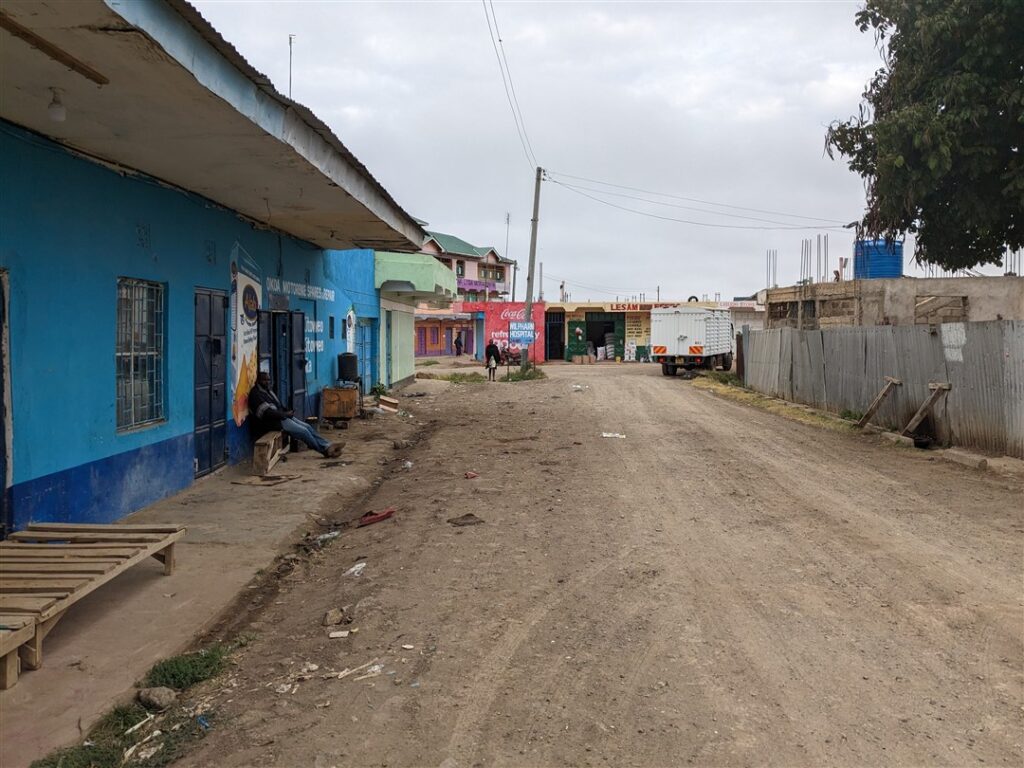
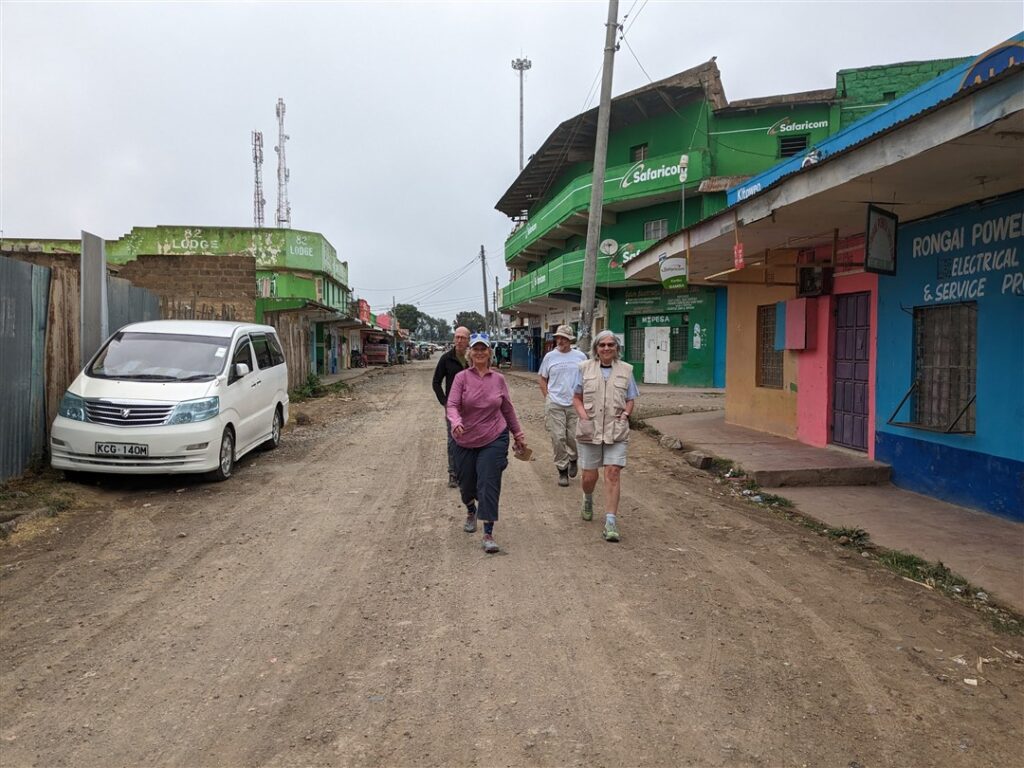
At the work site, the locals were already working on the purlins when we arrived. We were told that our three tasks for the day were to water the walls for the umpteenth time, to help complete the final row of stone blocks and to clean up around the classroom, leveling the ground, removing wood and stone scraps.
We decided to all work together to water the walls as quickly as possible. Then, Mark and I went to work filling in the gaps I’m the new row of stone above the long front and back walls, mortaring in the rafters crown beams to the walls as they now had stone blocks framing each one.
The team made short order of the first and largest pile of rubble in front of the building, using the rakes we’d bought the previous day to separate the rocks (that we’re allowed to stay in front of the classroom walkway) from the dirt and dried mud clods that were transported and dumped behind the classroom.
We took a quick early break to present the local workers with their new rubber work boots–something they all seemed to appreciate. I took a short video of them thanking Dan and Jane Colvards for sponsoring the purchase.
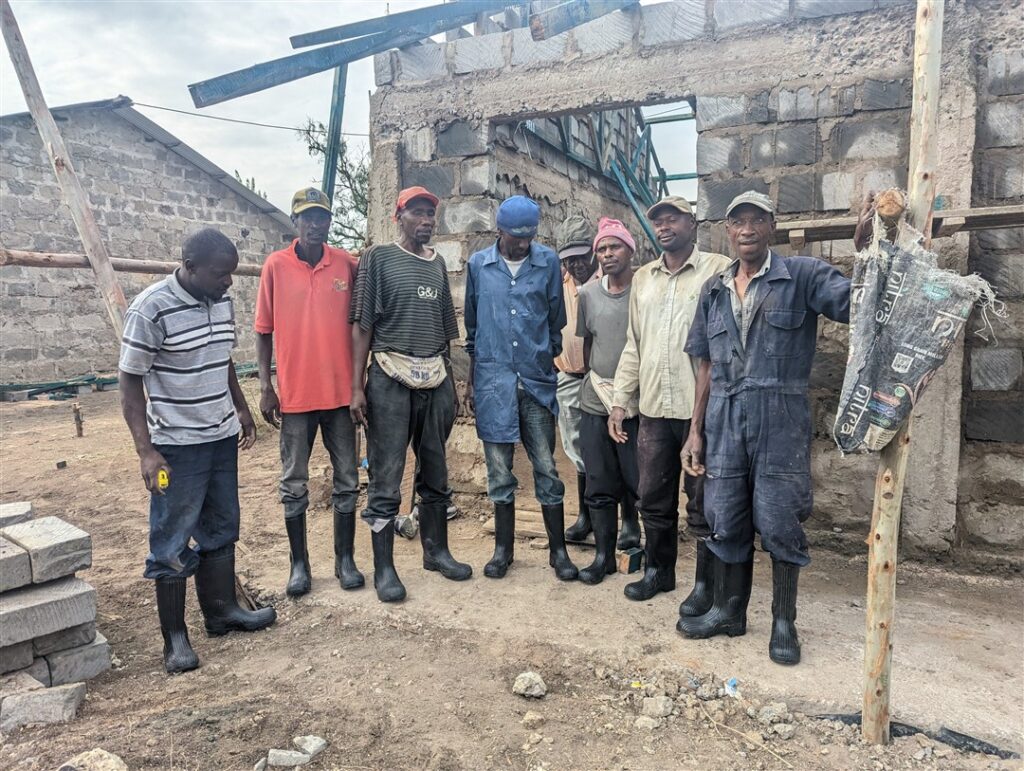
One worker didn’t receive any because he was there on the day they were ordered, but I promised that he would get a pair the next day.
Margaret took a break and talk English in two classrooms.
The team was very helpful in cleaning up dropped mortar from the floors and helping us mix more. While Mark and I filled gaps Simon and the other worked on completing the gables by filling in the stairstep of stone blocks on each gable with chiseled triangular pieces, following a precisely slopes string guide line. By tea time, two of the four slopes were done and the third was finished by the end of our day.
Peter and William spent most of their day up high in the rafters installing the permanent purlins and the pair of capping purlins that ran inches away from and parallel to the creatine of the rafters. Simon supervised the rock work, as usual.
Mark and I finished our gap work before lunch. For lunch we had a nice beef stew with a thin gravy and finely chopped veggies along with rice and an excellent mixture of sauteed spinach and cabbage. Dessert was passion fruit.
After lunch, we coordinated the Friday plan with Nderitu. We would arrive as usual to do whatever work remained, then we would break at 10am for our celebration with the students, staff, and workers, then we’d have our final lunch with John at noon before starting on our drive back to Nairobi.

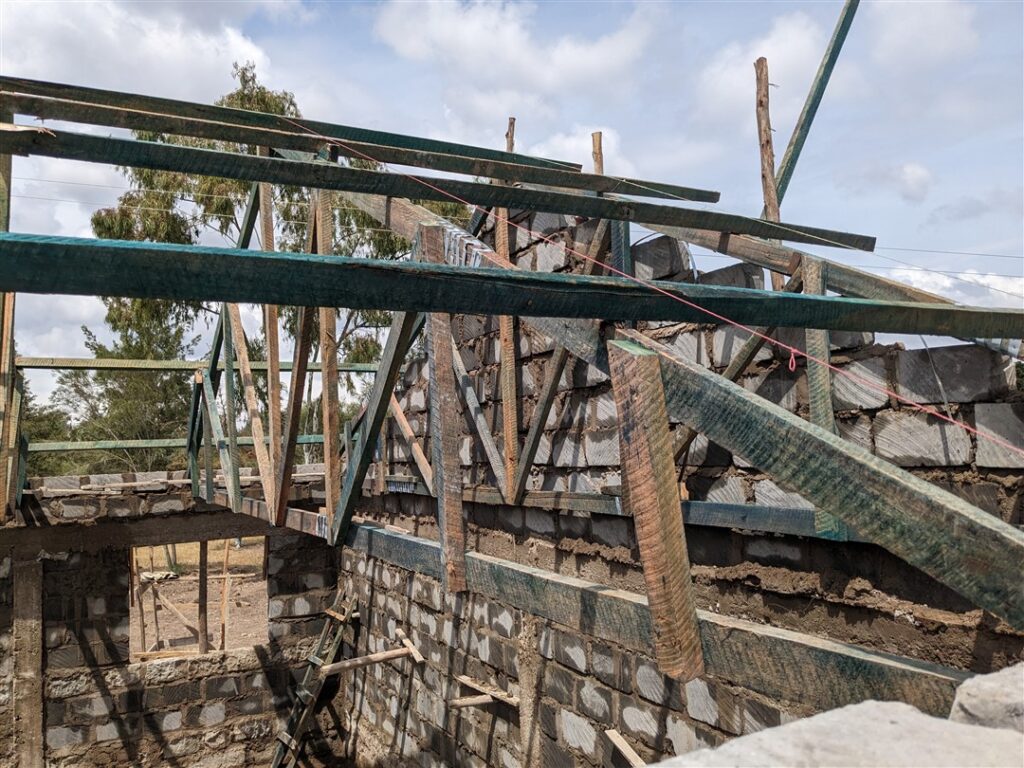
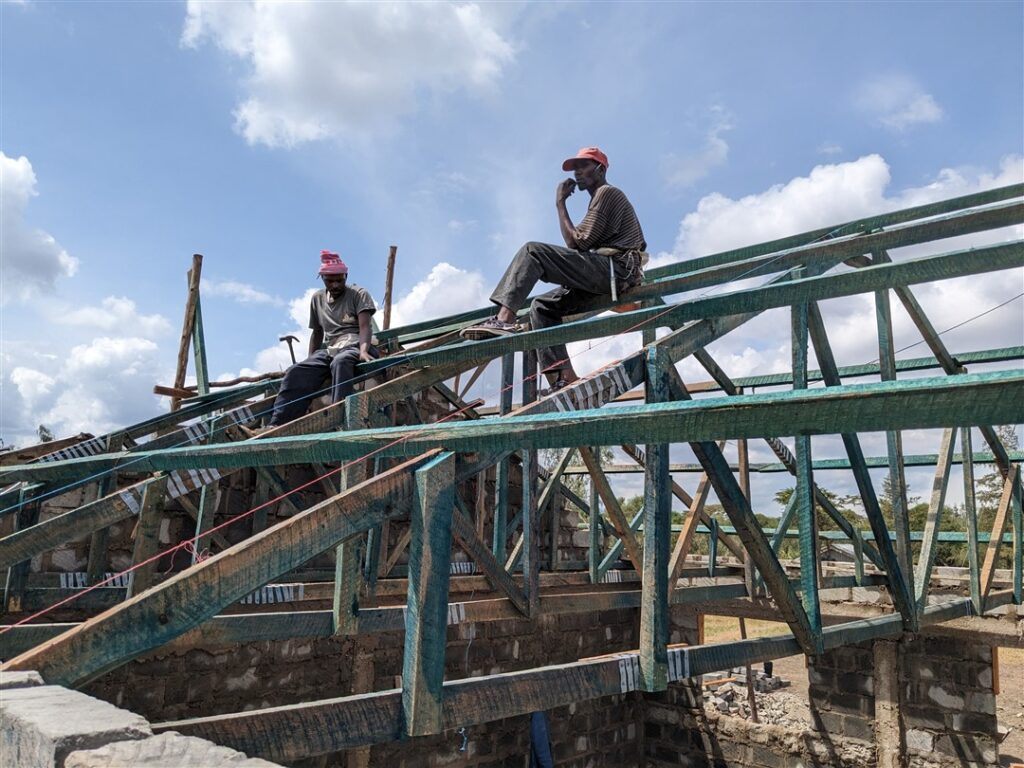
That would give us enough time to clean-up and rest for a little while at the hotel before going out for dinner at 7pm to The Carnivore for a final team meal.
In the afternoon, Joel asked Mark and me to chisel out square, marked notches in the window. openings where the frames could be set. The steel window frames (without panes) had been delivered earlier in the day as had four vertical poles for the veranda that would cover the front walkway of the classroom, and a steel front door with frame painted blue. Also delivered wer 39 sheets of blue steel roofing that were 85cm by 3 meters in size, plus more, shorter length sheets for the veranda.
I started to chisel my notch and started on the lines Joel marked for me. Unfortunately, having not done this before (especially with such poorly set blocks) I was mistakenly struck the chisel with it pointed perpendicular to the wall, not parallel to it. I realized my error in just a few mallet strikes as the stone block broke free of it’s mortar.
I stepped away and handed the chisel to Joel not wanting to cause any more damage. Mark has obviously done something like this before and took over. No other workers helped and Joel didn’t step in. Mark did several notches and then I returned and finished one using his superior technique.
It seemed the final task for the teamwa to assemble the sealing nails that would used for the roof. These were approximately three inch.long, thin nails that need to have soft, blue, plastic or rubber sealing washers pushed onto them. Several of us gathered around the bags of hundreds of nails and washers and assembles them all.



While that was going on, storm clouds threatened and we heard distant thunder. Nderitu suggested we leave before any thunderstorm and I agreed. The team finishes assembling the nails and we watched the first piece of roofing nailed into the rafters–a real highlight for us
With that, we gathered our things and jumped into the vans. We didn’t have any remaining tasks for the day. We arrived at the Lusoi just after 4:30pm looking forward to our last meal and evening there.
On the way back on Wednesday, I asked Nderitu about the farm fields we saw in the area. Most individual fields looked to be just a few acres or even less. The most common crop is corn, but we also saw beans and peas as well as a few wheat fields and some hay fields. Nderitu said that with the exception of the hay and wheat, all of the fields are.planted and harvested by hand. Farmers borrow or rent harvesters or balers (as appropriate) for rest. I asked the question because we had seen so little farm equipment besides a very few tractors. Nderitu said that many of the farmers had tractors that they used for plowing and others farm activities. The fields were mechanically plowed for each crop, but, in most cases hand seeded.
Becky and I showered and did most of our packing up on our return to the room. Our laundry (three DWC shirts) was delivered and we separated our two bags into one that we wouldn’t need to get into for the remainder of the trip–mostly dirty clothes.
We then went to the bar and met Mark for one last drink outside, but now under the veranda because of the light drizzle. The cats stayed with us, too, and meowed almost constantly. Bonnie was inside by the fire, taking advantage of the stronger wifi.
At 7pm we paid our bar tab and thanked the bartender for his kind service. At dinner, they had set up another table for us and had a special menu and dessert just for us. The dessert was a jelly roll decorated with the words “Thank You” and “Welcome Back” on it. We thanked them all for the great food and service and the manager, Moses, came to the table to greet us and also thank us for our stay.
Most of the team settled their laundry bills that night to speed checkout the next morning. We went over the plan for the next day again and I told everyone that we wouldn’t be leaving until 8am. We also discussed Nairobi plans for dinner Friday evening with reservations at The Carnivore for 7pm.
We talked about transportation plans and who would be going to the airport when. We had to explain again that DWC was arranging airport departure transportation and that Nderitu undoubtedly had us all covered. Next, be talked about tips for our drivers and the cooks and their staff. Becky passed separate envelopes for, first, our drivers, and then one each for the Lusoi staff and then for our worksite lunch cooks and helpers. She would then split the driver’s tips into two equal envelopes.
16 June 2023
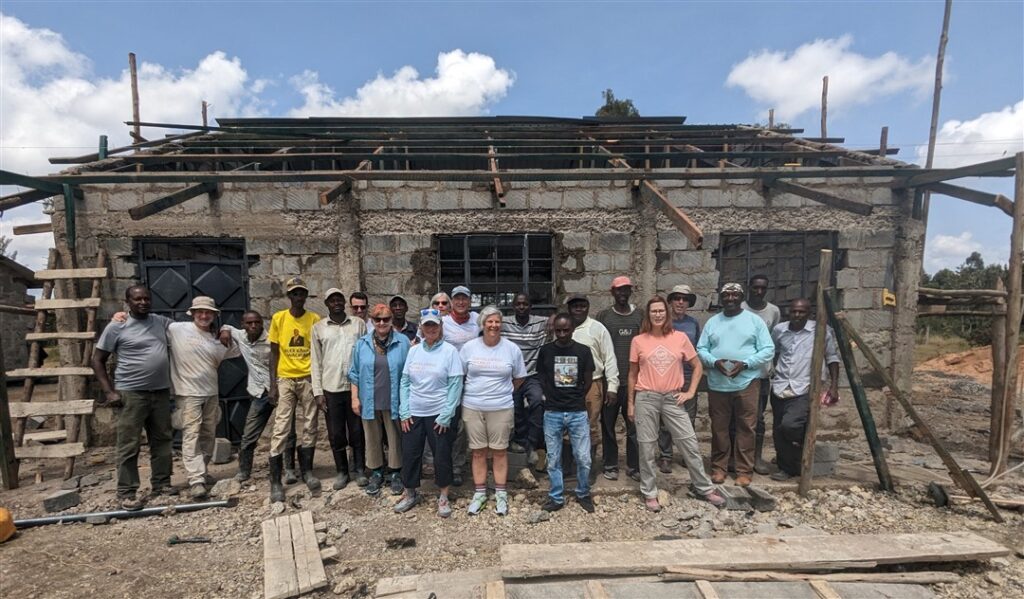
We woke at 6am and finished packing, then went to breakfast. Everyone was there at about the same time, so we took group photos and again passed the tip envelopes. Charles recounted his evening with Isaac and Patrick and how they had dinner at Isaac’s mother-in-law’s house. He said they had goat stew with greens and potatoes that had been boiled, peeled, and then fries to form a crispy outer crust. He really enjoyed the evening.
He also showed us photos from Simon at the work site who messaged that, shortly after our departure on Thursday, a huge thunderstorm had hit the school area and muddied the roads badly. Simon’s motorcycle had become stuck in the mud (he’d sent along photos) and it had taken him almost two hours to get home.
We all went back to our rooms and finished the checkout procedure, then brought our bags to the courtyard. The vans arrived at 8am and we began loading. Becky finished collecting lunch staff and driver tips, too. Isaac asked if we heard the elephants pass by the hotel last night at about midnight. He said hers would occasionally come through the area and could do damage to fences and especially corn fields. I can only imagine what a half-dozen elephants could do to a poor farmer’s few acres of corn in a short amount of time! On the drive out from the hotel we saw a massive pile of elephant dung in the middle of the road.
We drove to Naro Moru to pick up our celebration food and drinks and to buy our last pair of rubber boots. The process went smoothly and we packed it all around us in the vans. The bakery owner wanted us to leave the packing crates behind, but I convinced him that we couldn’t do that practically with 175 packages of six sweet cakes each and he agreed.
We discussed how distribution would go for the 10am event and settled on moving one or both of our lunch tables and getting a knife or some scissors to split the packages for two kids each. Patrick assured us that it would probably be a mob scene with over 300 primary school aged kids.
We left Naro Moru at 9:10 and realized that we probably wouldn’t have much time to work or prep before our event. It had clearly rained the night before and there were many mud puddles along the way. I wondered how muddy the work site would be, but was also relieved that we wouldn’t be asked to wet the stone walls and mortar again! We all hoped that we wouldn’t get too muddy before the drive back to Nairobi.
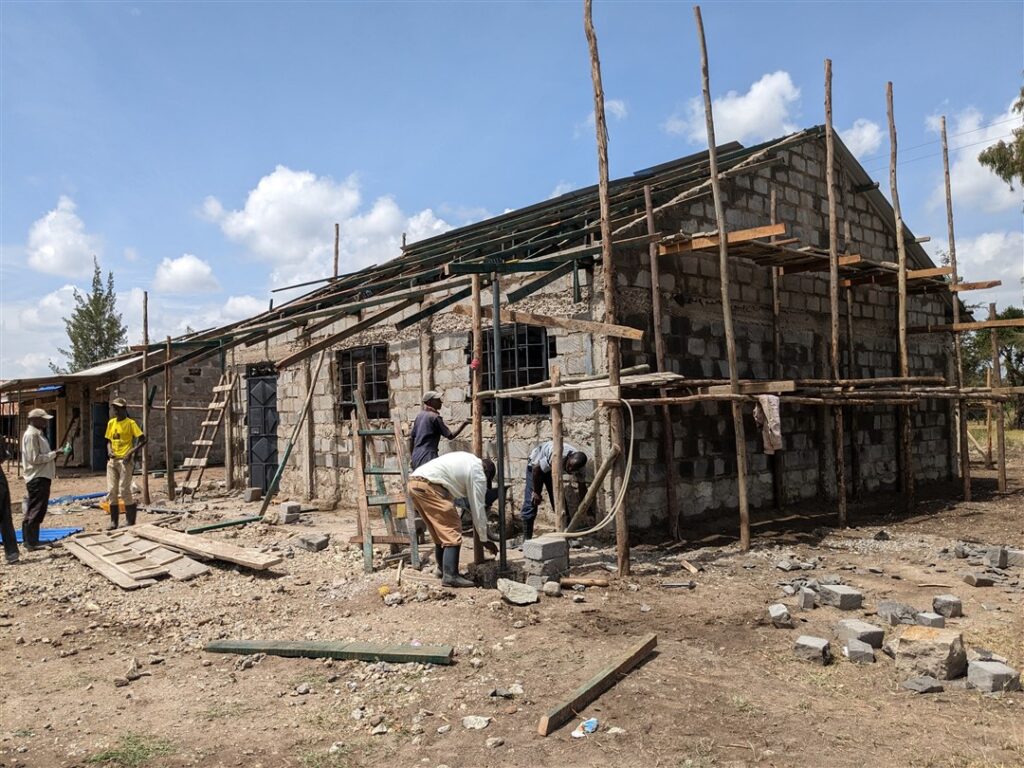


For most of the dirt road route to the worksite we didn’t really see much sign of rain the night before. Skies were still cloudy with a very low ceiling. Temperatures were cool and comfortable. As we approached the school, crossing the railroad tracks a few kilometer out, we saw much more sign of rain with muddy roads, puddles, and deep tire ruts.
When we arrived at the school we were pleased to see that our co-workers secured roofing sheets to almost all of the Naro Moru (south) side of the roof. Since we didn’t arrive until almost 9:45am we started right away to set up for the celebration with the kids using the serving table from the lunch tent. We set up all of the sodas on the Nanyuki (north) side of the table on the ground and partially opened the packages of six sweet cakes so that they could be split in half easily and handed to the kids in half-wrapped packages of three.
I walked over to the work site and immediately Joel. He told me that we needed to water the walls again and then take nails out of all of the wood in the scrap pile and also finish chipping slots in the windows and doorway for mounting the hardware.
I told him that we would not put water on the walls since they were still wet from the previous night’s rain. I also said that we were setting up for our celebration and then would be leaving at noon for lunch and then Nairobi afterwards, so our ability to do much work was very limited today.
At 10am the youngest kids from pre-school and kindergartner came out and lined up in a very orderly fashion, some with their hands atop the shoulders of the child in front of them. They were handed a soda of our choice from among the Fanta flavors and then received their sweet cakes. They were obviously very happy and beamed with smiles. We took plenty of photos and selfies with them.
Each class came out in the same well-queued style from youngest to oldest and then returned to their classrooms to eat their snack.we’d been told that they weren’t allowed to eat their classrooms and expected them to all stay out on the playgrounds until they finished, but that was not the case.
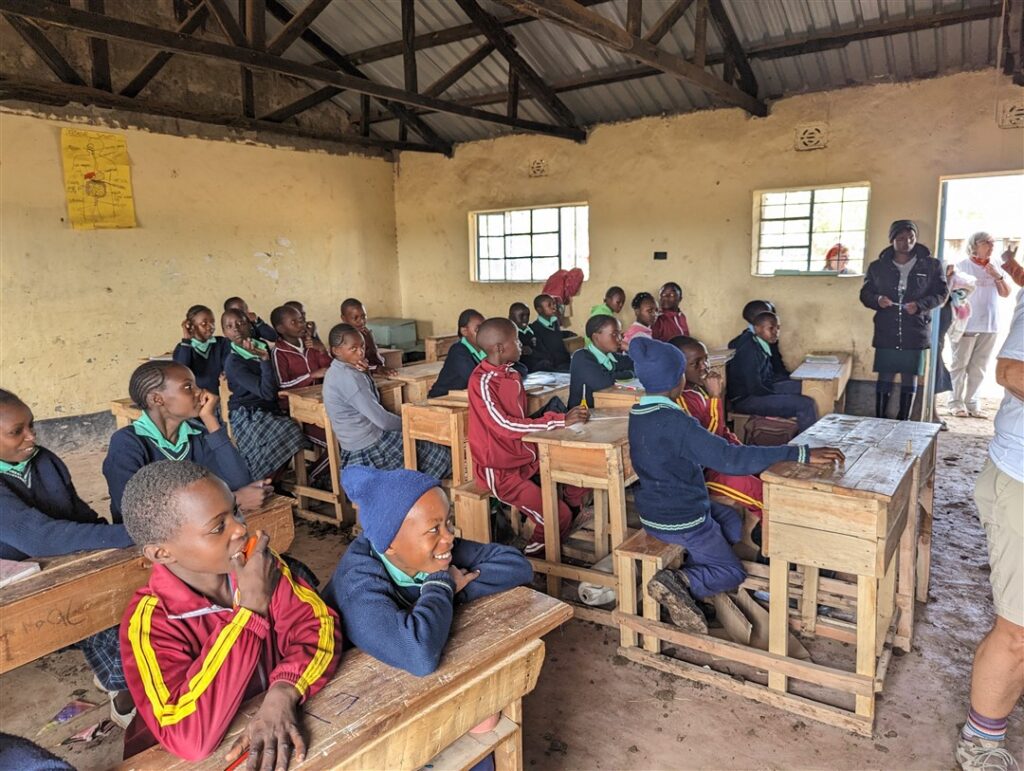
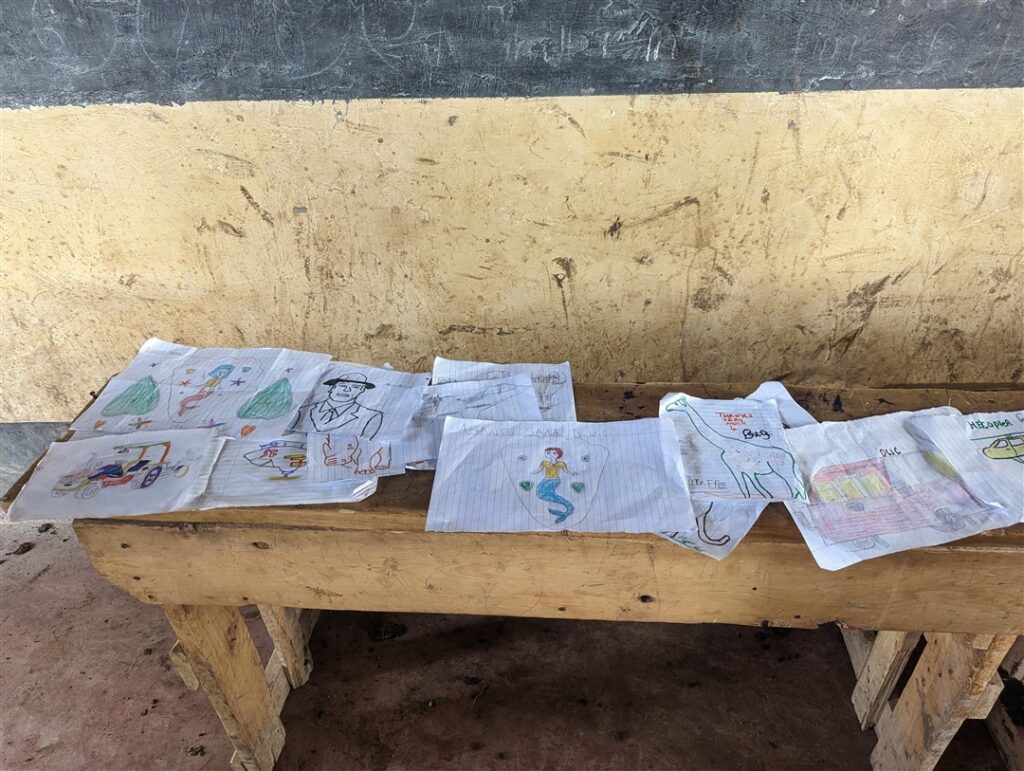
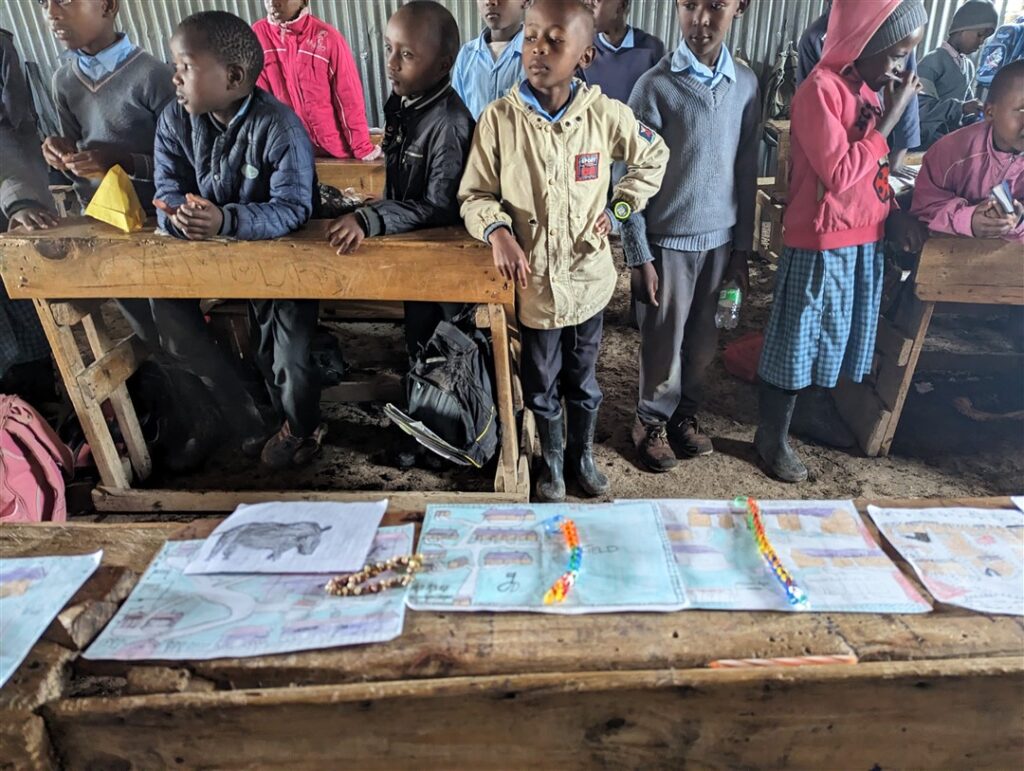
Clean-up went quickly. Mark had stayed at the work site to chisel slots and Charles was removing nails. The Headmaster asked for all of us to come to the table for a presentation and a couple of the teachers brought out a large cardboard box. Patrick, the Headmaster, said a few words of thanks and then we were each handed a dozen fresh, long-term roses. It wasn’t the most practical thank you gift for international travelers, but they were beautiful, fragrant, and well appreciated. I’m talking later, we decided to give one or two dozen to Patrick and Isaac, our drivers, to give to their wives as a gift when they returned from driving us around for two weeks. We’d give the remainder to the Longview Suites hotel in Nairobi.
The Headmaster asked who would like to see the classrooms and kids one last time, so about half of the group did that. I joined Mark chiseling slots while others worked with Charles. The Naro Moru side of the roof was completed and the rafter workers started installing the crown strip on the spring of the building while others worked parallel to Mark and me, installing windows and the door into the gaps and slots, shimming the frames with scrap wood pieces and then mortaring in the frame with the addition of stone shard and pieces in the larger gaps.
Simon and Peter were finishing the last gable slope as well. We saw Simon using a chisel to know our concrete on the corner of the front veranda slab and sked what he was doing. He said that they needed to break out a square of concrete about ten inches by tn inches in the front slab, with one in each corner and two other equally spaces spots in front where the support poles for the veranda would be set.
Mark and I couldn’t understand why they were doing this. We had seen the four rebar posts coming up from poured pedestals that were part of the front facing concrete sidewalk or veranda slab, but could not comprehend why they hadn’t just set forms around those spots when they poured the concrete rather than now breaking cures concrete by hand with hammers and chisels. For that matter, why didn’t they just set the veranda posts outside of the concrete slab and into soft earth? Like so many other parts of the project, it just seemed so poorly planned and thought through. As Mark said, “Why work smarter when you can work harder?” There seemed to be no rhyme or reason to why they’d set the rebar posts in the ground either. They were not going to be used. In Costa Rica, Carlos would’ve arc-welded the veranda posts to those posts in about ten minutes without the need for breaking concrete or digging and it would’ve been stronger, too.
I started breaking concrete with long, straight crowbar at two marked spots. After make preliminary cuts framing one, I was told they’d measured wrong and they moved me over by ten inches. I managed to break through the few inches of concrete and hit some plastic wrap and metal mesh. I though there was only dirt underneath, but then we discovered that they had set large block stones as a base and my ten inch square was over where two of these slabs met–they couldn’t be taken out entirely.
Becky and Bonnie helped with clearing some rubble around our work, but it seemed totally stupid and fruitless. Noon and lunch couldn’t come soon enough. We stopped at about 12:15. Mark finished his, but we just stopped on the other two. We’d leave that silly work for others.
Lunch was simple vegetables: Green Crumbs again, cabbage, and rice. We learned via Wikipedia that Green Crumbs are just mung beans. I liked them a lot and that was a fitting end to our lunches. When most of us were finished I asked John to bring the other cook over to the tent and we presented them with an envelope of tip money to split. We thanked them profusely for the great food and friendly service.
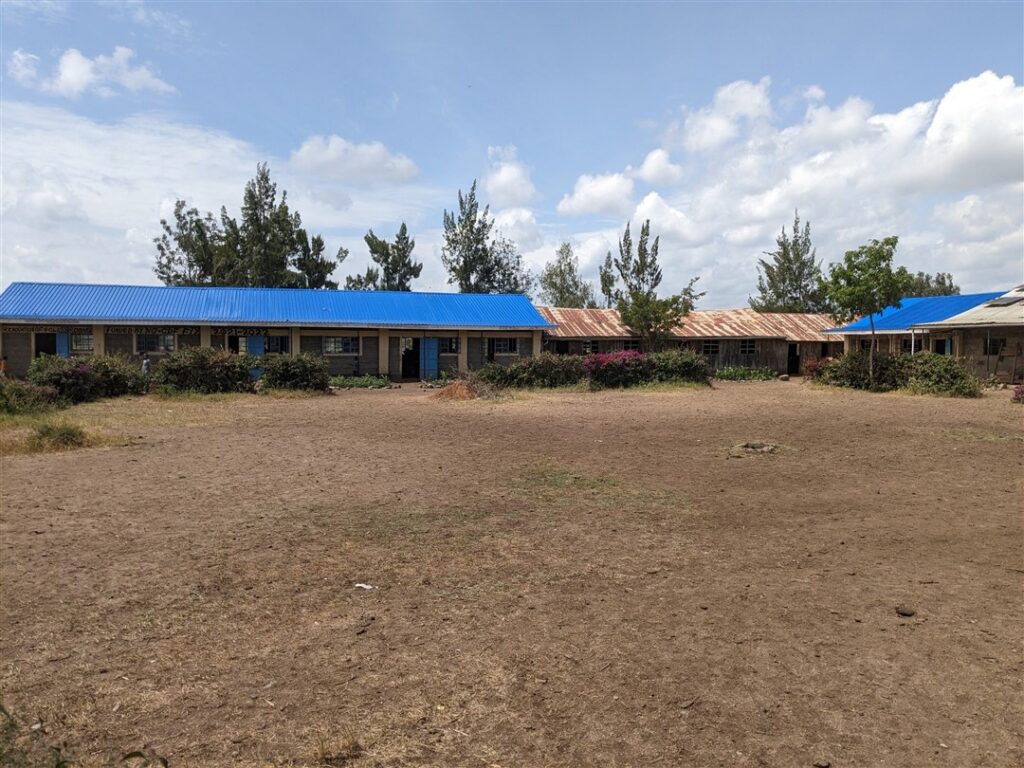
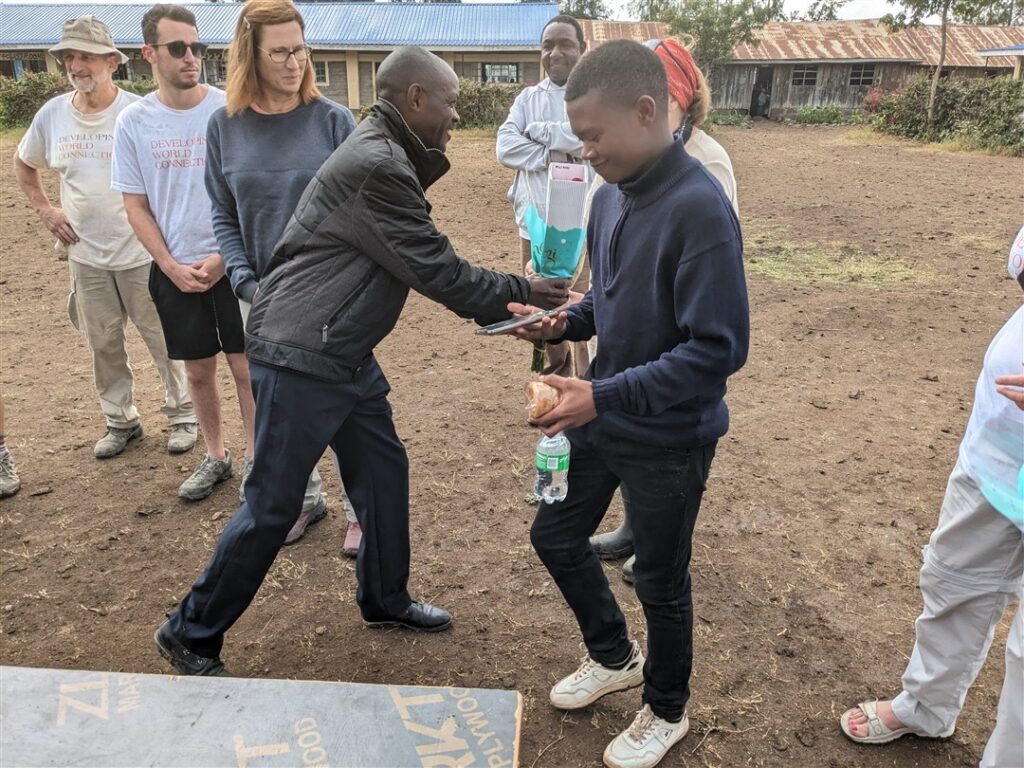

When we finished in the lunch tent we called everyone to the front of the school room for photos. While we waited on everyone to pack their things into the vans, I brought Simon over to the tree that shaded his motorcycle and took off my Keen waterproof hiking shoes and gave them to him. I told him that I wanted him to climb Mt Kenya with them and send me a photo of my boots on the top of the mountain. If I couldn’t climb it this time, I’d be content thaty shoes had. I also gave him a DWC T-shirt and two pairs of socks. I told him that we had some other things to share but that since this was more substantial, I wanted to do this away from the others. He also gave me his WhatsApp contact info and I sent him a test message to connect.
We returned to the big group where Becky had passed out a few other DWC T-shirts and all of our pairs of gloves. Other volunteers gave away similar work items. Then, we lined up for group photos in front of the building, starting with all of our co-workers, then just the volunteers, them with the Headmaster, next with Nderitu, Isaac, and Patrick. Patrick and the headmaster took many of the photos withy phone and did a good job of it.

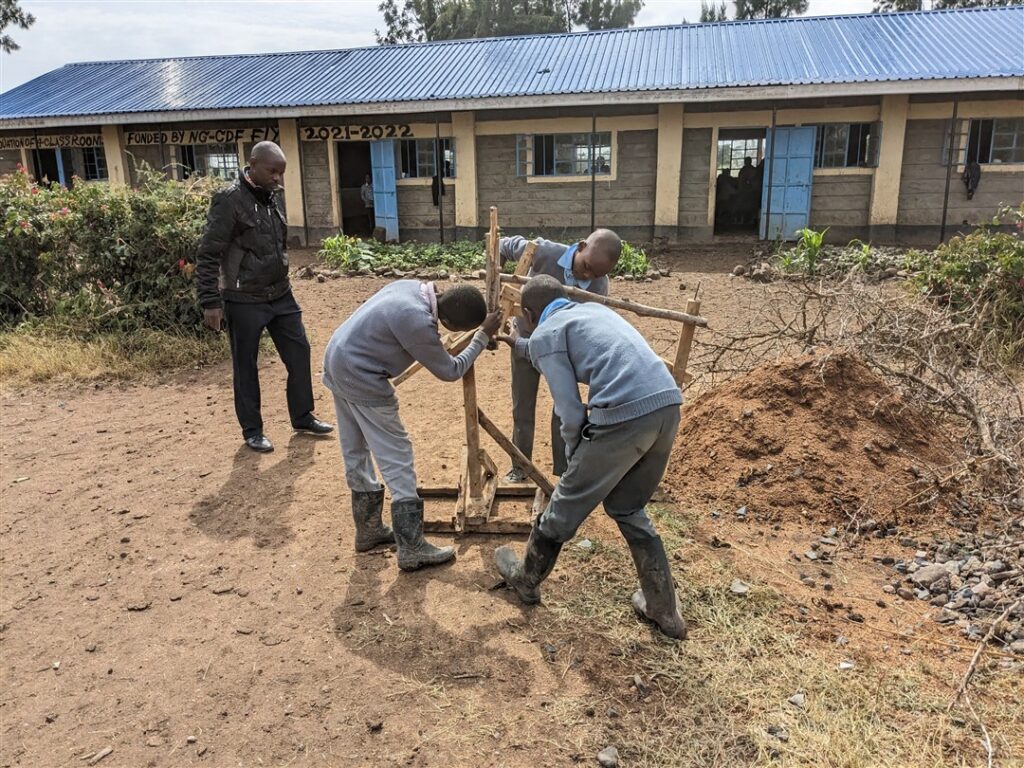
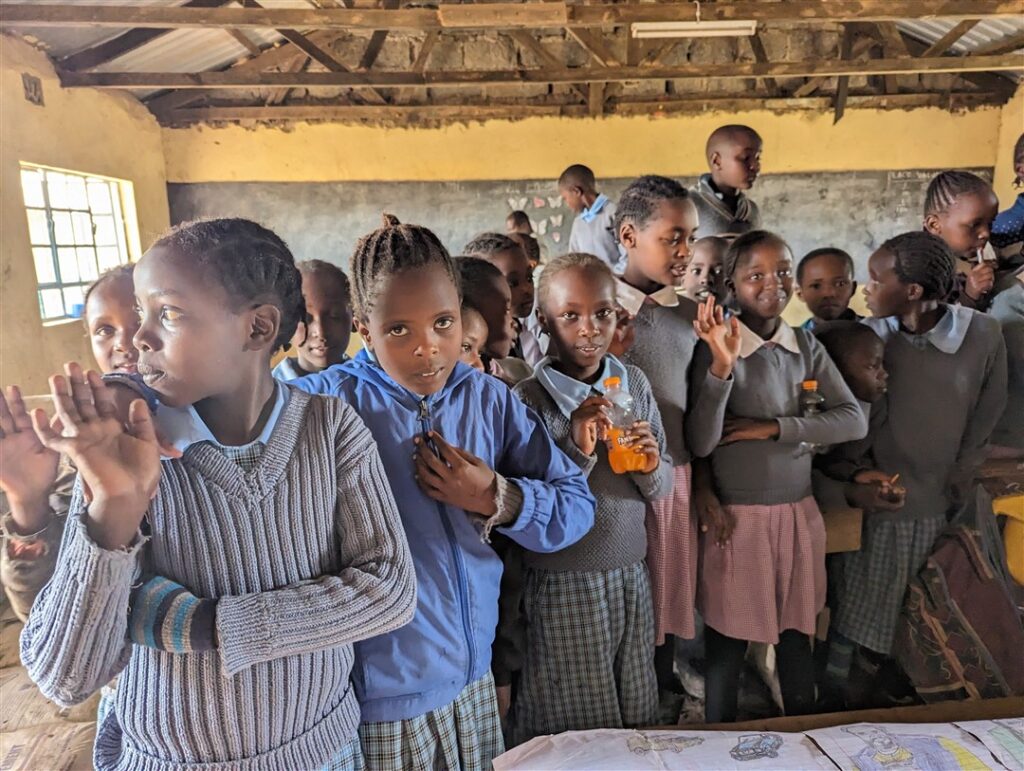
We finally left sometime after 1pm and started back to Nairobi. At one point in the morning, Nderitu thought that we would have to go back to the hotel because the hotel called him to say that several people had left things in our rooms. As it turned out, we had done exactly that, but it was intentional. Vicky left an extra pair of reading glasses, Margaret left some clothes,.and Becky and I left a water bottle, some snacks, and several pairs of socks. We polled everyone about what they’d left and realized that we didn’t need to return.
On the way to Nairobi, we did stop at the bakery and returned the plastic crates in which we’d transported the sweet cakes. Then, we were on the road. At 3pm, we stopped at the same souvenir shop and roadside rest stop as one our way out from Nairobi. Most used the rest rooms, while a few bought snacks and Margaret bought a few small gifts. We were back on the road by 3:25 and expected to be in Nairobi by 5:30, traffic permitting.
Along much if route there was construction. The Kenyan highway authority wa expanding the capacity of the rod to a fully divided four-lane highway.similar to an American interstate, though without the controlled access points. It seemed that there still would be umbrellaed road-side and median freelance sales of fresh produce, water, rice, and other staples, especially near towns and any any point with speed bump. It was like many little linear supermarkets with sometimes eight or ten consecutive people under their own umbrella all spelling exactly the same thing–or very close.
For now, very few stretches were four lane and most of the traffic was still two-lane and undivided on one side or the other depending upon the level of completion.
There never seemed to be a stretch of highway in which no one was walking alongside the road or in the median. Motorcycles and cars emerged from almost any stretch of flat ground including one motorbike that broke my personal observational record previously set in Vietnam (six) with a family of SEVEN on-board, all in line on the seat or gas tank.
Much like I’m Costa Rica, several of us noticed.how very few people smoked cigarettes during our visit. Of course, we wondered if this was based on public education or simply the high of a destructive luxury.in a relatively poor nation.
Like our other three road trips, this one back to Nairobi was taking MUCH longer than expected. Traffic started backing up in Jujan. By Riuru, we were only 40 km (25 miles) from the hotel, but Google Maps had us arriving at 5:55pm (over and hour from that point and almost five hours after we left the work site).
Every time traffic came to a crawling pace you could count on pedestrians along or I’m the road between lanes selling water bottles or snacks quickly exchanged for schillings as you drove by.
Becky passed the time reading, while I edited and posted photos and send messages and updates via WhatsApp, Insta, and Facebook, looking out the window as the landscape became more urban on our approach to Nairobi from the northwest. At one point, we saw a herd of about 50 white goats going up and over one of the pedestrian overpasses. Almost every open lot or field had cattle or goats grazing and, as we nearest the center of the city, Isaac brakes hard and just barely stopped short of hitting a wayward bovine casually walking across the highway.
We arrived at the hotel just before 6pm and checked in. All had single rooms except for Becky and me, but we were put into a single nonetheless. They found a double, but it wasn’t properly prepped and didn’t have towels, so we showered in our first room (it had two towels) and went to dinner. The key didn’t work in the double room either, so we decided to lock our things in the first room while we were at dinner and then return and move our bags to the double room (that was to be prepped) after dinner.
We left for dinner at The Carnivore Bar just after seven and looked forward to our last full meal together and a chance to treat Nderitu, Isaac, and Patrick. The restaurant was only about ten minutes away and part of a hotel and some shops. When we entered we were greeted by a huge, round, open grill pit with long sabers holding pierced meats and sausages above the hot coals. The meat menu showed about 20 items and had three “exotic meats,” ostrich meat balls, crocodile, and “ox balls.”
The place was very popular and appeared to be nearly full with about half of the clientele being what looked like white European tourists. We were led back to a table for 12 and took our seats while Isaac and Patrick parked the vans. Looking at the seated table, we realized that the only remaining seats were at one end, so we rearranged ourselves so that Nderitu, Patrick, and Isaac could be more mixed in with us for conversation purposes.
Our waiter came to explain the menu and said that we would be served a salad tray and bread first, but that everything after that would be meat brought out on sabers. We had a flag on the table and meat would continue to be served until the flag was turned on its side. He then introduced us to their signature cocktail maker who roamed around making rum-base ending called “Dawa.” Becky, Val, and Mark got one each and we also looked at the wine list. Val and Vicky wanted to pay for at least two bottles–one red and one white–tom compensate for the bottles purchased by Mark and us back at the Lusoi. Bonnie ordered one bottle of red and then sent it back because she didn’t like it. She ordered another bottle of the Shiraz that Vicky and Val bought.
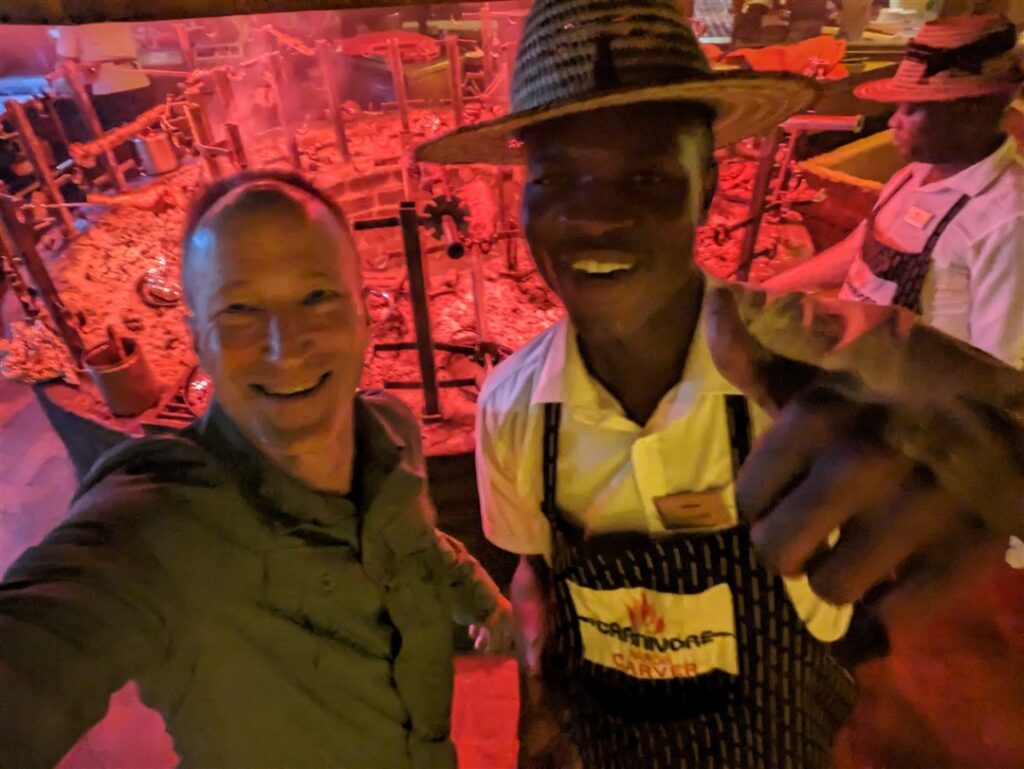

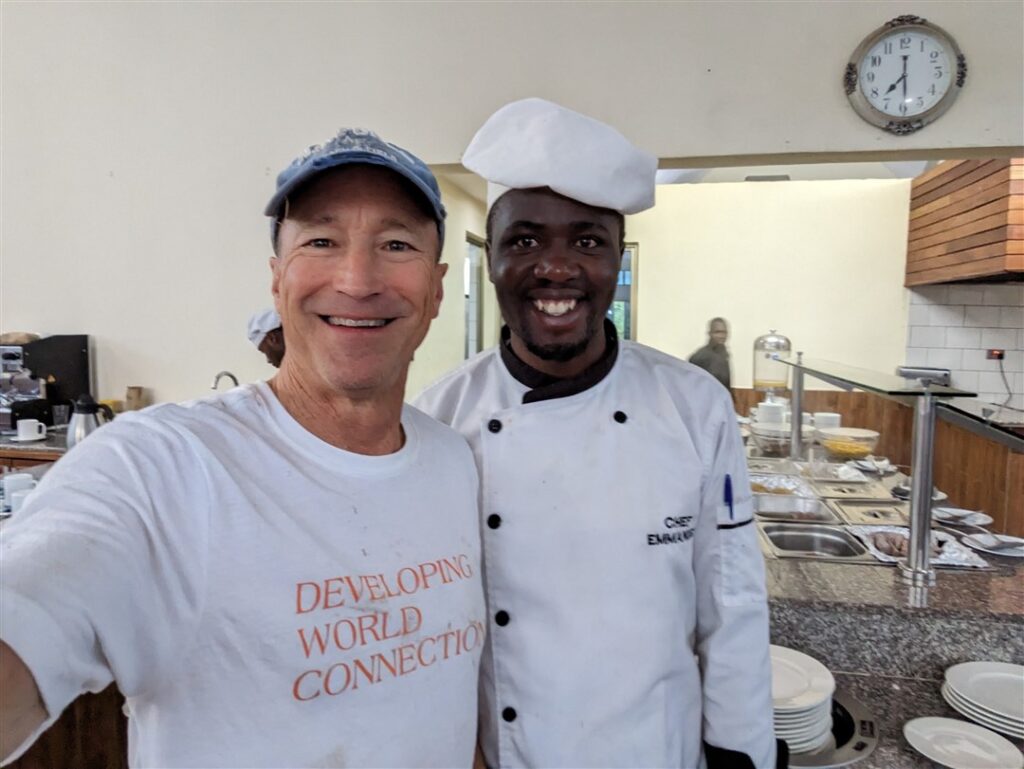
The meat came around frequently served like a Brazilian Steakhouse, e.g., Tucano’s, but with an African twist. We had pork ribs, roast beef, chicken breast, thighs, and wings, and then some roasted lamb, sausages, livers, gizzards, crocodile, a very nice white fish they called “kingfish,” and some very rare beef. The crocodile was a little chewy, but good. We had a tray of sauces on the table and the servers gave us recommendations on what sauces enhanced what meats.
We waited for the ostrich meat balls and some of us tasted the “ox balls,” or I guess they’d call them African Oysters. They were very white, light, tender, and didn’t have a particularly strong taste.
The ostrich was finally served and didn’t taste any different than a beef meet ball in my opinion.
The wine flowed easily and we really enjoyed the conversation. Isaac Sat to my left and Nderitu was opposite me. Diagonally at the other end of the table, Becky sat between Mark and Patrick. They seemed to be having a good time, but I could rarely catch their conversation.
Isaac told me about his high season driving and guide schedule that he said was full from now until November. He is 38, married, and has three kids, ages 12, 7, and three. His wife works part-time for the government and they have to juggle child care with the help of family when they’re both working. During the low season he does some odd jobs from clothing sales to taxi driving.
Near the end of the Nderitu made some very complimentary remarks about our team and how much we’d accomplished. He said that he’d been working with DWC since 2010 and hadn’t seen another group do nearly as much as we had. Others joined in with positive comments aboutnhim, Isaac, Patrick, and our co-workers. I chimed in with a criticism of Joel that was echoed by Isaac and Patrick as well as other volunteers. We told Nderitu that Joel was too much the “African Big Boss” that just gave orders, didn’t work unless a camera was turned on him, and didn’t seem like he was very good at planning or doing his job–as evidenced by the whole veranda pole debacle, watering the walls, repeated moving of dirt and scrap piles, and block chiseling. We didn’t think his work matched the energy, skills, and friendly nature of Simon, William, Peter, and our other co-workers. Nderitu told us that that was valuable feedback that he would pass along and consider for future groups.
We also talked about the hotel, giving them very positive marks for the quality of the rooms, laundry, food, and overall service. Low points included the very poor wifi and remote location not near any town or village. In the end, I think that we all agreed that the positives outweighed the negatives and some of the latter items (e.g., the wifi) could be improved by the time other groups returned.
I made some summary comments thanking everyone again and gave tip envelopes to Isaac and Patrick, which they very much appreciated. The tips were well-earned and in my opinion, appropriately generous.
We left the restaurant after settling the bill. I paid for the meals and water and the others split the bill for the alcoholic beverages. I was pleasantly surprised that the cost for the meals themselves was only 4000 KsH a piece or less than $30 US.
For this group, we were out late, not returning to hotel until after 10pm. When we got back to our room and started to move our things to our double room, we saw that nothing had been done. Our double room had no towels or water. I went to the front desk and finally got some help and two rather terse interchanges. I finally followed the reception agent to a closet and took the towels and water myself. The rest of the evening went well, otherwise, and we finished our repacking for the next day.
17 June 2023
We slept in until after 7am and, after showering, joined Margaret, Noah, Charles, and Mark at breakfast. I passed out feedback forms and then Sat for some coffee. The chef was making omelets to order and the coffee was excellent again.
Val and Bonnie came down a little later. Val said that Vicky wasn’t feeling well and would probably not be joining her, Noah, and Mark on their pre-departure day trip to the Nairobi National Museum. The servers gave her a plate of food to take back to Vicky’s room.
The next hour was occupied by departure preparations, baggage movement to the reception area and more thanks and goodbyes. Nderitu arrived to see us off and introduced Margaret, Becky, and me to James who would be driving us to the airport for our flight to Kigali.
We left promptly at 9am. Becky and I had once less bag (our duffel) than we had brought to Kenya, having given away two pairs of rubber boots, one pair of hiking shoes, many pairs of gloves, three T-shirts, a water bottle, and about a half-dozen pairs of socks.
The trip the airport went smoothly in the light Saturday morning traffic and the international terminal (1C) was nearly vacant. Check-in was smooth as were passing through immigration and security.
We were at our gate an hour early, so Margaret and Becky did some light shopping to spend remaining Kenyan schillings and pass the time. I reviewed receipts and caught up on my accounting for trip. I also sent copies of our passports to Capt Tony Gasana in Kigali at his request to facilitate our visit to the Rwanda Defense Forces Headquarters that would occur after our arrival.
The plane boarded a little late and we loaded by walking across the tarmac after descending stairs from the gate. Our plane would be a Rwandair Bombardier Q400 Next Gen with two seats on either side of the aisle. It was completely full.
Becky and Margaret Sat besides each other in 11A and 11B and I was across the aisle in 11C. In 11 D was a very large gentleman who completely spilled over (or took over) the armrest and thigh space. His elbow was two inches into my space the entire trip. He seemed to not at all get message when he moved a couple of times and I planned my right arm against my side of the armrest, only to have it pushed towards me. The whole flight was agony as I leaned into the aisle only to be smacked with the service cart and the flight attendants. Luckily, it was only and 80 minute flight.
As we landed it seemed that my row-mate might not be accustomed to flying as he gripped the seat in front of him (where a friend was sitting) and appeared visibly shaken. He relaxed when we landed, but when the plane stopped seemed to want to jump over me to get out. Most of the other passengers jumped into the aisle and starting grabbing their bags from the overhead, in many cases two air more rows behind or ahead of their seat. One guy almost clubbed Becky pulling his pack out as he leaned over her from the seat ahead to gradna back two rows back. I decided to just stand in the aisle and block all traffic.
We descended the plane and walked on the tarmac to a bus that brought us to the terminal.
Posted in Kenya on June 7, 2023



